Two Stories of Feminist Publishing ↓ ✕
Thesis↓ ✕
Publications ↓ ✕
This website presents a state of research, that will probably never be final, about independent feminist publishing in the Netherlands during Second-wave feminism. It gathers a few voices of women involved in the movement, regroup some of their productions, and strives to map their practices.
You can print the content of this website here.
Introduction -
Independent Feminist Publishing
This is no fairy tale. No dragons, knightly sword fights or grandiose castles up on the hill. And yet, the stories I am about to tell you are no less epic. They talk about love, hope and anger, the power of friendships, and the marvellous things that happen when people unite, gathered by the conviction that together, even through small gestures, they can make a change, they can make their voices and other’s a bit louder. They are the stories of some participants of the Women in Print Movement, told through their voices, and the traces they left in archives.
“A product of Second Wave feminism, the Women in Print Movement was an attempt by a group of allied practitioners to create an alternative communications circuit—a woman-centered network of readers and writers, editors, printers, publishers, distributors, and retailers through which ideas, objects, and practices flowed in a continuous and dynamic loop. The movement’s largest goals were nothing short of revolutionary: it aimed to capture women’s experiences and insights in durable—even beautiful—printed forms through a communications network free from patriarchal and capitalist control. By doing so, participants believed they would not only create a space of freedom for women, but would also and ultimately change the dominant world outside that space.” (Travis, 2008, p.276)
I told you it was going to be epic. But before jumping into our stories, let’s take a few steps back, and consider how such a revolutionary movement came into being.
Publishing is a political force. Barbara Greier, founder of Naiad Press puts forward the power and political implications of the publication: “We actually influence people’s lives because we do infect their minds with what we put on the printed page. And that’s extremely important. That is really the most important political tool I think there is.” (Young, 1997, as cited in Huisman, 2016) The publication holds potentials to foster, amplify and spread ideas, and by unfolding in the world, to inform, influence, criticise, persuade, manipulate. Conversely, it holds the power to exclude, erase and marginalise. Historically associated with the printed form, its accessibility is thus connected to the one of tools for production and diffusion: “Freedom of the press is guaranteed only to those who own one” (attributed to Liebling, 1990 as cited Dżułaj, 2020, sec. Cases: Provo and Raddraier). Those who own one, are also often “those in traditional positions of power [who] use those tools to engineer and control our defining narratives” (Soulellis, 2021a, sec. Intro), a privileged few who hold a monopoly, serving dominant discourses and maintaining power dynamics, determining—in a pre-internet era—what was (and maybe more importantly what was not) published, excluding minorities and dissident perspectives (Huisman, 2016, p.4). This motivated the creation of alternative and independent publishing practices, to spread ideas and information outside of state, institutional or religious control, but also outside of a restrictive mainstream industry. A mode of publishing characterised by its sense of urgency; responding to the absolute necessity to record, recount and inform in the present (Soulellis, 2021a, sec. Intro).
Alternative presses have played a significant role in major historical events like the French and American revolutions, or the clandestine communication networks of former communist countries, by facilitating the dissemination of influential ideas and information through self-publishing. Take Thomas Paine’s anonymously published pamphlet, Common Sense, an “underground bestseller” (Ludovico, 2012, pp.32) with hundreds of thousands of copies put in circulation which provided the intellectual spark that ignited the uprising during the American Revolution.
The history of alternative presses in intimately tied with the one of the evolution technologies, a relationship remarkably detailed in Alessandro Ludovico’s book Post-digital Print, particularly in a chapter titled A history of alternative publishing reflecting the evolution of print, from which the following examples are extracted. To overcome the lack of means and access to mass production tools, alternative presses proved to be masters of diversion and repurposing, from the utilization wood-block printing in pre-Gutenberg times (Biblia Pauperum), to the use of manual reproduction techniques (such as the typewriter or small hand presses, see samizdat), or of tools initially intended for offices or administrations (such as the mimeograph, or later on Xerox photocopiers and Risograph printers). Alternative presses reached a peak in the 1960s, with the surge of various underground movements paralleled by the increasing affordability of printing techniques such as screen printing or small offset presses (Furter, 2017, p.22).
Now, let’s get back to our stories. What later became known as the Women in Print Movement forms part of this lineage. Being a group marginalised by traditional publishing, women had to come up with a variety of strategies to jump over the fences of this gatekept industry. Many women writers have, for instance, used male or gender-neutral pen names to overcome gender-based discrimination and biases prevailing in the literary world, to have their work taken more seriously and published. Publishing under a male or gender-neutral name allowed these women writers to be judged solely on the quality of their writing, rather than being discriminated against based on their gender. Particularly common in the 19th century, it also allowed them to write about topics that were then considered inappropriate for women, such as politics, sexuality, and social issues. A few famous examples are the Bronte sisters/Currer, Ellis, and Acton Bell, Amantine Lucile Aurore Dupin/George Sand, Mary Ann Evans/George Eliott, Louisa May Alcott/A.M. Barnard, Violet Paget/Veron Lee, Alice Mary Norton/Andre Norton, Karen Blixen/ Isak Dinesen, Alice Sheldon/James Tiptree Jr, or more recently Meg Howrey and Christina Lynch/Magnus Flyte. Penguin publisher issued in 2020 a collection called ‘Reclaim Her Name’, gathering texts from influential pen-named women in literature. A stratagem that has proven to be effective, but which circumvent the gate more than it strives to dismantle it. For that, it will take the strong currents of second wave feminism, pushing women to create their own communications channels. At the end of the 1960’s women’s periodicals, printers, publishing houses and bookstores flourished. Women took control of the production and distribution means, gaining autonomy at each step of the publishing process, from the production of content to its distribution. It allowed them to disseminate independently information and cultural productions related to the women’s movement, while re-imagining relations, organization, and work outside of a patriarchal and capitalist framework, In Rolling Our Own: Women as Printers, Publishers and Distributors, Eileen Cadman, Gail Chester and Agnès Pivot underline how “Feminist publishing, more than any other aspect of the book production process, seems to epitomise most clearly the problems and choices which face feminists confronted with a society which is both patriarchal and capitalistic, in order to go about the business of disseminating feminist ideas.” (Cadman et al., 1981 as cited in Jolly, 2020) in pursuit of a more inclusive and sustainable model (Travis, 2008, p.278). A variety of approaches, organizational systems, demands and conceptions of feminism were carried and tested by its participants, making the movement a heterogenous and organic blob of ideas and practices rather than a homogenous single-voiced block (van Vught, 2020, p.30).
But if our protagonists are all very different characters, with very different stories, what connects them is the abnegation, boundless energy, unconditional love and care they put in activities that, they firmly believed (well, okay, with some surfacing doubts, despondency, and existential crises, they are still human after all), could change the world in which they live for the better. And even had they failed; at least they would have tried, at least they would have showed that something else is possible, at least they would not have been alone anymore, at least they would have found something on the way. Because initiating a fight against a way scarier and powerful beast than your typical fairy tale’s dragons—the ruthless matrix of domination (capitalism-colonialism-heteropatriarchy-white supremacy)(Collins, 1990) —comes with its share of obstacles, disenchantments, and difficulties. A task all the more daunting for women who were simultaneously confronted with intersecting (Crenshaw, 1989, pp.57–80) axes of this matrix, and who had to fight for the recognition of their identities, ideas, and practices even within the feminist movement (Huisman, 2016, p.3).
And yet, many of those remarkable stories remained in the shadows, obscured by the same conditions that brought them into being. If they have been the subject of a growing interest for the past few years, they are still widely under-studied and under-narrated (Travis, 2008; Van Vught, 2020), a precious legacy sleeping in a few people’s memories and archival boxes. Some never even made it there: “the matrix of domination produces particular burdens and privileges that determine who gets to succeed. As well as who doesn’t—who isn’t included, who isn’t collected in the archive, who is not written into history” (Soulellis, 2021b). What is made available in archives is a selection, a sample usually not representative of the full scope of movements and stories, but rather of the dynamics of domination shaping histor(y)ies. What is made available in archives is a selection, a sample usually not representative of the full scope of movements and history. In this respect, there are two key parameters to consider. First, Feminist and social archives rely mostly on personal donations. For the Women in Print Movement, the collections often consist of personal archives donated by individuals and organizations who participated in the movement. A wide range of reasons may lead participants to keep their archives, such as the emotional or personal aspect of its content. The good preservation of the material is another factor, since a large part of the production consisted of ephemera (printed materials of ephemeral nature, such as newsletters, journals, or pamphlets) which were particularly fragile as they had an instantaneous vocation, the question of their archiving coming decades later. Second, archives are institutions with collection policies, including specific selection criteria regarding what get in and what does not. These policies are sometimes explicit, but often opaque, as it is the case for many online archives. As Paul Soulellis’ quote suggests, these policies often reproduce (even unconsciously) intersecting dynamics of domination represented in Patricia Collins’ matrix of domination (1990). The question of what is missing is still partly unanswered, and hopefully future research and donations will enable a more accurate and complete picture of the movement.
As a woman navigating the art and design world and education, as a designer interested in editorial and publishing practices, these stories greatly helped me to situate myself and find agency in a discipline where I don’t feel I belong, but also to imagine how the tools of design and publishing can serve more equal, emancipatory, and sustainable prospects. They feel urgent to recount and reactivate in a contemporary context—which unfortunately has not rid itself of the dynamics of dominance mentioned before—and in the outlook of a future that promises to be no less rich in crises and challenges.
To ensure that these stories are not lost to future researchers, designers, book lovers, this is an attempt to shed some light on a few of them and on the people who laboriously try to stich back a few pieces of this patchworked History to start constituting a more inclusive book Herstory. The little square I aim to bring to this patchwork will focus on the Women in Print Movement in the Netherlands, The choice to focus on the Dutch scene is mainly practical; to have access to primary sources, to be able to contact and exchange with people who were involved in the Women in Print Movement, but also and to restrict the scope of this research, since time and word count were limited. through stories that have been shared by some of its participants, and the endeavours of researchers and designers who also work on their little squares.
I thank them all for their time, generosity, and enthusiasm. Rymke Wiersma, Weia Reinboud, and Pamela Pattynama, for sharing their stories, intimately connected to the ones of their lives, with all the emotional aspects, tears, laughs and hopes that are part of it. Loraine Furter, for being such an inspiring designer and researcher, who warmly and caringly shared many resources, ideas, encouragements, and long conversations with me. Inge Frank van Vught, for their fantastic research on Atalanta and the Women in Print Movement in the Netherlands (Van Vught, 2020) without which this thesis could not exist, and to have discussed openly and at length the doubts, difficulties, joys that comes with such a work. Susana Caravalho, for her great reading list and feedback, which, for the first time in my studies, proposed a different vision of design and introduced its potentials for empowerment and change. The archivists at Atria Atria, institute on gender equality and women’s history, Amsterdam, is a public documentation center dedicated to women’s history. It was created in 2935 and was previously International Information Centre and Archive for the Women’s Movement (IIAV) (1988-2009) and Aletta, Institute for Women’s History (2009-2013). (Atria, Instituut Voor Emancipatie, Vrouwengeschiedenis En Gendergelijkheid, n.d.) and IHLIA IHLIA LGBTI Heritage, is an independent organization located in the building OBA Oosterdok in Amsterdam. The archive focuses on LGBTI-related themes, “with regard to the lives of individuals and the LGBTI community in order to contribute to a balanced image of the entire society and to social well-being”. (IHLIA – LGBTI Heritage, n.d.) for caring about, maintaining the state of, and rendering accessible all the precious archival material that made this thesis possible.
1Barbara Greier, founder of Naiad Press puts forward the power and political implications of the publication: “We actually influence people’s lives because we do infect their minds with what we put on the printed page. And that’s extremely important. That is really the most important political tool I think there is.” (Young, 1997, as cited in Huisman, 2016) 2Publishing under a male or gender-neutral name allowed these women writers to be judged solely on the quality of their writing, rather than being discriminated against based on their gender. Particularly common in the 19th century, it also allowed them to write about topics that were then considered inappropriate for women, such as politics, sexuality, and social issues. A few famous examples are the Bronte sisters/Currer, Ellis, and Acton Bell, Amantine Lucile Aurore Dupin/George Sand, Mary Ann Evans/George Eliott, Louisa May Alcott/A.M. Barnard, Violet Paget/Veron Lee, Alice Mary Norton/Andre Norton, Karen Blixen/ Isak Dinesen, Alice Sheldon/James Tiptree Jr, or more recently Meg Howrey and Christina Lynch/Magnus Flyte. Penguin publisher issued in 2020 a collection called ‘Reclaim Her Name’, gathering texts from influential pen-named women in literature. 3In Rolling Our Own: Women as Printers, Publishers and Distributors, Eileen Cadman, Gail Chester and Agnès Pivot underline how “Feminist publishing, more than any other aspect of the book production process, seems to epitomise most clearly the problems and choices which face feminists confronted with a society which is both patriarchal and capitalistic, in order to go about the business of disseminating feminist ideas.” (Cadman et al., 1981 as cited in Jolly, 2020) 4What is made available in archives is a selection, a sample usually not representative of the full scope of movements and history. In this respect, there are two key parameters to consider. First, Feminist and social archives rely mostly on personal donations. For the Women in Print Movement, the collections often consist of personal archives donated by individuals and organizations who participated in the movement. A wide range of reasons may lead participants to keep their archives, such as the emotional or personal aspect of its content. The good preservation of the material is another factor, since a large part of the production consisted of ephemera (printed materials of ephemeral nature, such as newsletters, journals, or pamphlets) which were particularly fragile as they had an instantaneous vocation, the question of their archiving coming decades later. Second, archives are institutions with collection policies, including specific selection criteria regarding what get in and what does not. These policies are sometimes explicit, but often opaque, as it is the case for many online archives. As Paul Soulellis’ quote suggests, these policies often reproduce (even unconsciously) intersecting dynamics of domination represented in Patricia Collins’ matrix of domination (1990). The question of what is missing is still partly unanswered, and hopefully future research and donations will enable a more accurate and complete picture of the movement. 5The choice to focus on the Dutch scene is mainly practical; to have access to primary sources, to be able to contact and exchange with people who were involved in the Women in Print Movement, but also and to restrict the scope of this research, since time and word count were limited. 6Atria, institute on gender equality and women’s history, Amsterdam, is a public documentation center dedicated to women’s history. It was created in 2935 and was previously International Information Centre and Archive for the Women’s Movement (IIAV) (1988-2009) and Aletta, Institute for Women’s History (2009-2013). (Atria, Instituut Voor Emancipatie, Vrouwengeschiedenis En Gendergelijkheid, n.d.) 7IHLIA LGBTI Heritage, is an independent organization located in the building OBA Oosterdok in Amsterdam. The archive focuses on LGBTI-related themes, “with regard to the lives of individuals and the LGBTI community in order to contribute to a balanced image of the entire society and to social well-being”. (IHLIA – LGBTI Heritage, n.d.)Pamela Pattynamma —
Dreaming of an Island
This chapter is in parts an excerpt from an interview
with Pamela Pattynama, that took place on January 17th, 2023,
in Amsterdam, all the parts in italics are her words. They are completed
by external sources and references.
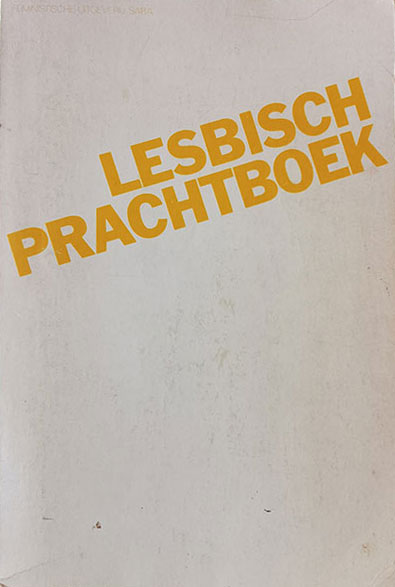
Lesbich Prachtboek, Maaike Meijer ... [et al.], Sara, 1979 - 365 p., IHLIA LGBTI Heritage collections
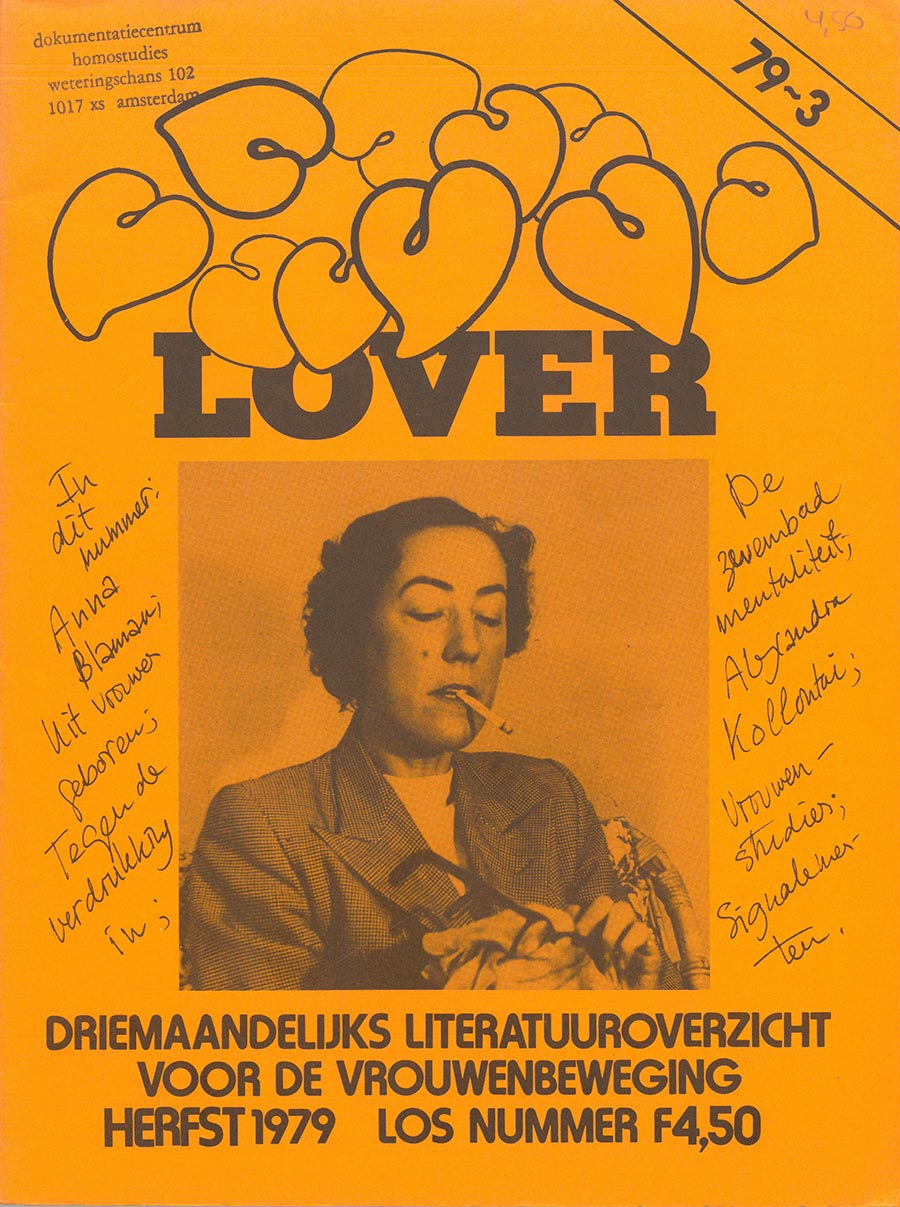
Lover 1979-3, IHLIA LGBTI Heritage collection
Pamela Pattynama lives in a house with a lot of stairs, and a lot of books. She showed me a few of them; the ones she, and her friends, made during the seventies and eighties. She smiles softly as her fingers flick the pages, and her face lightens up when she talks about them. It was very exciting times; I am happy to have participated in that. She was part of the publishing house De Bonte Was for a short period, participated in the creation of the feminist bookshop Xantippe in Amsterdam, worked as an editor for the magazine Lover for several years, and, it seems, hung out for long hours at café Saarein. We talked about the power of writing, friendships, community-making, and a dreamt island where women could re-imagine their world.
Writing had always been a part of Pamela’s life, long before any of this began. Through her words, she clarifies her thoughts, finds herself, finds her place in the world. Writing is political, but it’s also very personal and emotional. It has always been my way to be active. To write is to not be alone anymore, to recognise oneself and others, in all that connects and differentiates us. Writing, sharing experiences becomes a way to build common grounds and to understand the multi-faceted nature of women’s lives. For me, and for other women generally, I think writing allows you to be more self-confident, you get a better self-esteem and gain insight into the roles people play, the ones women play towards and against each other. But finding the time, support, space, and agency to write constitutes a first and major obstacle for women to publish and spread their words. Not everyone has “money and a room of their own; In A Room of One’s Own, an essay derived from two lectures Woolf gave in 1928 at Newnham and Girton College (both women’s colleges at the University of Cambridge), she addresses the condition of women—more particularly of women artists — whose creativity and free expression have been repressed by centuries of financial and educational prejudice; as illustrates her now famous sentence: “a woman must have money and a room of her own if she is to write fiction.” (Woolf, 1935, p.5) Gloria Anzaldúa, in Speaking in Tongues: A Letter to Third World Women Writer, calls on the “mujeres de color, companions in writing” (Anzaldúa, 1983, p.165) to not wait for it to start writing:
“Forget the room of one’s own—write in the kitchen, lock yourself up in the bathroom. Write on the bus or the welfare line, on the job or during meals, between sleeping or waking. I write while sitting on the john. No long stretches at the typewriter unless you’re wealthy or have a patron—you may not even own a typewriter. While you wash the floor or clothes listen to the words chanting in your body. When you’re depressed, angry, hurt, when compassion and love possess you. When you cannot help but write.” (Anzaldúa, 1983, p.170) This beautiful quotation was shared by Loraine Furter, who came across it during her own research.
A sense of urgency which led some women to unite their forces to push the walls and create their room of one’s own themselves. Collectivity—making together—was crucial in the women in print movement, including in the production of content. Various books, pamphlets, newspapers and articles were written collectively, sometimes under a unique signature. In the series of books published by De Bonte Was—even if based on individual experiences—the texts are written using the plural “we”, emphasizing the commonalities in women’s struggle. It also allowed women with varying writing experience to work together and strengthen each other’s individual voices. In an advertisement issued in various feminist periodicals, the Groningen literary magazine Belletrien (published by VIDA), encourages women to start writing “Women have always written. Women write. Women will continue to write. Pick up the pen.” Another striking instance of collective writing is the series of “lesbian pulp novels” titled Wilden Rosen, written together by the four women of the Groningen based Damesschrijfbrigade Dorcas in 1979. (Van Vught, 2020, pp.42-43; [Advertisement for Belletrien, magazine of literature], n.d) This need to write inspired a group of eight feminists to create, under the impetus of Anneke van Baalen, Annemarie Behrens, Akke van der Meer and Greet Vooren (Ekelschot, 2005, sec. De Bonte Was) the publishing house De Bonte Was, at the end of the 1970’s. Actually, no, in the beginning [of the 1970’s]. I am really bad with dates (laughs). They settled in the attic of the Amsterdam Vrouwenhuis, where they invited others to write about their experiences as housewives, mothers, lovers, women. A series of five small books emerged from this experiment. Short texts, deliberately written in a clear and understandable way, in which women were encouraged to express themselves openly.
“That was liberating for them, but also for the readers. The books were a huge success. This was evident from the sales, but also from the hundreds of registrations for the discussion weekends to which we invited the readers. Women came from all over the country to talk about the content of the books and their own lives, and thus break through the suffocation of isolation and self-hatred.” The weekends were held on March 15th and 16th and April 19th and 20th, 1975. Translation mine. (Ekelschot, 2005, sec. De Bonte Was)
What they represented, their mere existence, was radical and new. At that time, it felt urgent for women to speak out and talk from a personal level. It was not only political in a general way, but it was also very individual, private as well. (…) Before that, women as a collective, it didn’t exist, we were isolated from each other’s. So, it was radical at the time to talk about our experiences, and from there imagine all sort of actions and initiatives. We had women’s weekends, which soon became lesbian weekends. That was radical too, because lesbians didn’t have any kind of collective group or joined action either.
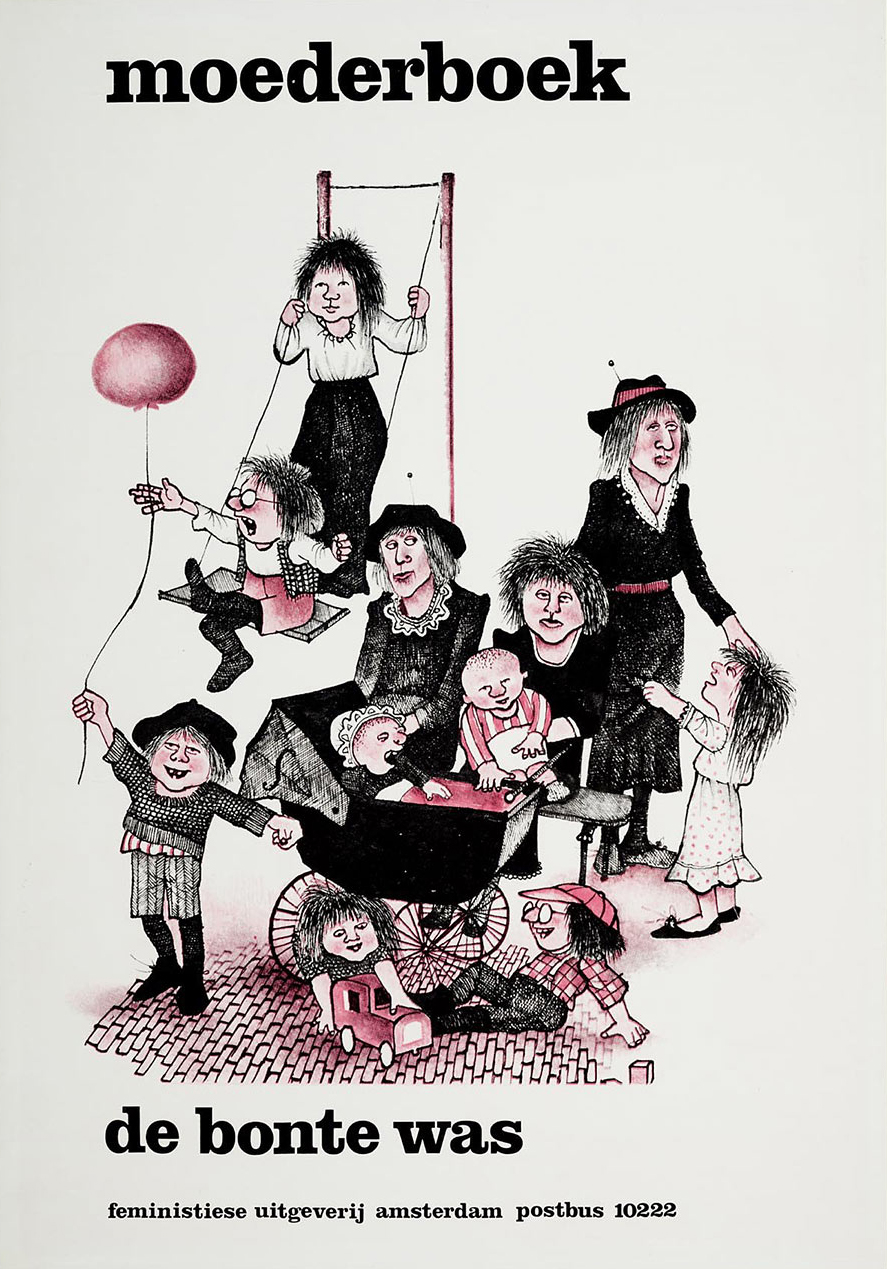
Announcement of the publication Moederboek by Feministiese uitgeverij de Bonte Was, 1976, Atria, A417 [poster]
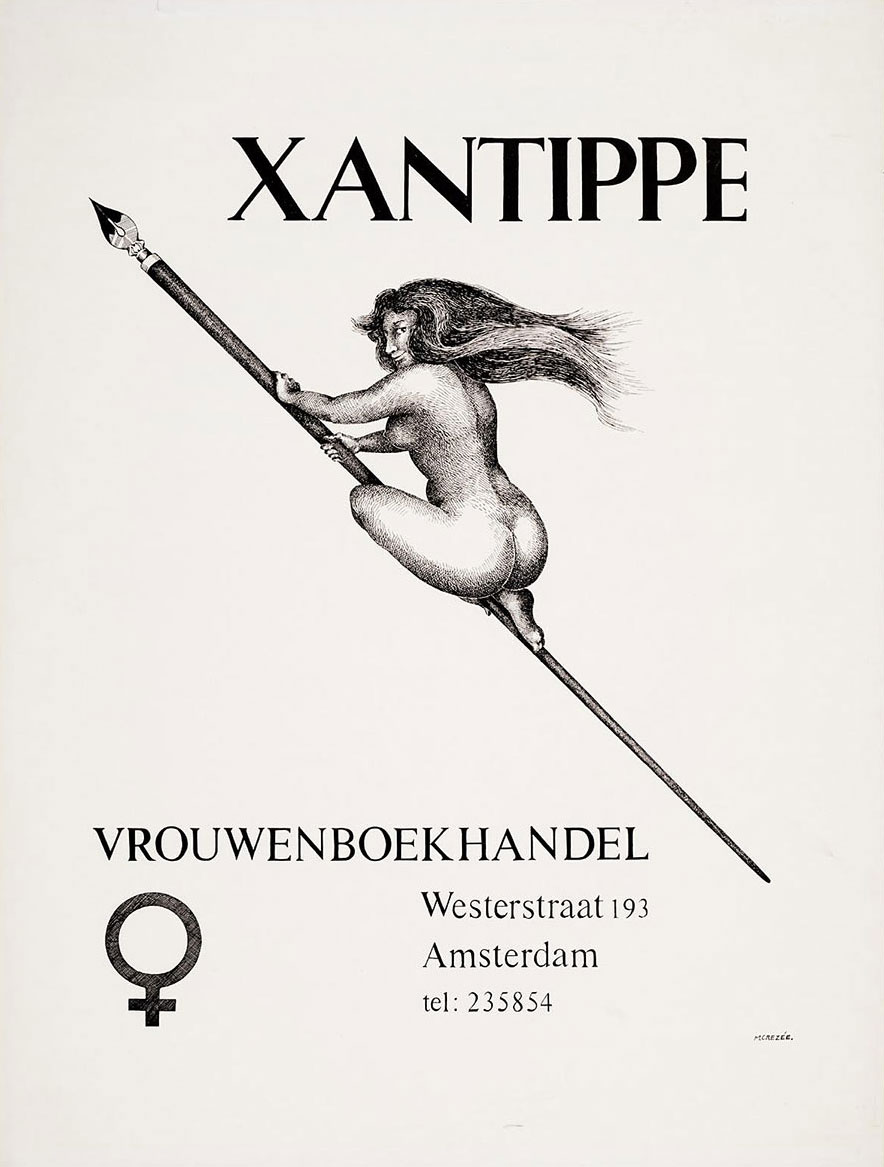
Advertisement for women’s bookshop Xantippe at Westerstraat 193 in Amsterdam, Crezee, M., Atria, A404 [poster]
In publishing, feminists gradually took control of the means of production and distribution, creating autonomous and semi-autonomous networks (Huisman, 2016). In 1975, Pamela, with four other women (Annemarie Behrens, Carla Brünott, Cris van der Hoek, and Sjuul Tegelaar) founded Xantippe, the second women’s bookshop in the Netherlands (Archief Xantippe Vrouwenboekwinkel 1975-1997 [Geschiedenis], n.d.). Their aim was to promote radical feminism through the diffusion of books and magazines; we couldn’t find any collection of women’s books. There were, of course, women authors, but they were scrambled between a lot of male authors. And there were no feminist books in the traditional bookshops. So, we made our own! In June 1976, after many discussions regarding the selection of books Xantippe would offer, the bookshop finally opened its doors at its first address: Westerstraat 193, Amsterdam. They sold their own books, like Sjuul, who distributed her absurdist, photocopied, very funny booklets, with all sorts of drawings, but also publications from other feminist initiatives, as well as international literature. Some of them were produced within the feminist circles, others using the mainstream production and diffusion networks. There were a lot of discussions about how to be as autonomous as we could, and at the same time, how can we make use of them [the mainstream production and publication networks]? There were feminist printers and publishers, but a lot of the books were made in conventional, capitalist publishing houses. The international books for instance came mainly via the traditional channels. This mixed approach would evolve through time, with the movement gaining momentum and demand increasing. “The first two books [published by De Bonte Was] were typed and mimeographed. Later, we reprinted and produced the books with an offset printer. From 1977 we also outsourced the typesetting, and a few years later the distribution.” (Ekelschot, 2005, sec. De Bonte Was, Translation mine)
Xantippe was run by a small collective of volunteers, and each person
worked one day a week. I did the Tuesday. Sometimes, the bookshop
was closed because no one was there to open, ‘Yeah, sorry, I drank too
much last night’. Some of us were very strict and some of us way less
(laughs). Money quickly became one of the central topics of
discussion. Some women wanted to be paid. And some were radically
against payments, because that made you a capitalist. These
discussions were not confined to the bookshop, and were shared in many
other initiatives. The absence of commercial interests allowed for a
certain freedom, as each decision could be made for ideological rather
than economic reasons. “We worked at De Bonte Was voluntarily, in order
to have the freedom to publish what we wanted and not what the market
was waiting for. A pleasant consequence of this was that the books were
cheap, so women who had less money could buy them too” (Ekelschot,
2005, sec. De Bonte Was, Translation mine). Proceeds were usually
used to buy equipment, books, materials or to rent facilities. It is to be noted that most feminist initiatives were
relying on squatting, a practice less common since the Dutch squatting
ban of 2010. Women had to earn money elsewhere,
some of them were working odd jobs, but most relied on governmental
subsidies. “The age range at De Bonte Was was between 19 and 60. We
all earned money quite differently: as a midwife, police officer,
divorced woman with six children, scientific assistant, student, etc.”
(Ekelschot, 2005, De Bonte Was). Many participants of the movement were
students and received governmental grants. Other women had unemployment
benefits or were working in various sectors. The quasi-absence of
financial compensation for activities that were extremely
labour-intensive also meant that some women could not engage in such
work for monetary reasons.
Almost all the archives I consulted from printers, publishers and
periodicals included subsidies applications, to both public and private
organisations. Some initiatives however, like Atalanta, were reluctant
to request them, for ideological reasons and to preserve complete
freedom of creation “Applying for a subsidy was not really something
that was considered by anarcha-feminists; no way, we liked to stay out
of the grip of the government, using our benefits as a basic income. (…)
We consciously choose to work without subsidy, i.e. without concessions,
without control from outside.” (Van Vught, pp.61-62)
These reflections are shared by other feminists, as evidenced by the
creation in 1983 of Mama Cash, the “the world’s first international,
independent women’s finance fund”, imagined by Marjan Sax, Dorelies
Kraakman, Tania Leon, Patti Slegers and Lida van den Broek, it aimed to
“launch innovative activities and to support initiatives that the
government would not”. (Archief Mama Cash 1982-2002
[Geschiedenis], n.d.)
Various feminist initiatives and organizations were blossoming, creating a revolutionary and diverse landscape. The desire to create a space of freedom for themselves, but also to challenge the dominant dynamics outside of it was a powerful driving force of the movement (Travis, 2008, p.276). What gave us power is the will to change the society, our situation, the way people look at us. It was a very ambitious strive to change, which was inseparable from the social situation and political situation. Informed by other socio-political movements, such as the gay, Black, anti-fascist or anti-authoritarian movements, the feminist movement, far from being as linear and uniform as the image of the wave may suggest, is in fact characterised by its multivocality, and the variety of groups and ideas expressed within them (Van Vught, 2020, p.17). We knew each other’s, sometimes we were friends, sometimes we had meetings together. They were often very chaotic, those meetings. We all had different aims, and different conceptions and ideas about how the movement should go on, or what action was necessary. Those discussions, as difficult as they could get, also allowed to challenge the dominance of some group of women within the movement. Critiques of a mostly white, heterosexual, secular feminism were brought about by various groups of Black, lesbian, working class, migrant and refugee women (Huisman, 2016, p.3). Sexism started to be understood as intertwined with race, sexuality, class and religion, and women who were not represented in the movement organised themselves to create their own practices and initiatives (De Vries, 2016). The Black women had their own groups, and I was in a white group. I’m mixed, my parents come from Indonesia, but my foremothers and fathers were either white, Asian or Black. When the Black women began their groups and their actions, it was an eye-opener for me. It made me think about myself, my ethnicity, my upbringing and what was the difference between me and my white friends. I’m really grateful for those early Black feminists. (…) Lesbian women also initiated discussions about our place in the feminist movement, as the talks and actions were always against men, or about marriage, having children and so on. So we made a separate group, and we called ourselves feminist radical lesbians.
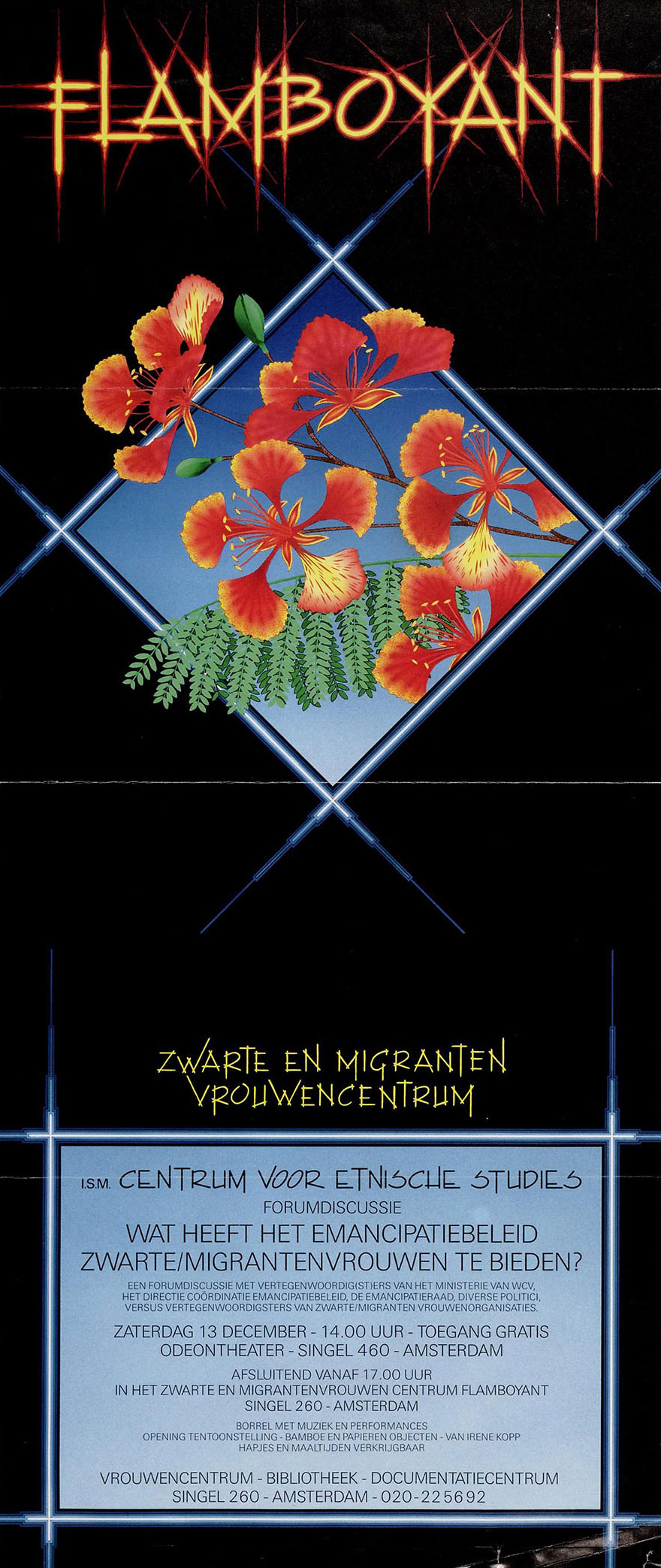
In 1986, Black women in Amsterdam founded Flamboyant, a meeting center with a library and documentation for and about black and migrant women. On December 13, Flamboyant, in collaboration with the Center for Ethnic Studies, is organizing a forum discussion about what emancipation policy can offer Black and migrant women, 1986, Atria, A1027 [poster]
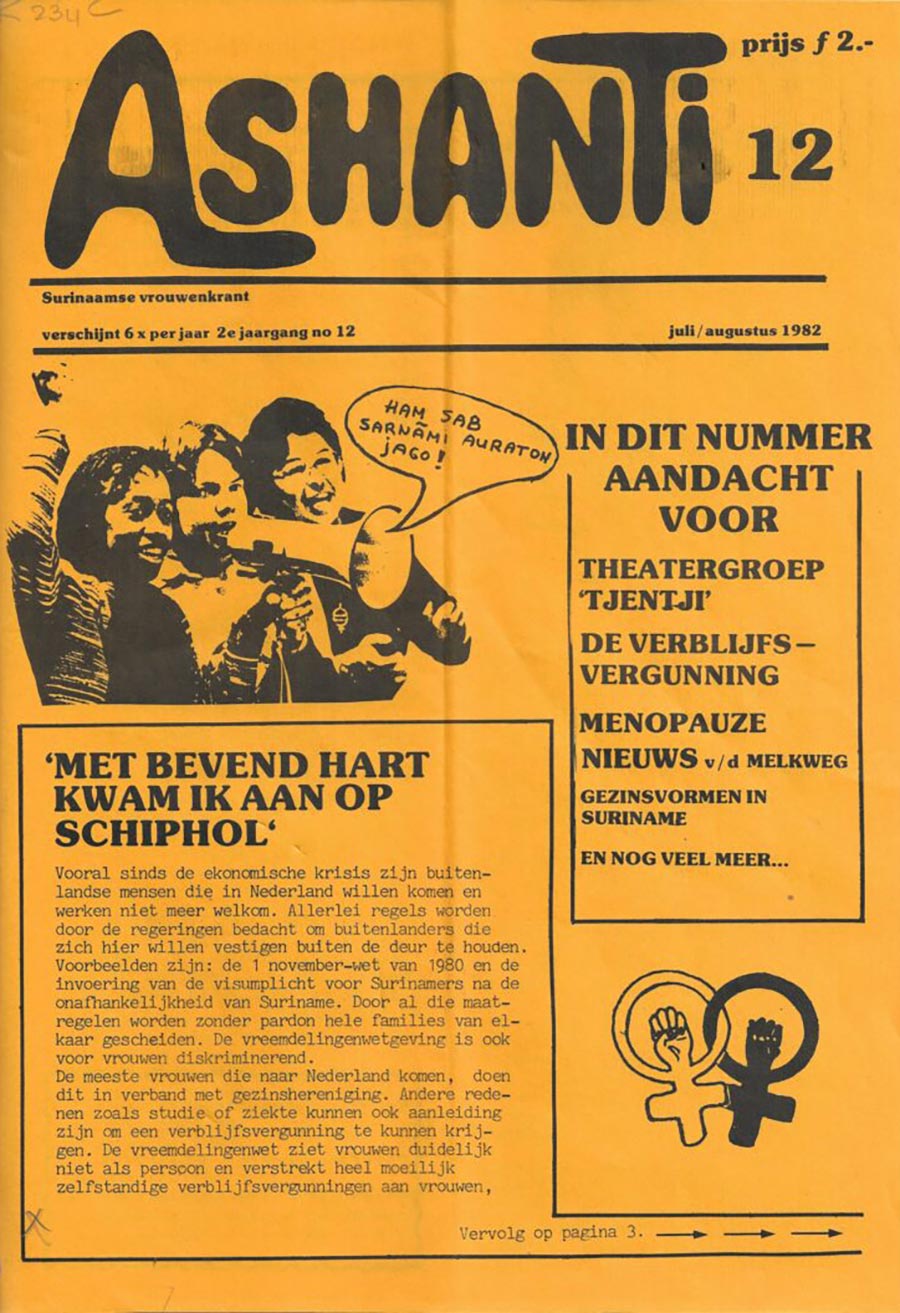
Ashanti, blad voor en door surinaamse vrouwen [Ashanti, magazine for and by Surinames women], 3, January-February 1981, from https://www.sarnamihuis.nl/posts-ihm2021/
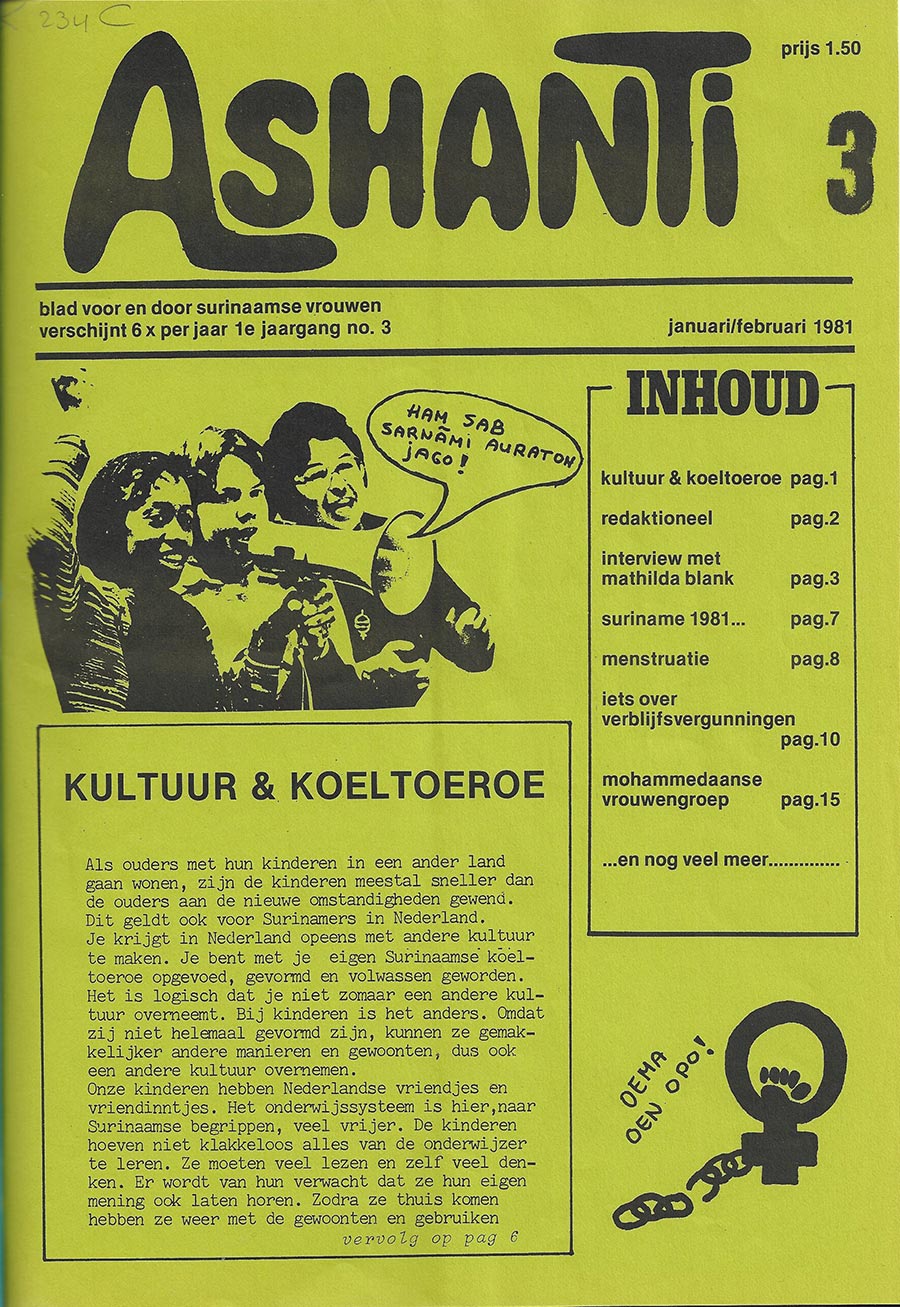
Ashanti, Surinaamse vrouwenkrant [Ashanti, Surinamese women’s newspaper], 12, July-August 1982, from https://www.sarnamihuis.nl/ posts-ihm2021/
De Bonte Was was considered to be a radical feminist publishing house. Many initiatives in the movement qualified themselves as such (radical feminist), so much so that tracing the contours of what this term encompasses becomes an exercise in funambulism. For me, radical feminism is like feminism should be. Very critical, but also very self-reflexive, on the gender roles, power dynamics, on the way women were treated, and on the incorporation of various norms and codes. Often, groups who defined themselves as radical feminist were also separatist. This strand of feminism, stemming from lesbian feminist ideologies, advocated for the necessity—until heteropatriarchy was overthrown—for women to separate themselves from men in women-only enclaves (Travis, 2008, p.278). A withdrawal that would allow them to break free from the heteropatriarchal and capitalist logics that were imposed on them within institutions, relationships, and activities in favour of a more sustainable and supportive women’s culture. Feminist separatism has been a principle widely applied in the Women in Print Movement, that majorly consisted in women-only structures who collaborated, supported each other, and shared tools or spaces (Van Vught, 2020). They excluded men, from their actions, their initiatives, and from their lives. It was very critical too, and some women found it too much. (laughs).
These women’s enclaves, and the movement more generally, also sprung from the friendships, romances, and diverse relationships that its participants entertained with each other. A bond whereby women were able to build common grounds, through which they could support each other and find a sense of togetherness. In the first place it was friendships, joy and pleasure, from which those initiatives arose. We were a band of women who were friendly with each other, sometimes more than friendly. (…) It was important to be able to be together. We could speak out the frustration and recognise that other women felt the same. The feminist calendar was punctuated by parties, drinks, festivals, workshops, collective readings, and various meetings in cafés and vrouwenhuizen, which assisted in developing and promoting a women’s culture whilst cementing an expanding network. The various sites became spaces for encounters, exchanges, and celebrations, for community and kin-making. The parties, the meetings and the discussion nights, however difficult, were very important, even essential, to create a sense of collectiveness.
More than the creation and maintenance of a network, it was also its expansion, both locally and internationally, that these relationships catalysed. Foreign texts from contemporary and historical authors were translated, Translation is crucial in the development of the Women in Print Movement. Translating historical as well as contemporary feminist texts, mostly from the United States, contributed to the formation of a historical and more global bibliography of the women’s movement. It is also eminently political, as this excerpt from the Women’s Translation Collective De Bron shows; “The [collective] started in Amsterdam in 1982, as an initiative of 5 rather critical feminist translators, who neither liked how feminist, and especially lesbian texts were translated, nor the position of translators. It was decided that both could be radically improved by adding a new link in the production chain of women’s books. (…) The collective is specialized in the translation of feminist and lesbian texts. This means that we work primarily for: feminist publishers, women’s studies, lesbian and feminist action groups, selected government agencies” (Van Vught, 2019, p.27; [Information sheet by the Translation Collective De Bron], ca. 1980) allowing feminists to confront their ideas, to exchange and to keep up to date with the evolution of the movement at different scales (Travis, 2008). We had some connections with women from Germany, England, the United-States and from France. One of my friends was in a partnership with Monique Wittig for a while. So we went to France and met other feminists, and later they came here. It was funny, they were very separationist. They wanted to have an island, a women’s island, where they wouldn’t have any interactions with men. Once, we went on a weekend to discuss it. Everyone was very excited, and we talked about it through the night. But in the morning, everyone was desperate, because it turned out that we all had a good reason to not go to the island just yet, ‘yes, I want the island, but not yet because I have a girlfriend’ or ‘Actually, no, maybe later, I can’t leave my mother’. My reason was that I didn’t want to share my books (laughs).

Information sheet by the Translation Collective De Bron, 198?, printed by Las Muchachas Vrouwendrukkerij, Atria, Archive Las Muchachas
The thought exercise that the island represents, though fictional, though idealised, is akin to what they attempted within their lives and practices. How do we imagine a new world outside of heteropatriarchy? How do we live our relationships, how do we create and maintain communities, how do we create together? A variety of responses and paths emerged. Many structures operated in non-hierarchical ways, the voices of every participant, no matter their level of education or involvement in the initiative, counted as much as the others. We always tried to be ‘democratic’. At LOVER, all the decisions were made together, and we talked until everybody was on the same line. Tasks were distributed among the women, who all worked in turn at different positions to prevent forms of dominance and hierarchy from appearing (Furter, 2017, p.26). “Within De Bonte Was we shared intellectual and manual labour as fairly as possible: thinking and writing were expected of everyone, but mimeographing, packing, answering letters, visiting book fairs, giving interviews, etc., as well” (Ekelschot, 2005, sec. De Bonte Was, translation mine.). The signatures are often collective, insisting on the collaborative aspect of the movement’s productions—turning away from the traditional patterns of creation and notion of authorship (Furter, 2017, p.3). This also acted as a protection, as some women wished to publish anonymously. (Ekelschot, 2005, sec. De Bonte Was)
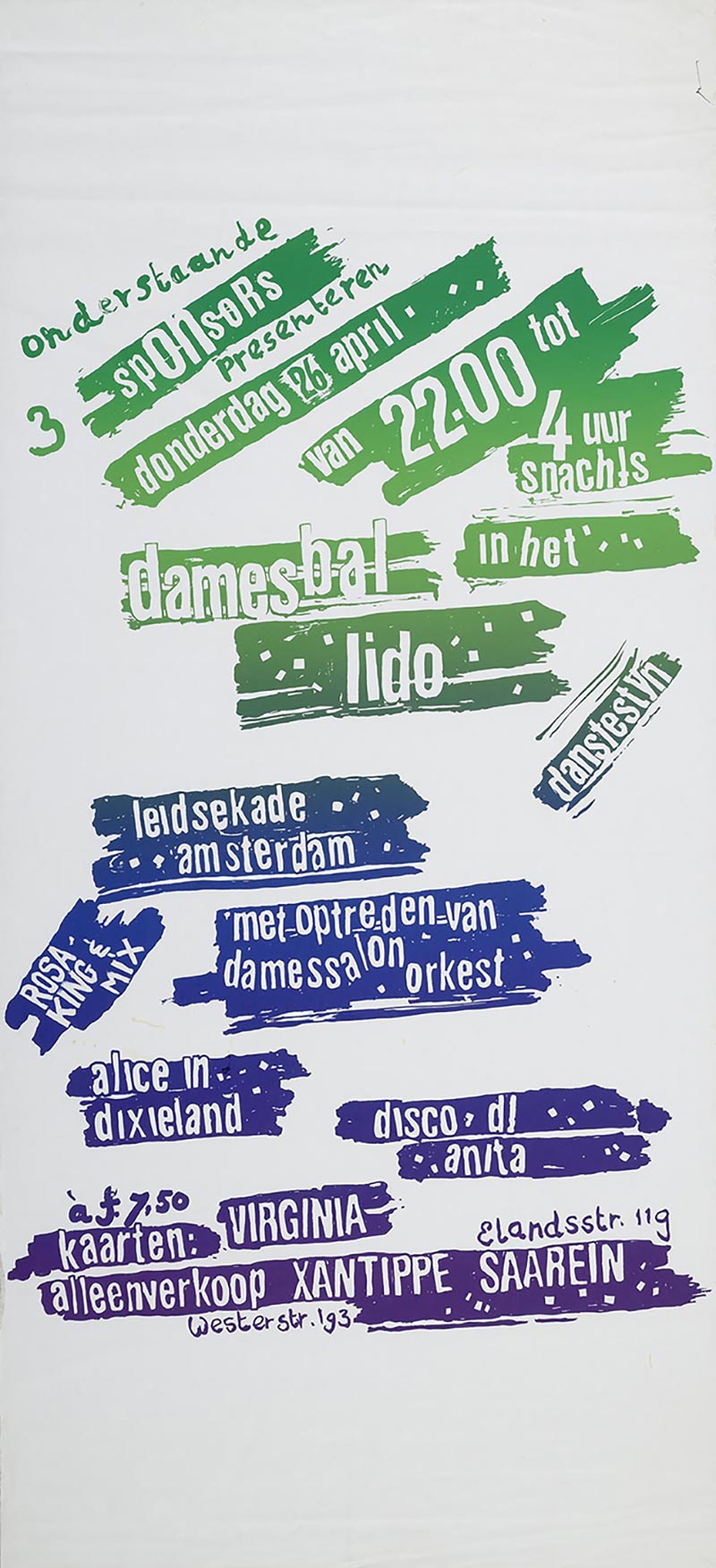
Women’s printer Virginia, women’s bookstore Xantippe and women’s café Saarein organize a women’s ball on April 26, 1979 in the Lido in Amsterdam, with performances by a women’s salon orchestra, Rosa King, Alice in Dixieland and DJ Anita, printed by vrouwendrukkerij Virginia,. Atria, A2487 [poster]
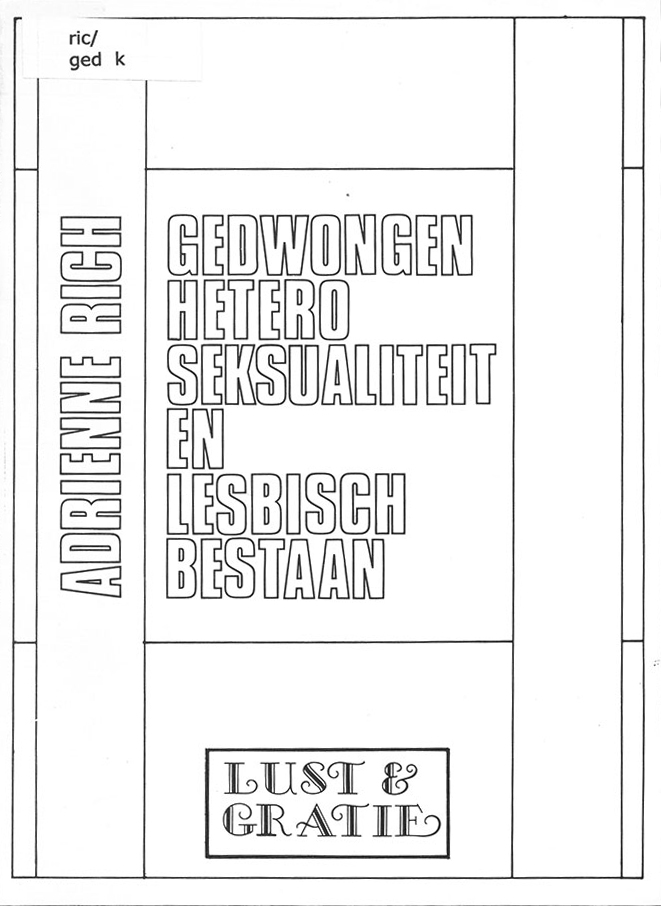
Gedwongen heteroseksualiteit en lesbisch bestaan [Compulsory Heterosexuality and Lesbian Existence], Adrienne Rich, [translation from English: Pamela Pattynama], Stichting Lust en Gratie, 1981 - 43 p., IHLIA LGBTI Heritage collections
In 1985, Pamela’s student subsidies ended, and she started working at the University of Amsterdam. I didn’t have time anymore, and it took a lot of time and work, all of this. So I stepped back, and many women did too. The same year, De Bonte Was published their last book. From this time, she pursued a career; I can’t separate my career and my activism; it began in women’s studies, which became gender studies, then I was in the literature department, and finally I stepped over to the film department. All that time gender was my main focus, a pile of various books and publications, but also partnerships and life-long friendships; many of my friends were in the movement, and my partners as well. We were doing everything together. It is very nice to have friends who share a similar life story, we don’t need to explain, we understand each other with half-words.
8In A Room of One’s Own, an essay derived from two lectures Woolf gave in 1928 at Newnham and Girton College (both women’s colleges at the University of Cambridge), she addresses the condition of women—more particularly of women artists — whose creativity and free expression have been repressed by centuries of financial and educational prejudice; as illustrates her now famous sentence: “a woman must have money and a room of her own if she is to write fiction” (Woolf, 1935, p.5). 9(Anzaldúa, 1983, p.170) This beautiful quotation was shared by Loraine Furter, who came across it during her own research. 10Collectivity—making together—was crucial in the women in print movement, including in the production of content. Various books, pamphlets, newspapers and articles were written collectively, sometimes under a unique signature. In the series of books published by De Bonte Was—even if based on individual experiences—the texts are written using the plural “we”, emphasizing the commonalities in women’s struggle. It also allowed women with varying writing experience to work together and strengthen each other’s individual voices. In an advertisement issued in various feminist periodicals, the Groningen literary magazine Belletrien (published by VIDA), encourages women to start writing “Women have always written. Women write. Women will continue to write. Pick up the pen.” Another striking instance of collective writing is the series of “lesbian pulp novels” titled Wilden Rosen, written together by the four women of the Groningen based Damesschrijfbrigade Dorcas in 1979. (Van Vught, 2020, pp.42-43; [Advertisement for Belletrien, magazine of literature], n.d) 11The weekends were held on March 15th and 16th and April 19th and 20th, 1975. Translation mine. (Ekelschot, 2005, sec. De Bonte Was) 12It is to be noted that most feminist initiatives were relying on squatting, a practice less common since the Dutch squatting ban of 2010. 13“The age range at De Bonte Was was between 19 and 60. We all earned money quite differently: as a midwife, police officer, divorced woman with six children, scientific assistant, student, etc.” (Ekelschot, 2005, De Bonte Was). Many participants of the movement were students and received governmental grants. Other women had unemployment benefits or were working in various sectors. The quasi-absence of financial compensation for activities that were extremely labour-intensive also meant that some women could not engage in such work for monetary reasons.Almost all the archives I consulted from printers, publishers and periodicals included subsidies applications, to both public and private organisations. Some initiatives however, like Atalanta, were reluctant to request them, for ideological reasons and to preserve complete freedom of creation “Applying for a subsidy was not really something that was considered by anarcha-feminists; no way, we liked to stay out of the grip of the government, using our benefits as a basic income. (…) We consciously choose to work without subsidy, i.e. without concessions, without control from outside.” (Van Vught, pp.61-62)
These reflections are shared by other feminists, as evidenced by the creation in 1983 of Mama Cash, the “the world’s first international, independent women’s finance fund”, imagined by Marjan Sax, Dorelies Kraakman, Tania Leon, Patti Slegers and Lida van den Broek, it aimed to “launch innovative activities and to support initiatives that the government would not”. (Archief Mama Cash 1982-2002 [Geschiedenis], n.d.) 14Translation is crucial in the development of the Women in Print Movement. Translating historical as well as contemporary feminist texts, mostly from the United States, contributed to the formation of a historical and more global bibliography of the women’s movement. It is also eminently political, as this excerpt from the Women’s Translation Collective De Bron shows; “The [collective] started in Amsterdam in 1982, as an initiative of 5 rather critical feminist translators, who neither liked how feminist, and especially lesbian texts were translated, nor the position of translators. It was decided that both could be radically improved by adding a new link in the production chain of women’s books. (…) The collective is specialized in the translation of feminist and lesbian texts. This means that we work primarily for: feminist publishers, women’s studies, lesbian and feminist action groups, selected government agencies” (Van Vught, 2019, p.27; [Information sheet by the Translation Collective De Bron], ca. 1980)
Atalanta -
Words for a better World
This chapter is in parts an excerpt from an interview with
Weia Reinboud and Rymke Wiersma that took place on December
14th, 2022, in Utrecht, completed by external sources and
references. The parts in italics are their voices.
Rymke and Weia met in the spring of 1980 and fell in the love the minute they saw each other. At least that is what Weia says. No, you fell in love with me! (Rymke chuckles). They stayed together ever since, partnering in life and in running the still active publishing house Atalanta. Driven by the conviction that “the world can be much nicer, thinking can be much deeper” (Reinboud & Wiersma, n.d.), they write, print, and publish their own works. They live and work in an eco-neighbourhood of Utrecht, in a three-storey house that they share with three friends. On the ground floor, a spacious room that hosted their printing press for many years, is now the home of an office printer, Weia’s paintings and Atalanta’s archives. All the way up the stairs, just under the roof, a room bathed in light in which we sat to drink tea and talk about self-publishing, walking in the mountains, radical feminism, and the Dutch women’s movement.

Illustration, n.d., Atalanta’s personnal archive
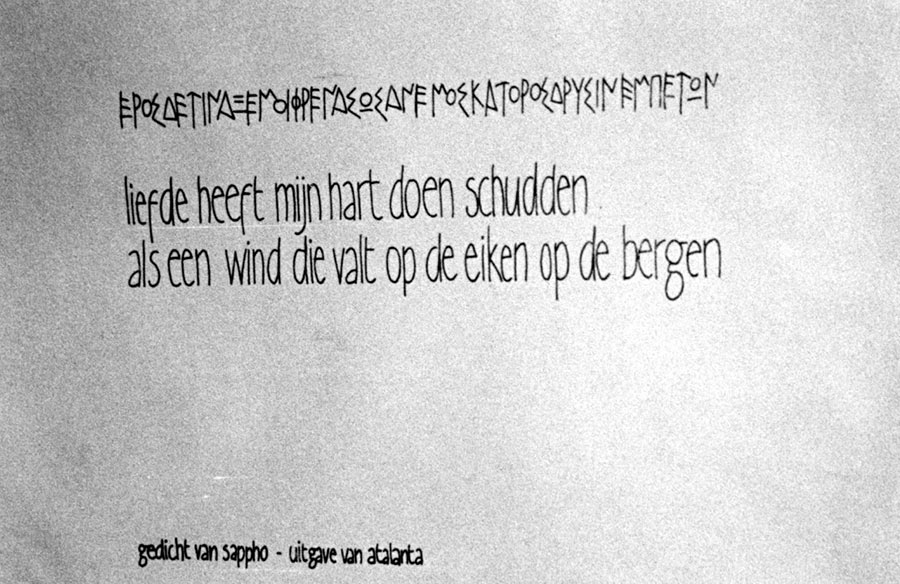
Translated and calligraphed Sappho’s verse, Weia Reinboud, printed by Atalanta, 1982, Atalanta’s personnal archive
At the end of 1979, Rymke, together with three other women, had the idea to create a feminist printing house. None of them knew the first thing about printing, and so they ask Weia, who worked for the feminist printer Virginia, to teach them how to operate the small offset press bought with their savings and the proceeds of a cake sale. More than her expertise, she shared with the other women an enthusiasm that became contagious, and she joined the team in 1980. Soon after, while traveling in Greece, Rymke discovered the mythological heroine Atalanta, a headstrong, swift-footed woman who was raised by a bear on Mount Parthenion and devoted herself to the goddess Artemis. It is also the name of “a beautiful butterfly—but all butterflies are beautiful, of course, as are all woodlice!” (Reinboud & Wiersma, 2005). Atalanta found a name, and soon after, a place. The five women settled in a squatted space in Ridderhofstad, in Utrecht, which they spent more than a year renovating. It was a great time. We didn’t work a lot, because there were so many discussions, so many things happening, in the movement and in our lives. (Rymke). They installed their small single-colour offset press in the centre of the room and painted it a dark-red colour. Everything was finally ready. But before they could even get to print once, the building was sold to a private owner. Atalanta had to move and two of the women, soon followed by a third, left the project for diverse personal reasons. Weia and Rymke took their small venture alone to a new place, a women’s building shared with a wood workshop and an artist space.
At the end of 1982, the first projects rolled off the press. Among them, several prints for women’s restaurant Eucalypta, a poster, some flyers, and stickers for the lesbian festival Pottenpracht, a few posters for various women’s events, and an issue of the Black feminist magazine Umoja, whose members came to help with the printing. But the desire to print for other feminist initiatives was soon hindered by the quirks of their old, unreliable machines. The print quality was inconsistent, their darkroom consisted of a large curtain of black plastic weighted down by pebbles, and the press often had to be operated by hand with a crank made of copper water pipes, making commissioned work difficult and stressful. After some time, they focused mainly on their own productions. I think we were very critical too, so we worked only with a few people (Rymke, laughing). Also, I always wanted to write, and I thought that having our own print shop, I could print and publish my texts too. They could then adapt their designs to the whims of their machines, spend less time repairing them, and devoted themselves more fully to writing, which was taking up more and more of their time. In their texts, they developed a radical and feminist philosophy, intertwined with their anarchist, ecologist, and vegan convictions. This approach makes them difficult to place in bookshops: When we went to the Women’s Bookshop and showed our newest things they said ‘Well, that's more for the leftist Bookshop’, and when we went to the leftist bookshops they said ‘Well, that's more for the ecological bookshop’ etc. (Weia).
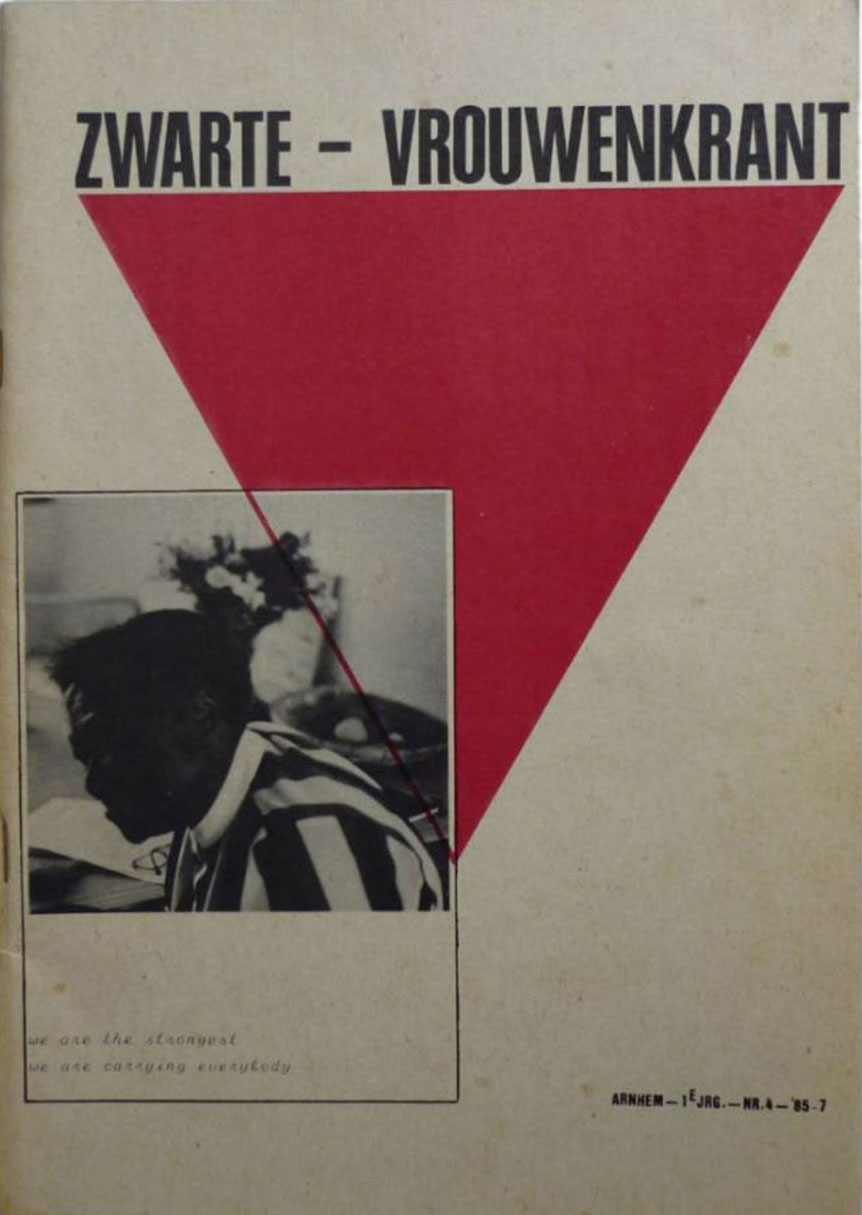
Zwarte — Vrouwenkrant, nr.4, printed by Atalanta, 1985, Atalanta’s personnal archive
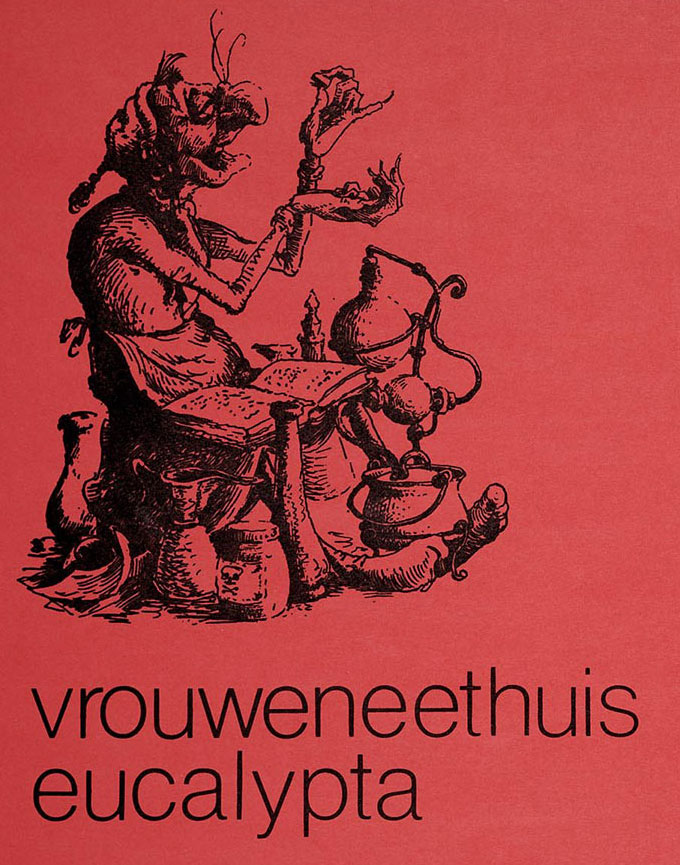
Sticker for women’s restaurant Eucalypta, printed by Atalanta, 1983, Atalanta’s personnal archive
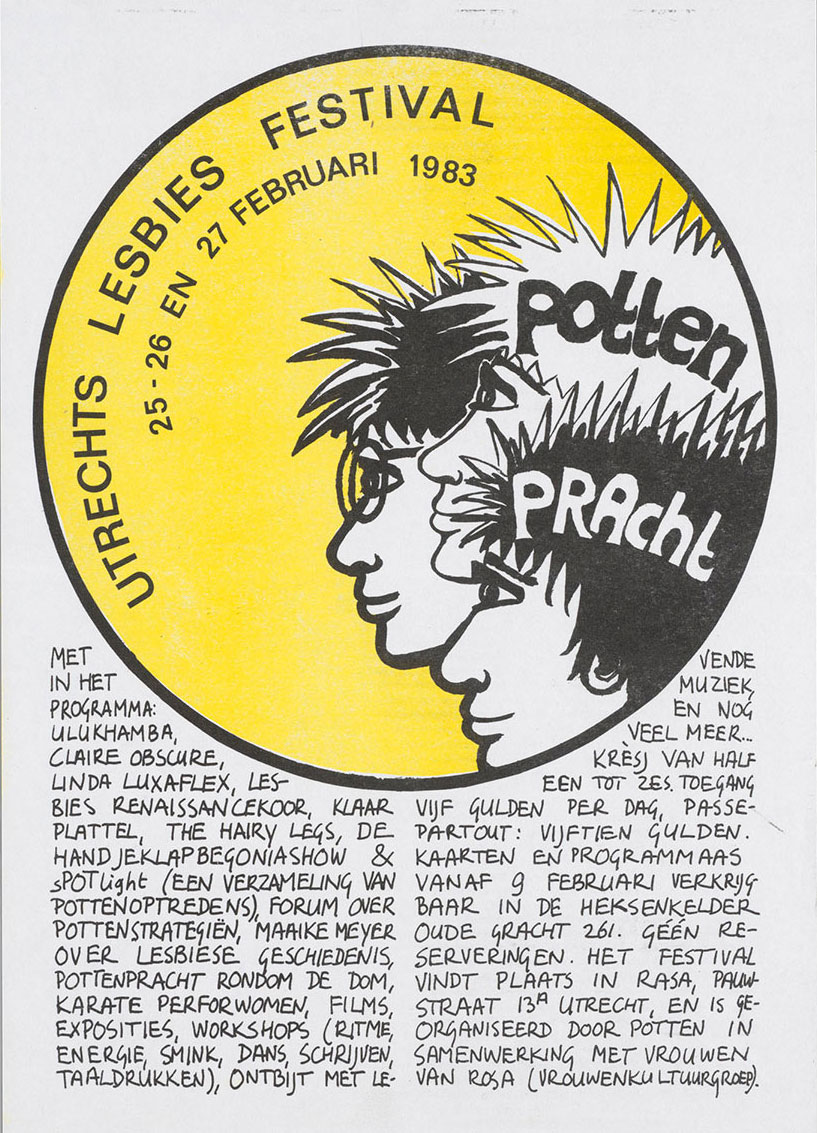
Poster for lesbian festival Pottenpracht Utrecht, printed by Atalanta, 1983, Atalanta’s personnal archive
Being able to produce and publish their content autonomously, without the influence of others, has always been and remains central in Atalanta’s practice. It is more generally a driving force of the Women in Print Movement. Many publications would not have seen the light of day otherwise, as funds were lacking to afford big print runs in mainstream printing houses, which were already quite reluctant to print feminist publications discussing topics such as sex, women’s health, abortion, lesbianism, and feminist politics. (Huisman, 2016, p.4) Learning the technical and practical skills was therefore essential, not only to preserve autonomy, but also to follow the second wave feminist idea “that the simultaneous development of women’s heads and hands was necessary to prevent a divisive split between radical theory and practice. Without a conscious blurring of the lines between manual and mental labour, feminists risked recreating among themselves the hierarchies of class, intellect, power, and so forth, that they were committed to eradicating” (Travis, 2008, p.280). Just like Weia, many women were already working in the printing trade before joining the movement, in which they shared their knowledges and skills with other women who could, in turn, handle printing and production. “We already have the Vrouwenkranten, feminist monthly magazines, feminist publishers (De Bonte Was and Sara), and women’s bookstores, but the technical production was until now in the hands of men.” (Baart, 1978, as cited in Van Vught, 2020) This changes with the creation of the Vrouwendrukkerij Virginia in 1978, probably the first and largest women’s printer in the Netherlands. Virginia printed books and advertisement for Sara and De Bonte Was, and miscellaneous printed objects for various vrouwenhuizen [women house], café Saarein, restaurant Orka la rose, periodical Serpentine, bookstore Xantippe, and diverse feminist events. The following years will witness the emergence of a multitude of printers throughout the country, including: Per Zet (Haarlem, ?), De Kloof (Amsterdam, ?), De Dwarse Prinses (Amsterdam, 1981?), Oma Druck (Nijmegen, 1981?), Sidonia (Groningen, 1981), De Doordrukster (Den Bosch, 1982), Las Muchachas (Amsterdam, 1982), De Ziedende Zeef (Nijmegen, 1982?), De Brandweervrouw (Amsterdam, 1982), Iris (Culembourg, 1983?). Mainly or exclusively producing printed materials for the women’s movement, printing houses also served an emancipatory function. Women who experienced gender discrimination in their studies as well as the professional printing world find a place to learn, share knowledge, and practice their craft in a supportive environment.
The spread of this expertise resulted in the creation of “both a revolutionary women’s culture—one that made all women theorizers of gender—and a revolutionary print culture—one that undid the specialization and professionalization that had characterized printing and publishing since the early modern period.” (Travis, 2008, p.281)
It is also this crossroad of thought that led Atalanta to invent their own modes of creation. Doing everything ourselves, it followed this anarchist idea to always do things your own way (Weia). They paid particular attention to reducing the environmental impact of their production, by using recycled materials and veganizing the printing process. Offset printing is a printing technique in which a rubber cylinder transfers an inked image from a printing plate (usually made of aluminum or zinc) onto paper. The film used to expose the plates commonly contained gelatin, a product derived from animal collagen. Their ideologies resonated in the designs as well, to which they attached great importance. Once, we were at a fair, and a man came to our stand, looked at the books, and said: ‘I don’t like any of your topics, but your books are beautiful!’. Another very decent gentleman was leafing through De Egeltjes. He put it down, picked it up again and bought it. Shy and proud at the same time, he told us: ‘I have never bought anything anarchist before’ (Weia).
(Almost) everything was made by their four hands, collaborating on
the illustrations, hand-drawing letters for the covers, refining them on
the computer, stitching or stappling freshly printed booklets. The design of the Women in Print Movement’s
productions varies greatly from one initiative to another, but also over
time. In the early days of the movement, many publications were produced
urgently, on a small scale and with few resources—all of which
influenced their design. They were reproduced in a manual or semi-manual
ways, and were often typeset, sometimes consisting of a simple stack of
stapled sheets, other time in bound or stapled booklets. Mostly printed
in black, colour could be incorporated through a second ink, or with
coloured paper. The design and production work were often done in-house,
and frequently included manual addition—illustrations, dividers,
lettering. As the movement grew, some publications were produced on a
larger scale, became thicker, some covers became hardback and the manual
additions and small drawings slowly disappeared, making way for images,
in some cases printed in full colour. Weia even created their own
typeface, named Atalanta, a revival of a Nicolas Jenson font dating from
1470. Months of work, scrunched back over the small screen of their
newly acquired Atari computer were necessary to finish the typeface,
adding some roman capitals as well as an anarchist sign to the
renaissance lowercases. Although she studied type design briefly, she
mostly learned by herself. Typography was (and remains) an extremely
exclusive, normative field, dominated by (white, heterosexual) men, and
from which women were largely excluded, or restricted to certain
positions. A few women managed to infiltrate this small world, using
particular strategies, like Beatrice Warde who joined American Type
Founders as a specialised librarian, and published her first research
paper in 1927 in Le Fleuron under the pseudonym Paul Beaujon.
(Furter, 2020) A rarity, until the advent of early digital
technologies that allowed women, like Weia, to enter this field through
a back door. See the great article Crystal Clear, written by
Loraine Furter, about this topic: “Since many established type designers
have been slow to embrace or even hostile towards these new technologies
of making fonts, women finally have the opportunity to enter the field
of type design, and simultaneously become pioneers. The most famous
designers of this time are Susan Kare, type, and icon designer for the
first Apple Macintosh, Carol Twombly, who co-designed the font Myriad,
Virginia Howlett, designer of the font Verdana, Zuzana Licko, co-founder
of one of the first independent digital type foundry named Emigre and
type designer, Muriel Cooper, with pioneer electronic ‘typographic
landscapes’ at MIT’s Media Lab she founded in 1975.”
(Furter, 2020)
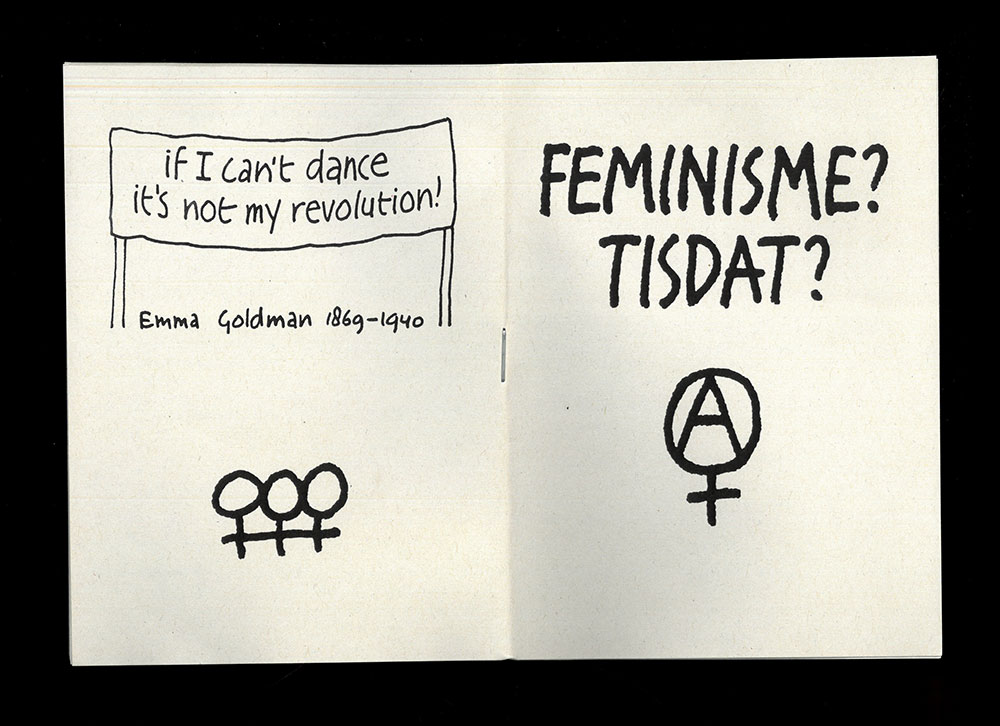
Feminisme? Tisdat?, 16p., 10x16cm, 2003, written and printed by Atalanta, Atalanta’s personal collection
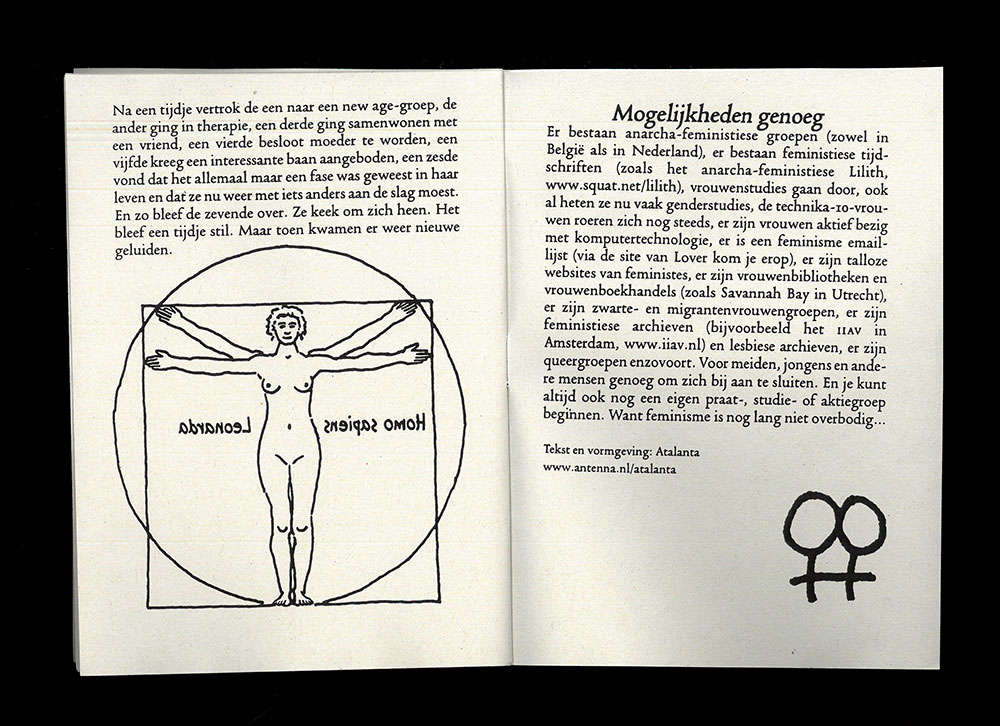
Feminisme? Tisdat?, 16p., 10x16cm, 2003, written and printed by Atalanta, Atalanta’s personal collection
Atalanta multiplied media, produce(d) music, videos, games, postcards, t-shirts. So many forms which carry and spread their message in different ways and in different places. This thesis focuses on publishing, but the printed material found in the archives testifies to the variety and richness of the movement’s cultural productions. Theatre, music and film festivals, radio broadcasts, and numerous exhibitions were organized by various groups and initiatives. This diversification of formats, and the breaking away from the book-object, was found in many productions of the Women in Print Movement. The different actions and demonstrations saw a multitude of banners, t-shirts, posters, buttons, but also bodies shouting loudly what they think, their anger, their messages. Challenging the traditional format of the publication, these urgent artefacts, although more ephemeral, still constituted ways of publishing; they made public and disseminated ideas. They established in a radical way new narratives and disrupted those in place, in their form as in their discourse.
To this day, Rymke and Weia, are still busy crafting and sharing these disruptive stories, their ideas for a better world. Except for Wednesdays, their day off, which is dedicated to long walks and observing birds. Their story is quite unique within the History of movement. Its longevity, the diversity of their activities, media, and subjects of writing, the intertwinement of radical feminism with other currents of thought—veganism, anarchism, anti-racism—the scale, which remained deliberately small, allowing them to do everything themselves as much as possible, from the creation of the content, to the design, printing, production and distribution of the books are as many particularities that make it stand out.
15“We already have the Vrouwenkranten, feminist monthly magazines, feminist publishers (De Bonte Was and Sara), and women’s bookstores, but the technical production was until now in the hands of men.” (Baart, 1978, as cited in Van Vught, 2020) This changes with the creation of the Vrouwendrukkerij Virginia in 1978, probably the first and largest women’s printer in the Netherlands. Virginia printed books and advertisement for Sara and De Bonte Was, and miscellaneous printed objects for various vrouwenhuizen [women house], café Saarein, restaurant Orka la rose, periodical Serpentine, bookstore Xantippe, and diverse feminist events. The following years will witness the emergence of a multitude of printers throughout the country, including: Per Zet (Haarlem, ?), De Kloof (Amsterdam, ?), De Dwarse Prinses (Amsterdam, 1981?), Oma Druck (Nijmegen, 1981?), Sidonia (Groningen, 1981), De Doordrukster (Den Bosch, 1982), Las Muchachas (Amsterdam, 1982), De Ziedende Zeef (Nijmegen, 1982?), De Brandweervrouw (Amsterdam, 1982), Iris (Culembourg, 1983?). Mainly or exclusively producing printed materials for the women’s movement, printing houses also served an emancipatory function. Women who experienced gender discrimination in their studies as well as the professional printing world find a place to learn, share knowledge, and practice their craft in a supportive environment. (Van Vught, 2019, pp.45-48, appendix 1) 16Offset printing is a printing technique in which a rubber cylinder transfers an inked image from a printing plate (usually made of aluminum or zinc) onto paper. The film used to expose the plates commonly contained gelatin, a product derived from animal collagen. 17The design of the Women in Print Movement’s productions varies greatly from one initiative to another, but also over time. In the early days of the movement, many publications were produced urgently, on a small scale and with few resources—all of which influenced their design. They were reproduced in a manual or semi-manual ways, and were often typeset, sometimes consisting of a simple stack of stapled sheets, other time in bound or stapled booklets. Mostly printed in black, colour could be incorporated through a second ink, or with coloured paper. The design and production work were often done in-house, and frequently included manual addition—illustrations, dividers, lettering. As the movement grew, some publications were produced on a larger scale, became thicker, some covers became hardback and the manual additions and small drawings slowly disappeared, making way for images, in some cases printed in full colour. 18See the great article Crystal Clear, written by Loraine Furter, about this topic: “Since many established type designers have been slow to embrace or even hostile towards these new technologies of making fonts, women finally have the opportunity to enter the field of type design, and simultaneously become pioneers. The most famous designers of this time are Susan Kare, type, and icon designer for the first Apple Macintosh, Carol Twombly, who co-designed the font Myriad, Virginia Howlett, designer of the font Verdana, Zuzana Licko, co-founder of one of the first independent digital type foundry named Emigre and type designer, Muriel Cooper, with pioneer electronic ‘typographic landscapes’ at MIT’s Media Lab she founded in 1975.” (Furter, 2020) 19This thesis focuses on publishing, but the printed material found in the archives testifies to the variety and richness of the movement’s cultural productions. Theatre, music and film festivals, radio broadcasts, and numerous exhibitions were organized by various groups and initiatives.The Researcher, the Designer & the Archive
Why am I telling you these stories? And maybe more interestingly, why am I telling them in this particular way? The idea of the interviews initially emerged from being confronted with the sheer volume of the archive. Having found relatively little theoretical resources about the movement and its development in the Netherlands, I expected this to be echoed in the amount of archival material. I was surprised to discover an overflowing, dense, and complex archive, in which I would soon drown, unable to make a choice, to decide to focus on this or that initiative. A lush, yet incomplete, unruly mass that is defined as much by what it gathers as what it excludes. See note n°4 about the Archive.
The archive was therefore no longer just a place that provided access to
sources, but in turn a subject, an actor in the research, allowing a
better understanding of how stories are shaped, but also forgotten and
marginalised. Chandra Frank, in a recent article on her findings on the
transnational feminist lesbian exchanges between the Dutch collective
Sister Outsider and Audre Lorde that took place in 1984 and 1986,
reflects on the traces of this event in the Archive for the Women’s
Movement (IAV), hosted at Atria in Amsterdam, and in the Spelman College
Archives in Atlanta, Georgia. Comparing how they came into being and
have evolved, she underlines how archives—as a sites of knowledge
production—are informed and structured by violent mechanism of
exclusion, not only through the selection of material made available,
but also through its organization and systematization—how material can
(or cannot) be found: “[f]or example, within the IAV Collection there
are similar collectives and publications that were all part of the BMR
[Black, Migrant, Refugee] movement and are either coded as <black
women> or <black women’s movement>; yet these two terms signify
a different historiography when constructing a genealogy of the BMR
movement.” “The [IAV] collection has historically been
white-focused, which led early BMR archivists of colour such as Cisca
Pattipilohy and Troetje Loewenthal to develop a strong critique of the
racialised institutional memory practices of white archival
institutions. This eventually inspired the start of Flamboyant, the
first national documentation and research centre for BMR women, where
Sister Outsider was known to organise too. The critiques by BMR women
were directly related to the way that white institutions would engage,
code, catalogue and make available materials that pertain to racialised
feminist and queer histories. The earlier critiques, voiced on the
accessibility of materials, still resonate today as the lack of
specialised knowledge on the BMR movement informs how materials can be
found at Atria. For example, within the IAV Collection there are similar
collectives and publications that were all part of the BMR movement and
are either coded as <black women> or <black women’s
movement>; yet these two terms signify a different historiography
when constructing a genealogy of the BMR movement. The first term
indicates that the archival materials will be about Black women, while
the second suggests that the materials in this particular record are
part of a broader movement. These different coding systems make it
impossible to have an understanding of the scope of materials that are
related to the BMR movement in the IAV Collection.”
(Frank, 2019, p.16)
She argues that the use and re-activation of those archival materials does more than just activate specific stories—it becomes the embodiment of the refusal to be part of a “forgotten archive” (Frank, 2019, p.12), an embodied practice of memory.
“I am invested in both addressing the complexities of conducting archival research and, inspired by Clare Hemmings (2011), asking why these stories matter. (…) I argue that a transnational feminist archival methodology that is rooted in a practice of ‘orientation’ (Ahmed, 2006a, 2006b), ‘listening’ (Campt, 2017) and ‘intervention’ (Appadurai, 2003) is best placed to analyse the political solidarity forged between Sister Outsider and Audre Lorde. I take this approach to ask larger questions of how feminist and queer stories are told when contending with the complexities and unruliness of archives. Hemmings (2011) urges feminist scholars to take into consideration how narratives are constructed. Similar to and beyond the academic institution that Hemmings locates as a primary stakeholder in this process, the archive greatly impacts how stories and their afterlives are reckoned with.” (Frank, 2019, p.12)
It thus appeared important to take a step aside, one foot in the personal and the other in the institutional, in order to examine it better, to make a shift to not to work on the archive, but rather with it. Listening, encountering, exchanging, as ways to re-activate and put in perspective archival materials appeared to me as the best suited way to conduct this study. These exchanges also proved necessary with regard to the personal and emotional nature of some archival material. A matter which was discussed at length with Inge Frank van Vught, in a conversation about the difficulties of working with such sensitive content, as some of the participants of the movement do not want to see it republished or shared, and about conducting research on the stories of people with whom relations of friendships and trust are developed. Pamela (Pattynama), at the end of our interview, told me about two young feminists—Marie Lotte Hagen and Nydia van Voorthuizen—who invited Netty van Hoorn Netty Van Hoorn is a Dutch director. In 2019, she released a documentary titled De Stad Was van Ons — Radicaal feminism in de Jaren 1970s [The City Was Ours, Radical Feminism in the 1970s]. Mixing historical footages, photos and interviews, this documentary revisits the role of radical feminism in the women’s movement through the work of various individual, groups and initiatives in the Netherlands. (Van Hoorn, n.d.) and her to participate in an episode of their podcast DAMN, HONEY. (Hagen & Van Voorthuizen, 2020) The hosts were deeply moved and enthusiastic upon hearing their stories, as they were unfamiliar with the history and actions of the radical feminist and lesbian movements. The voices, stories, individual experiences, and collections of the participants of the movement are indispensable to make accessible and stitch back the bits and pieces of a fragmented historiography. The episode became one of the most popular of the podcast, largely listened to by young women, thus demonstrating the significance of transgenerational exchanges in the process reclaiming and rewriting herstories that have been confiscated for too long. By establishing connections between different timelines, they also allow the construction of solidarity and kinship with other, crucial for resisting and existing in normative spaces, as well as for future feminist engagement. (Noorani & Nixdorff, 2022)
“Re-vision, the act of looking back, of seeing with fresh eyes, of entering an old text from a critical direction, is for women more than a chapter in cultural history. It is an act of survival. We need to know the writing of the past and know it differently than we ever known it. Not to pass on a tradition, but to break its hold over us.” (Rich, 1979 as cited in Wekker, 2016). This quote was read by (typographer and researcher) Tabea Nixdorff, for the finale of the Feminist Assembly Month, which she co-organised with (architect and researcher) Setareh Noorani at Het Nieuwe Instituut in September 2022. A series of events and activities, consisting in a pop-up exhibition, a movie screening, a radio show, a wiki-edit-a-thon, a talk by Gloria Wekker, and five intergenerational roundtables, which aimed to “bring together different generations of feminists for a month of inspiring, urgent conversations, situated around the exhibition room Feminist Design Strategies”. This room collected and connected traces of ways in which women, particularly from marginalised communities, sought to challenge the unequal and predominantly white male-dominated narratives in the fields of architecture, urban planning and design during the second feminist wave. On a loom-like structure, photographs, documents, and facsimiles—both from personal and institutional archival collections—were beautifully woven together with explanatory texts, as well as comments and interventions from the visitors. (Noorani & Nixdorff, 2022)
Then, what role can the designer play in this process? As a custodian of communication and publishing tools, they can act as a mediator, facilitating access and re-activating content, making it public while making publics (xpubliverse, n.d.)—transforming, augmenting, disseminating, these materials via processes that gather, connect, and create audiences—thus serving as a key ingredient to breathe new life into archives. The L.i.P. collective The L.i.P. Collective is Zenobia Ahmed, Yanchi Huang, Sophia Yuet See, Silva Baum, Phoebe Eustance, Pauline Piguet, Noemi Parisi, Nina Paim, Naïma Ben Ayed, Mujgan Abdulzade, Mio Kojima, Maya Ober, Mariachiara De Leo, Madeleine Morley, Loraine Furter, Klaudia Mazur, Floriane Misslin, Fanny Maurel, Eugénie Zuccarelli, Elham Namvar, Delphine Bedel, Corin Gisel, Clara Amante, Carolyn Kerchof, Barbora Demovičová, and Amy Gowen.—or the Liberation in Print Collective—is a multidisciplinary, transnational group of “activists, writers, graphic designers, sociologists, publishers, artists, type designers, students, and educators of differing ages and backgrounds” (Futuress, 2023) who joined forces in an endeavour to uncover feminist stories and histories hidden in digital archives. Their findings were presented in a zine and an exhibition, and are still accessible through a series of online articles. Available here Similarly to the publishing practices of the Women in Print Movement, blurring the boundaries between disciplines, the designer becomes in turn an archaeologist, a detective, a researcher, an editor, a (re-)publisher.
“In recent years, through the efforts of many archivist-activists, more and more feminist periodicals are being digitized and are becoming available online. Although many of them can be read and browsed for free, few people know about these vast resources; the histories in—and behind—their scanned pages remain largely unknown, especially to a broad audience. Together as the L.i.P. Collective, we sought to find out more: we solved the mystery of an underground tearoom in Paris, heard from the co-founder of India’s first feminist press, corresponded with three cover girls from the Soviet Union, discovered an all-Asian American group of women students fighting against oppression in the 60s, and so much more. And in the process of all this finding, we also found one another.” (Futuress, 2023)
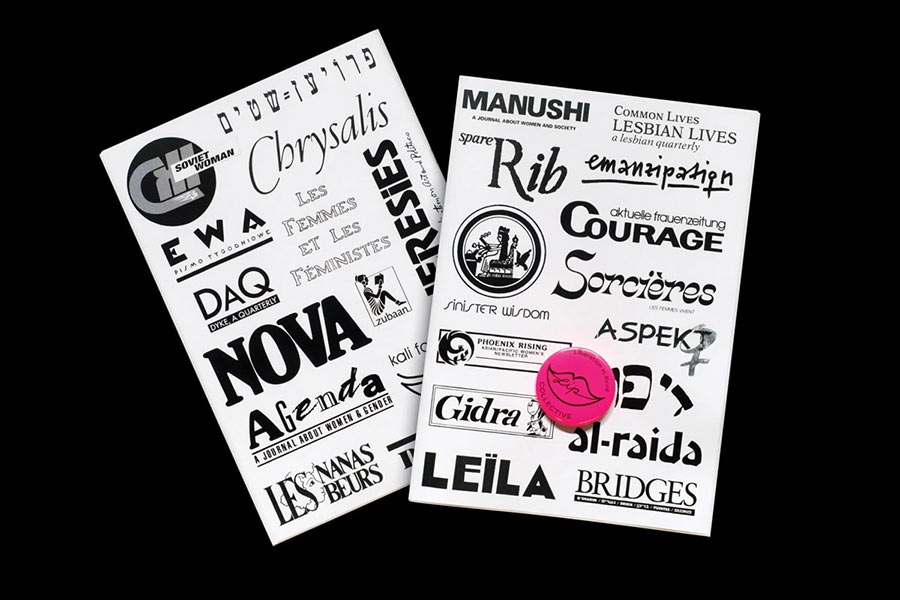
Feminist Findings, The L.i.P. Collective, 2020, copyright Futuress
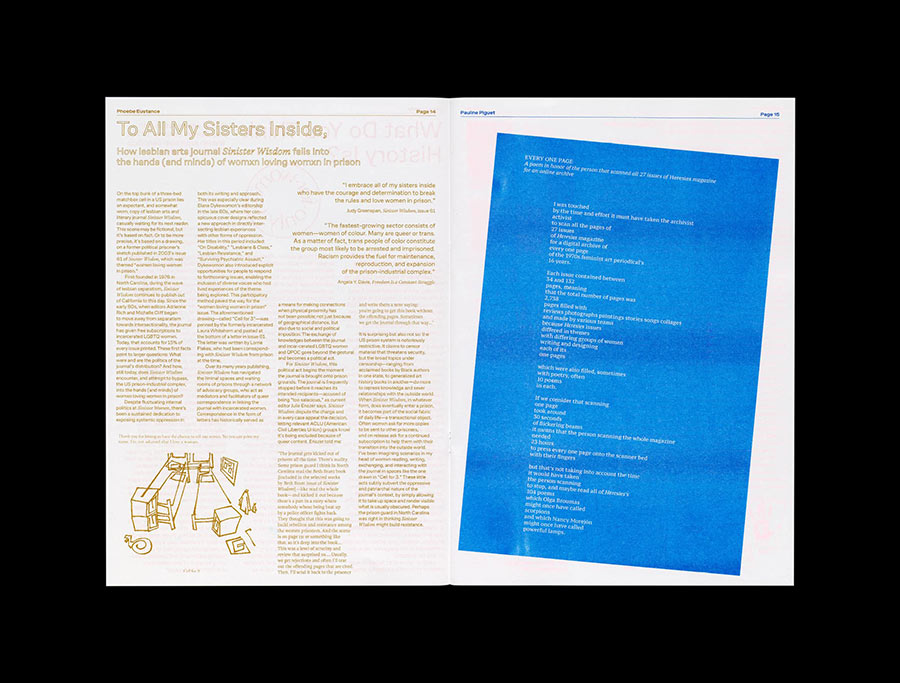
Feminist Findings, The L.i.P. Collective, 2020, copyright Futuress
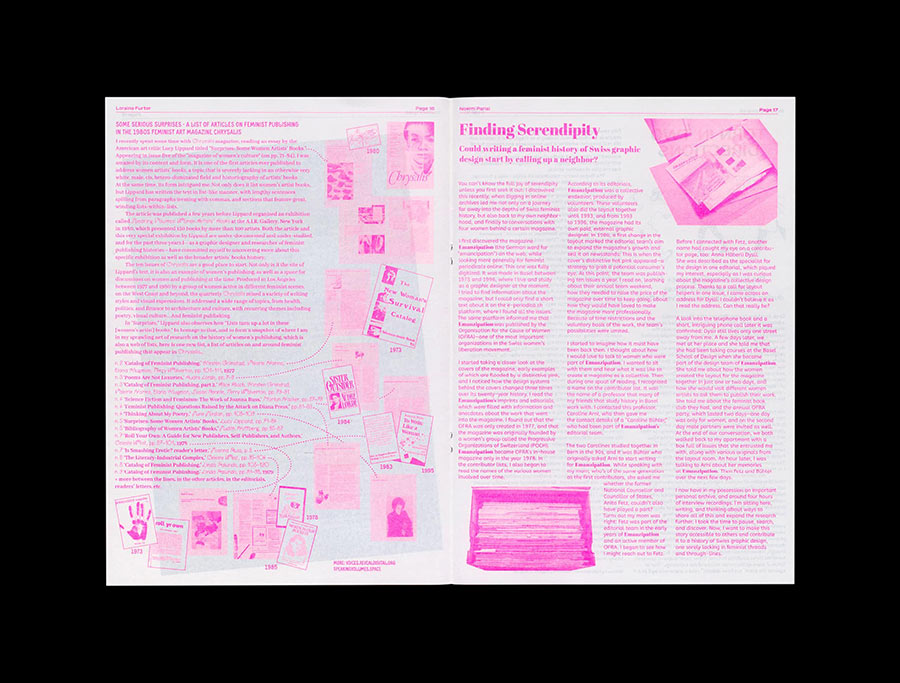
Feminist Findings, The L.i.P. Collective, 2020, copyright Futuress
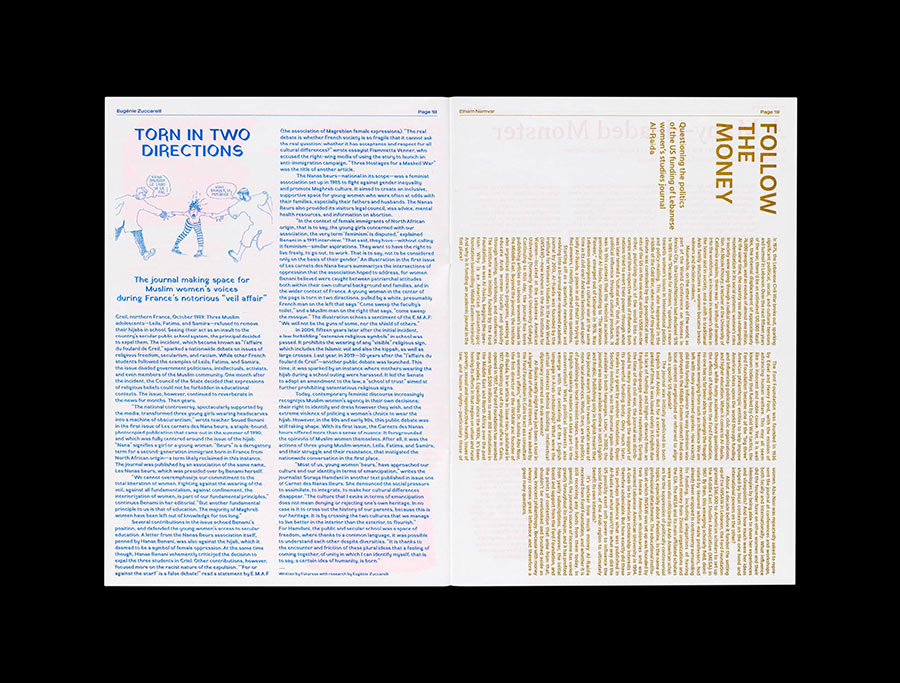
Feminist Findings, The L.i.P. Collective, 2020, copyright Futuress
Thus, digitalization does not (by itself) necessarily guarantee broader or fairer accessibility to content, but also to publishing tools and dissemination platforms. The last decades have seen the emergence of new, hybrid or digital publication formats which redefine both the traditional conception of the publication— “allow[ing] for forms which were long de-considered and rejected from legitimate writing and history to be finally included” (Furter, 2017, p.3), and its accessibility. However,
“despite this wider access, some conditions (economic means, education, censorship) make that many voices still cannot express themselves. And again, when they can, there still must be someone to listen to them. The attention that is due to these new forms of publication, and the value that is associated aren’t spread in an equal way. A blog, as accessible as it can seem, needs to be relayed to be actually read, and, even if one can today use commoned software tools, it needs maintenance. Through social media platforms, we have more than ever access to the button “publish”, but we don’t necessarily have control over the mechanisms and conditions in which it happens. Publishing is a question of distribution, not only in its potential (a stock of books, a pdf ready to be printed on demand, a website pushed online...) but also in its actual reception by a public.” (Furter, 2017, p.3)
Striving for more inclusive and sustainable publishing practices therefore also means to facilitate and critically reflect on, as designers, not only the access to contents, but also to tools and platforms.
20See note n°4 about the Archive. 21“The [IAV] collection has historically been white-focused, which led early BMR archivists of colour such as Cisca Pattipilohy and Troetje Loewenthal to develop a strong critique of the racialised institutional memory practices of white archival institutions. This eventually inspired the start of Flamboyant, the first national documentation and research centre for BMR women, where Sister Outsider was known to organise too. The critiques by BMR women were directly related to the way that white institutions would engage, code, catalogue and make available materials that pertain to racialised feminist and queer histories. The earlier critiques, voiced on the accessibility of materials, still resonate today as the lack of specialised knowledge on the BMR movement informs how materials can be found at Atria. For example, within the IAV Collection there are similar collectives and publications that were all part of the BMR movement and are either coded as <black women> or <black women’s movement>; yet these two terms signify a different historiography when constructing a genealogy of the BMR movement. The first term indicates that the archival materials will be about Black women, while the second suggests that the materials in this particular record are part of a broader movement. These different coding systems make it impossible to have an understanding of the scope of materials that are related to the BMR movement in the IAV Collection.”(Frank, 2019, p.16) 22These exchanges also proved necessary with regard to the personal and emotional nature of some archival material. A matter which was discussed at length with Inge Frank van Vught, in a conversation about the difficulties of working with such sensitive content, as some of the participants of the movement do not want to see it republished or shared, and about conducting research on the stories of people with whom relations of friendships and trust are developed. 23Netty Van Hoorn is a Dutch director. In 2019, she released a documentary titled De Stad Was van Ons — Radicaal feminism in de Jaren 1970s [The City Was Ours, Radical Feminism in the 1970s]. Mixing historical footages, photos and interviews, this documentary revisits the role of radical feminism in the women’s movement through the work of various individual, groups and initiatives in the Netherlands. (Van Hoorn, n.d.) 24(Rich, 1979 as cited in Wekker, 2016). This quote was read by (typographer and researcher) Tabea Nixdorff, for the finale of the Feminist Assembly Month, which she co-organised with (architect and researcher) Setareh Noorani at Het Nieuwe Instituut in September 2022. A series of events and activities, consisting in a pop-up exhibition, a movie screening, a radio show, a wiki-edit-a-thon, a talk by Gloria Wekker, and five intergenerational roundtables, which aimed to “bring together different generations of feminists for a month of inspiring, urgent conversations, situated around the exhibition room Feminist Design Strategies”. This room collected and connected traces of ways in which women, particularly from marginalised communities, sought to challenge the unequal and predominantly white male-dominated narratives in the fields of architecture, urban planning and design during the second feminist wave. On a loom-like structure, photographs, documents, and facsimiles—both from personal and institutional archival collections—were beautifully woven together with explanatory texts, as well as comments and interventions from the visitors. (Noorani & Nixdorff, 2022) 25The L.i.P. Collective is Zenobia Ahmed, Yanchi Huang, Sophia Yuet See, Silva Baum, Phoebe Eustance, Pauline Piguet, Noemi Parisi, Nina Paim, Naïma Ben Ayed, Mujgan Abdulzade, Mio Kojima, Maya Ober, Mariachiara De Leo, Madeleine Morley, Loraine Furter, Klaudia Mazur, Floriane Misslin, Fanny Maurel, Eugénie Zuccarelli, Elham Namvar, Delphine Bedel, Corin Gisel, Clara Amante, Carolyn Kerchof, Barbora Demovičová, and Amy Gowen. 26Available here
Conclusion
“Mapping a feminist landscape can never be complete.”(Noorani & Nixdorff, n.d.) In this thesis, I recounted two stories of feminist publishing, but many others are still sleeping in the archives, and some never made it there. A compromised accessibility that results from intersecting forms of discrimination, unjustly erasing some histories, positing them in the realm of the forgotten—the marginalised. Finding them requires archaeological skills—scratching the surface of the institutional, digging in the archive but also outside of it, to uncover the untold stories hidden between the lines, confined in attics or memories. They call for specific, hybrid methodologies, centring around practices of listening, exchanging, and encountering, and by connecting individuals, generations, and timelines, enabling the rewriting and reclaiming of long-lost stories, as well as building legacies and common grounds for future feminist efforts.
Feminist stories of publishing constitute a rich reservoir of ideas and practices; dismantling traditional hierarchies and notions of authorship, emphasizing the importance of collectivity, skill-sharing, kin-making and autonomy, as well as creating independent networks of solidarity, production and distribution.
As many proposals it feels urgent to revive in a contemporary context, where access to publishing tools and platforms has been transformed by the emergence of digital technologies but remain widely unequal. They provide a basis to reflect upon how the designer can catalyse the emancipatory potentials of publishing, by facilitating the access to contents, tools, and platforms, in the pursuit of more sustainable and inclusive practices.
Lara Dautun, 2023,
BA Graphic Design,
Royal Academy of Art, The Hague,
laradautun.xyz
For any comment or suggestion:
lara.dautun@gmail.com
Supervised by Prof. Füsun Türetken
References
Anzaldúa, G. (1983). Speaking in Tongues: A Letter to Third World Women Writer. In This Bridge Called My Back: Writings by Radical Women of Color (2nd éd., p. p.165). Kitchen Table/Women of Color Press.
Archive Xantippe Women’s Bookshop 1975-1997 (By A. Mevis). (n.d.). [Dataset]. Atria, kennisinstituut voor emancipatie en vrouwengeschiedenis.
Atria, Instituut voor emancipatie, vrouwengeschiedenis en gendergelijkheid. (n.d.). https://collectie.atria.nl/
Baart, S. (1978, July 18). Virginia: drukkerij voor vrouwen zonder machtspositie, rotklussen moet iedereen doen. De Volkskrant.
Biblia pauperum. (n.d.). In The Library of Congress. Retrieved February 20, 2023, from https://www.loc.gov/item/49038879/
Blackfeminisms. (2020). The Matrix of Domination and the Four Domains of Power. Blackfeminisms.com. Retrieved February 10, 2023, from https://blackfeminisms.com/matrix/
Cadman, E., Chester, G., & Pivot, A. (1981). Rolling our own : Women as printers, publishers and distributors. Minority Press Group.
Collection IAV-Atria (n.d.), Archief Xantippe Vrouwenboekwinkel 1975-1997 [Geschiedenis]. Archief Xantippe Vrouwenboekwinkel 1975-1997 (IIAV00000316)
Collection IAV-Atria (n.d.), Archief Mama Cash 1982-2002 [Geschiedenis]. Archief Mama Cash 1982-2002 (IIAV00000514)
Collins, P. H. (1990). Black Feminist Thought: Knowledge, Consciousness, and the Politics of Empowerment. Hyman.
Colman, M. A. (2008). herstory. In Oxford Reference. Retrieved February 24, 2023, from https://www.oxfordreference.com/display/10.1093/oi/authority.20110803095933417;jsessionid=462550EFA4B8194B7EA0EFEBC1C7F5C7
Costanza-Chock, S. (2018). Design Justice, A.I., and Escape from the Matrix of Domination. Journal of Design and Science. https://doi.org/10.21428/96c8d426
Crenshaw, K. (2018). Demarginalizing the Intersection of Race and Sex: A Black Feminist Critique of Antidiscrimination Doctrine, Feminist Theory, and Antiracist Politics [1989]. Feminist Legal Theory, 57–80. https://doi.org/10.4324/9780429500480-5
Davidjgary. (2013, February 5). Summary of Darnton’s “What is the History of Books?” Function Follows Forme. Retrieved February 10, 2023, from https://davidjgary.wordpress.com/2013/02/05/summary-of-darntons-what-is-the-history-of-books/
De Vries, P. (2016, March 10). De tweede feministische golf, Feminisme 20ste eeuw. Atria. Retrieved January 5, 2023, from https://atria.nl/nieuws-publicaties/feminisme/feminisme-20e-eeuw/de-tweede-feministische-golf/
Dutch squatting ban. (2023). Retrieved February 13, 2023, from https://en.wikipedia.org/wiki/Dutch_squatting_ban
Dżułaj, E. (2020). The Phenomenon of the Private Press. Printing as a form of activism and resistance. [Bachelor Thesis]. Koninklijke Academie van Beeldende Kunsten (KABK).
Edit-a-thon. (2022). Retrieved February 5, 2023, from https://outreach.wikimedia.org/wiki/Edit-a-thon
Ekelschot, M. (2005). De Bonte Was. Radicaal Feminisme. Retrieved January 26, 2023, from http://www.radicaalfeminisme.nl/html/bontewas.html
Frank, C. (2019). Sister Outsider and Audre Lorde in the Netherlands: On Transnational Queer Feminisms and Archival Methodological Practices. Feminist Review, 121(1), 9–23. https://doi.org/10.1177/0141778918818753
Furter, L. (n.d.). RESEARCH IN PROGRESS. Retrieved February 6, 2023, from https://www.lorainefurter.net/research/
Furter, L. (2017). Speaking Volumes: Art, activism and feminist publishing (version 0.3) [Online Publication]. https://www.lorainefurter.net/projects/speaking-volumes/speaking-volumes-EN.pdf
Furter, L. (2020, August 31). Crystal Clear. Depatriarchise Design. Retrieved January 26, 2023, from https://depatriarchisedesign.com/2020/02/02/crystal-clear-by-loraine-furter/>
Futuress. (2023, January 9). The Liberation in Print Collective. Futuress. Retrieved February 6, 2023, from https://futuress.org/learning/lip-collective/
Hagen, M. L., & Van Voorthuizen, N. (2020, November). Over radicaal feminisme in de jaren 70 en liever. Met Netty van Hoorn en Pamela Pattynama. (episode 55).
Huisman, M. (2016). Feministische uitgeverij Sara (1976-1987). Case-studie voor een inclusieve geschiedenis vande tweede feministische golf in Nederlands. Historica 39:3, 18–23.
IHLIA – LGBTI Heritage. (n.d.). https://ihlia.nl/en/
Jolly, M. (2020, October 23). Print, purpose and profit: Women in publishing. The British Library. Retrieved January 5, 2023, from https://www.bl.uk/womens-rights/articles/print-purpose-and-profit-women-in-publishing
Ludovico, A. (2012). Post-Digital Print: The Mutation of Publishing Since 1894 (Onomatopee, 77). Onomatopee.
Mimeograph | printing technology. (n.d.). In Encyclopedia Britannica. https://www.britannica.com/technology/mimeograph
Nixdorff, T. (2022, October 8). During Feminist Assembly Month, we wanted to bring a variety of formats together, acknowledging the manifold ways in which ‘the archival’ (. . .). Instagram. Retrieved February 5, 2023, from https://www.instagram.com/p/Cjbc53xIUcr/?hl=en
Noorani, S., & Nixdorff, T. (n.d.-a). Feminist Design Strategies. Het Nieuwe Instituut, Rotterdam, Netherlands.
Noorani, S., & Nixdorff, T. (n.d.-b). Feminist Design Strategies. Het Nieuwe Instituut, Rotterdam, Netherlands.
Noorani, S., & Nixdorff, T. (2022, December 22). Feminist Assembly Month Recap. Designing the Social. Retrieved February 5, 2023, from https://ontwerpvanhetsociale.hetnieuweinstituut.nl/en/recap-feminist-assembly-month
Reinboud, W., & Wiersma, R. (n.d.). Atalanta anarchisme. Retrieved January 3, 2023, from https://at-a-lanta.nl/
Reinboud, W., & Wiersma, R. (2005, May). Geschiedenis Atalanta. Atalanta. Retrieved January 3, 2023, from https://at-a-lanta.nl/25jaar.html
Rich, A. (1979). On Lies, Secrets and Silence. W. W. Norton & Company.
Samizdat | Soviet literature. (n.d.). In Encyclopedia Britannica. https://www.britannica.com/technology/samizdat
Second Wave feminism. (n.d.). In Oxford Reference. Retrieved February 20, 2023, from https://www.oxfordreference.com/display/10.1093/oi/authority.20110803100451509;jsessionid=08C9B23014EACE556755BB7070AF17FB
Setareh Noorani. (n.d.). Retrieved February 5, 2023, from https://setarehnoorani.nl/
Soulellis, P. (2021a, January). Urgentcraft. Radical Publishing during crisis. Paul Soulellis. Retrieved January 4, 2023, from https://soulellis.com/writing/post-documenta/index.html
Soulellis, P. (2021b, January). What is queer typography. Paul Soulellis. Retrieved January 4, 2023, from https://soulellis.com/writing/tdc2021/
Travis, T. (2008). The Women in Print Movement: History and Implications. Book History, 11(1), 275–300. https://doi.org/10.1353/bh.0.0001
Using intersectionality to understand structural inequality in Scotland: evidence synthesis. (2022, March 17). The Scottish Government. Retrieved February 13, 2023, from https://www.gov.scot/publications/using-intersectionality-understand-structural-inequality-scotland-evidence-synthesis/pages/3/
Van Hoorn, N. (n.d.). Netty van Hoorn. Netty Van Hoorn, Film/Video Productions. Retrieved February 6, 2023, from https://www.nettyvanhoorn.nl/
Van Vught, I. F. (2020). Vlinders, kom uit je kokon! [MA Thesis]. Universiteit van Amsterdam.
Wekker, G. (2016). White Innocence: Paradoxes of Colonialism and Race. Amsterdam University Press.
What is a Risograph? (n.d.) https://www.riso.co.uk/risograph.html
xpubliverse. (n.d.). Xpubliverse. Retrieved January 2, 2023, from https://xpub.nl/
Young, S. (1996). Changing the Wor(l)d: Discourse, Politics and the Feminist Movement (Science) (1st ed.). Routledge.
[Advertisement for Belletrien, magazine of literature], n.d, (A410), Collection IAV-Atria
[Information sheet by the Translation Collective De Bron], ca. 1980, Archief Vrouwendrukkerij Las Muchachas 1983-1992 (IIAV00000521), Collection IAV-Atria
LOVER — Quarterly Literature Review for the Women's Movement
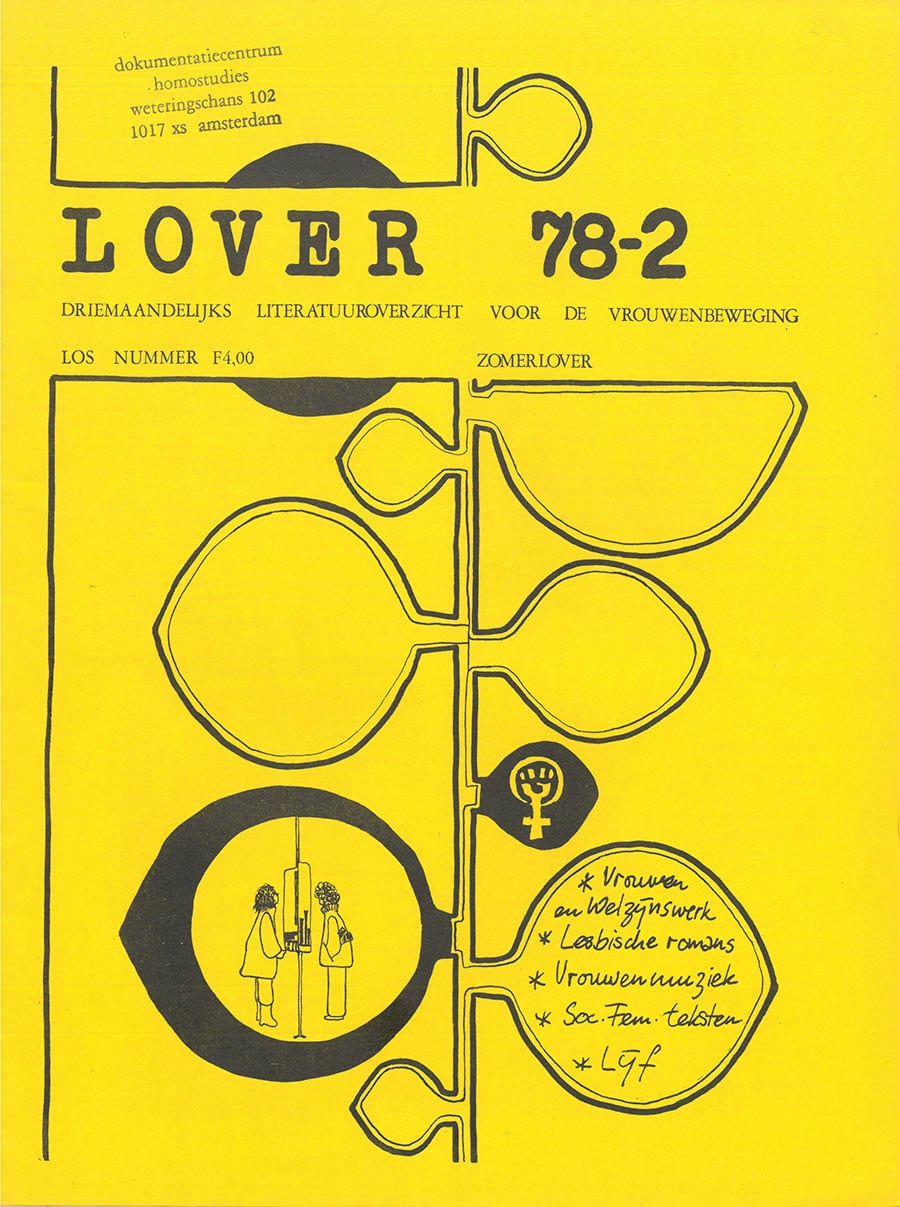
LOVER 1978-1, IHLIA LGBTI Heritage Collection
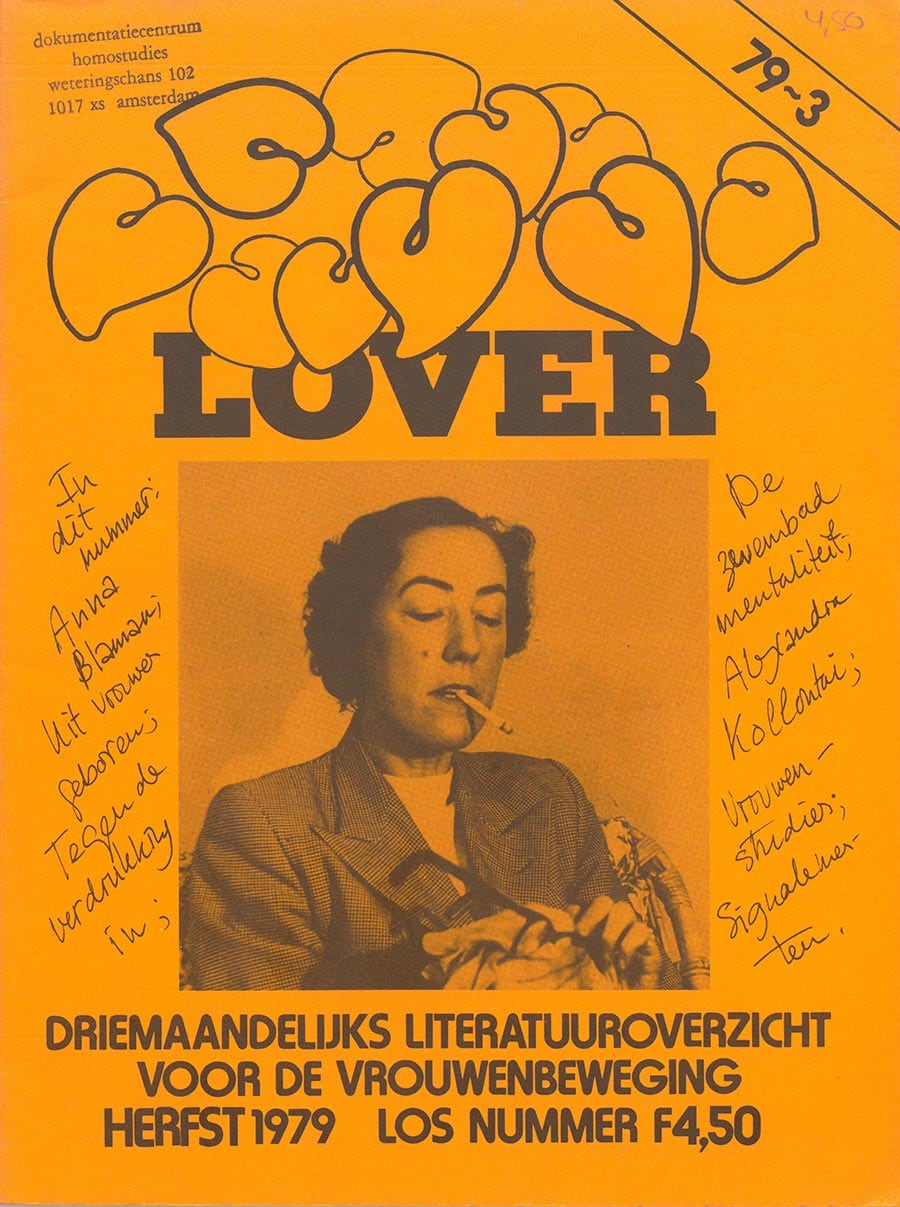
LOVER 1979-3, IHLIA LGBTI Heritage Collection
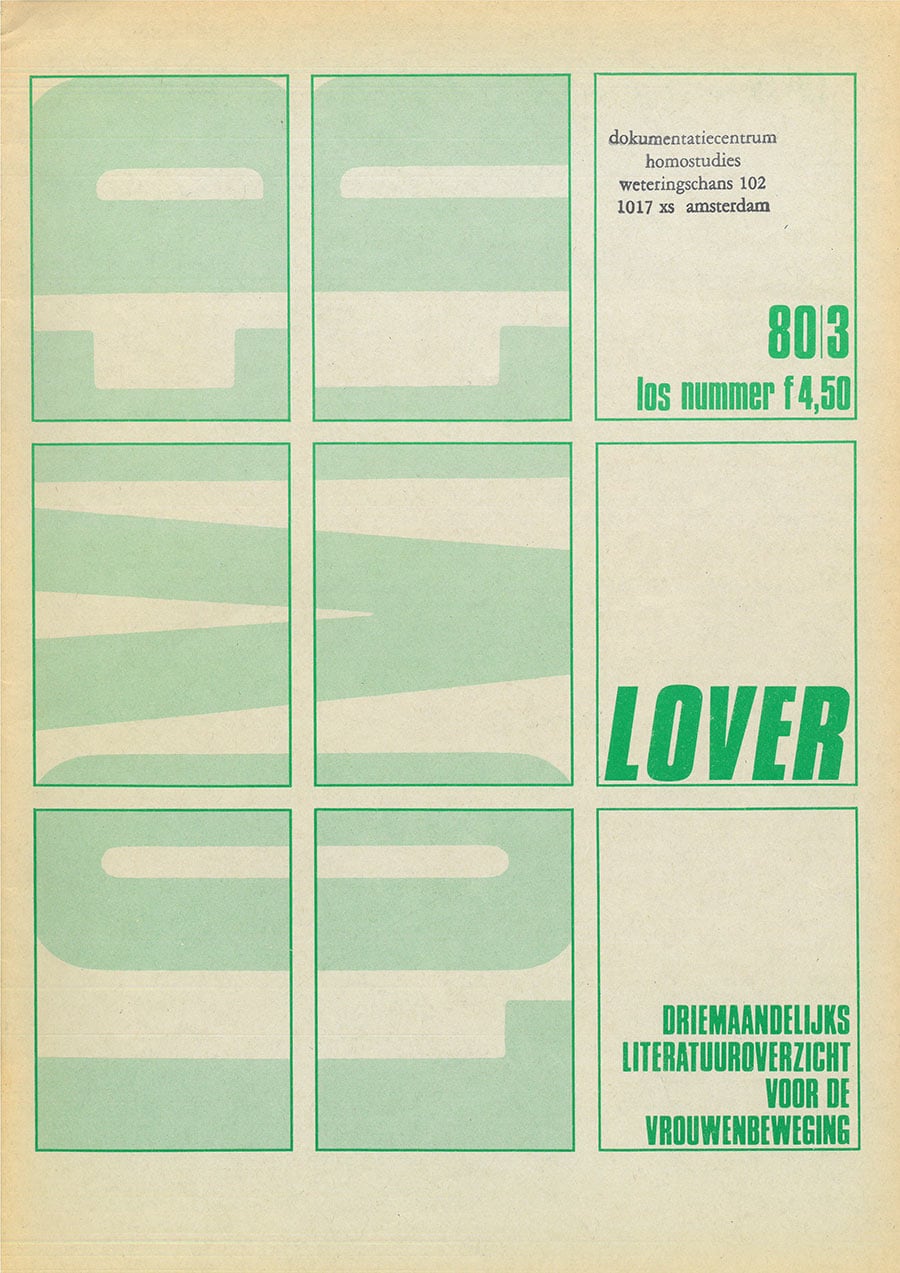
LOVER 1980-3, IHLIA LGBTI Heritage Collection
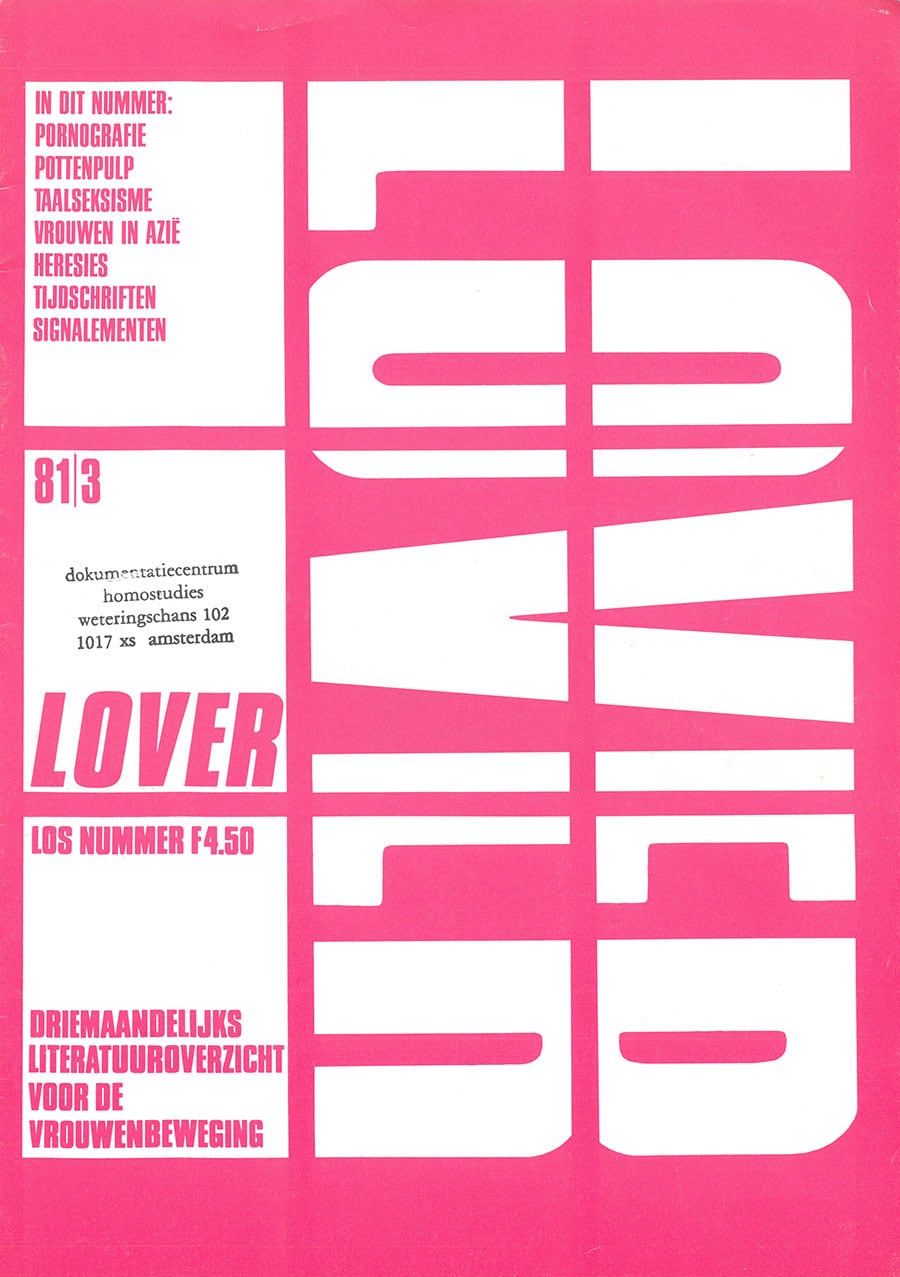
LOVER 1981-3, IHLIA LGBTI Heritage Collection
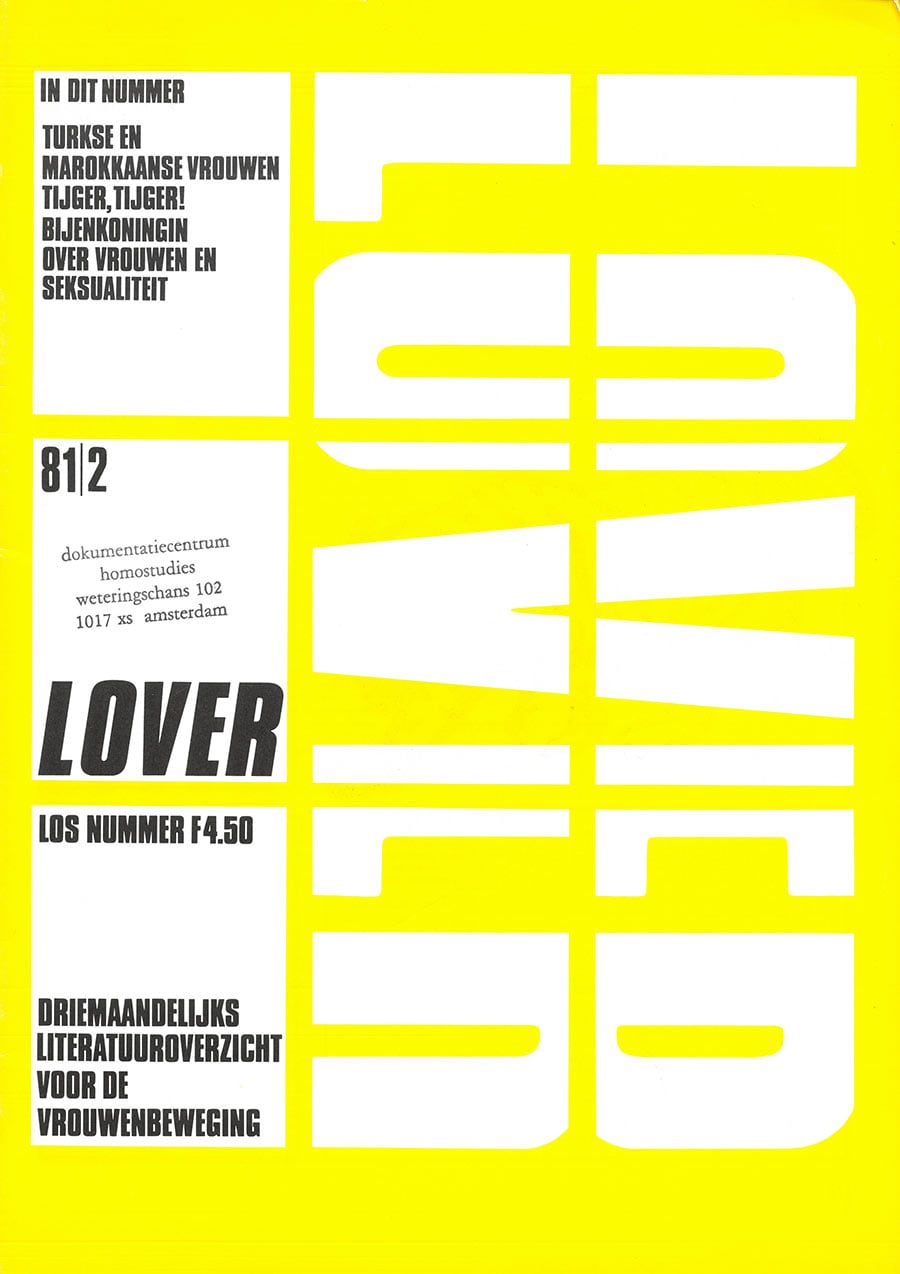
LOVER 1981-2, IHLIA LGBTI Heritage Collection

LOVER 1983-1, IHLIA LGBTI Heritage Collection
Feministiese uitgeverij de Bonte Was
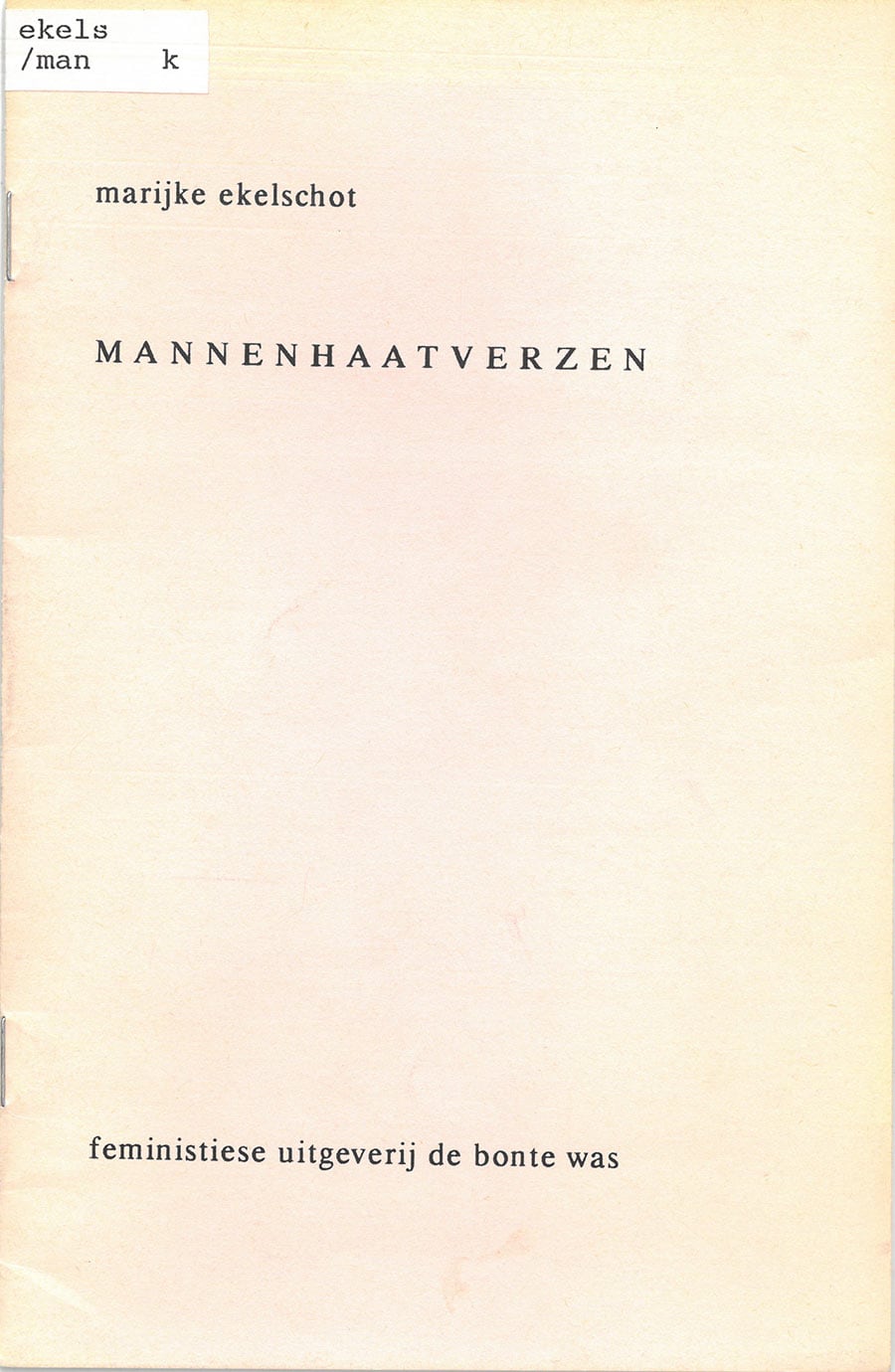
Mannenhaatverzen, Marijke Ekelschot, 1992 — 12p., IHLIA LGBTI Heritage Collection
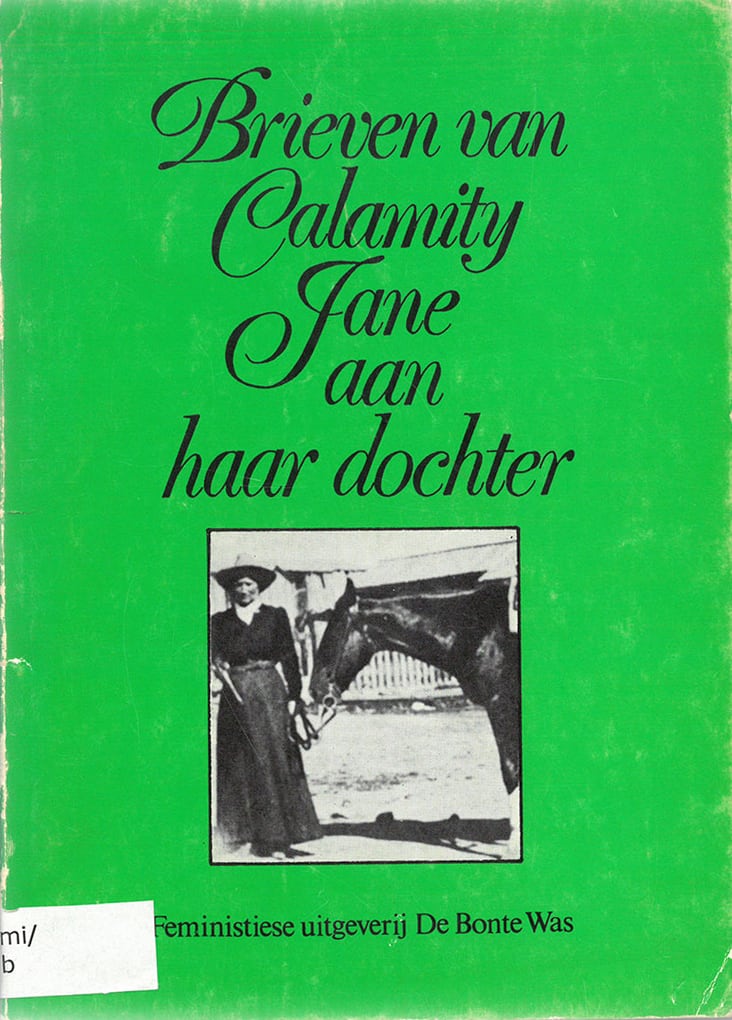
Brieven van Calamity Jane aan haar dochter, Calamity Jane, 1977 - 55 p., IHLIA LGBTI Heritage Collection
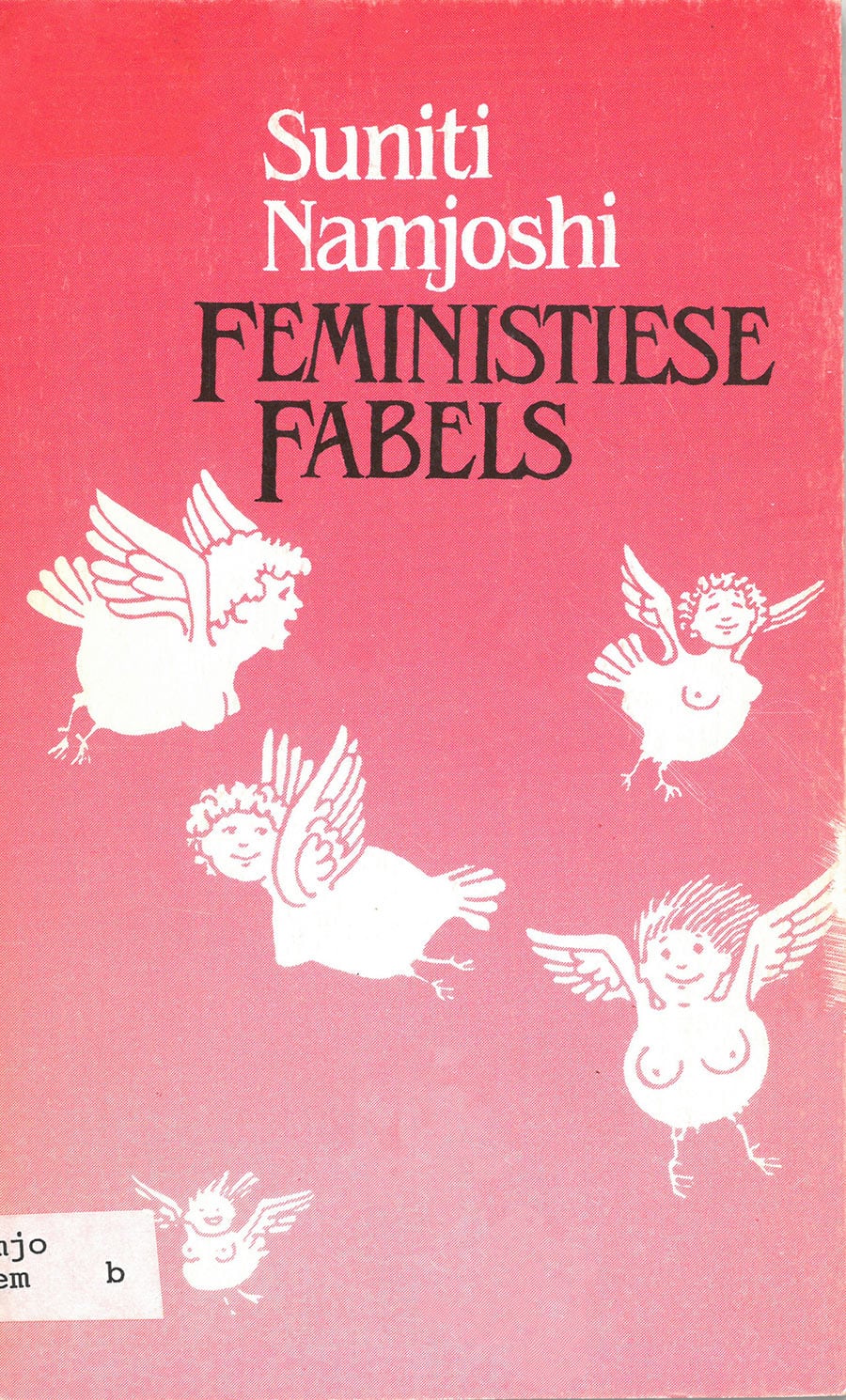
Feministiese fabels, Suniti Namjoshi, 1983 — 97p., IHLIA LGBTI Heritage Collection
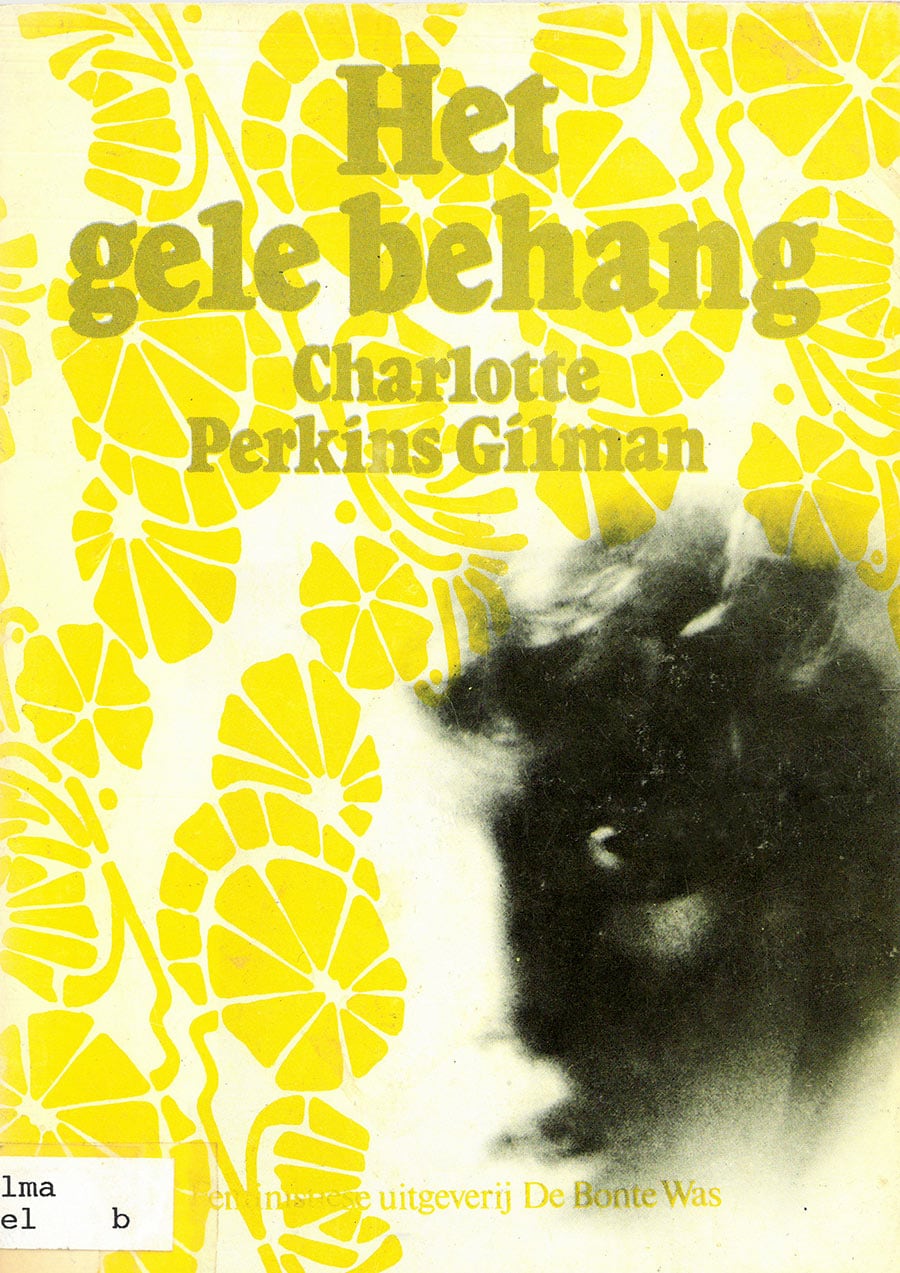
Het gele behang Charlotte Perkins Gilman, 1977 — 45p., IHLIA LGBTI Heritage Collection
Ashanti — Surinaamse Vrouwenkrant
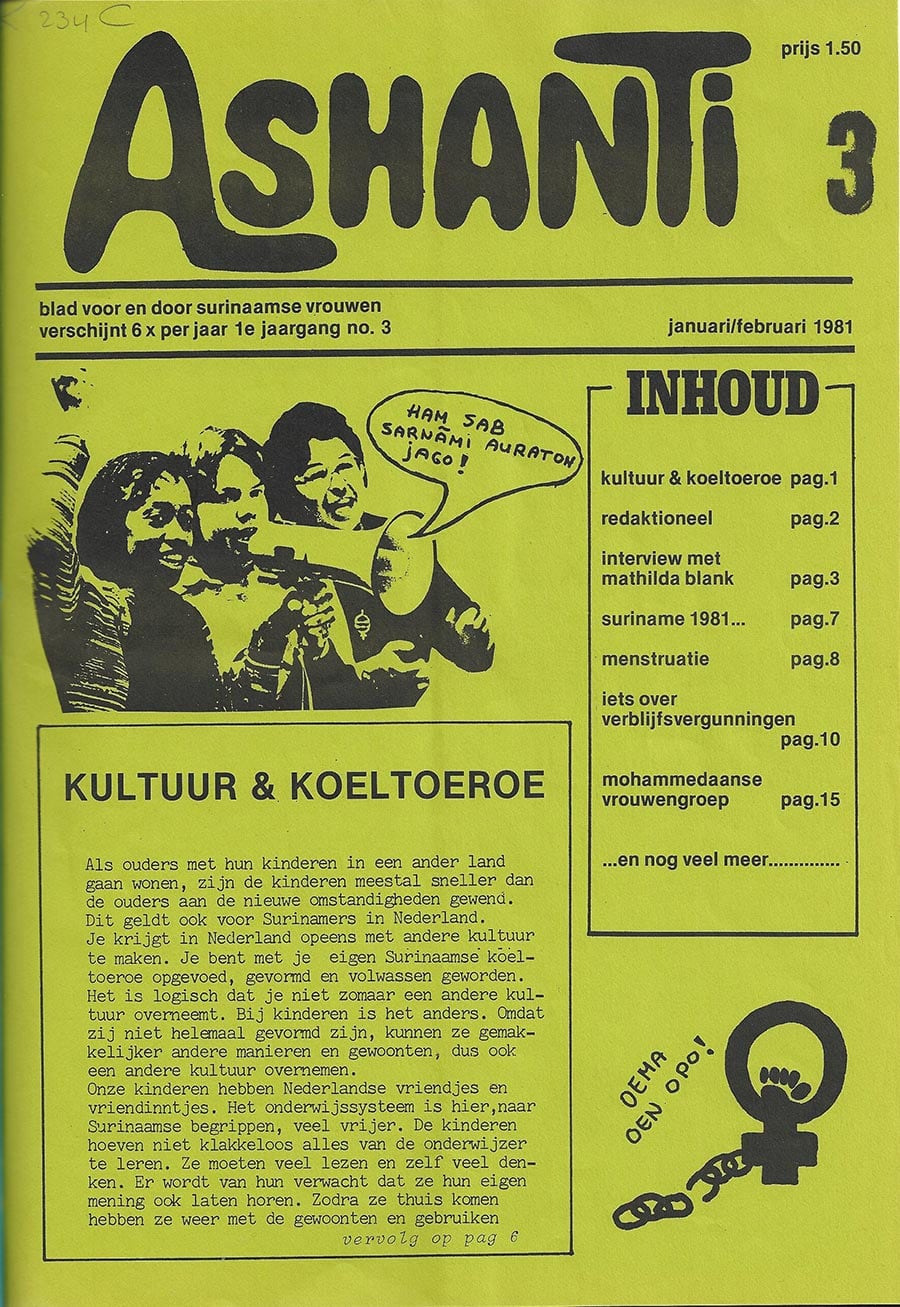
Ashanti, blad voor en door surinaamse vrouwen, Jan/Feb 1981, from https://www.sarnamihuis.nl/posts-ihm2021/
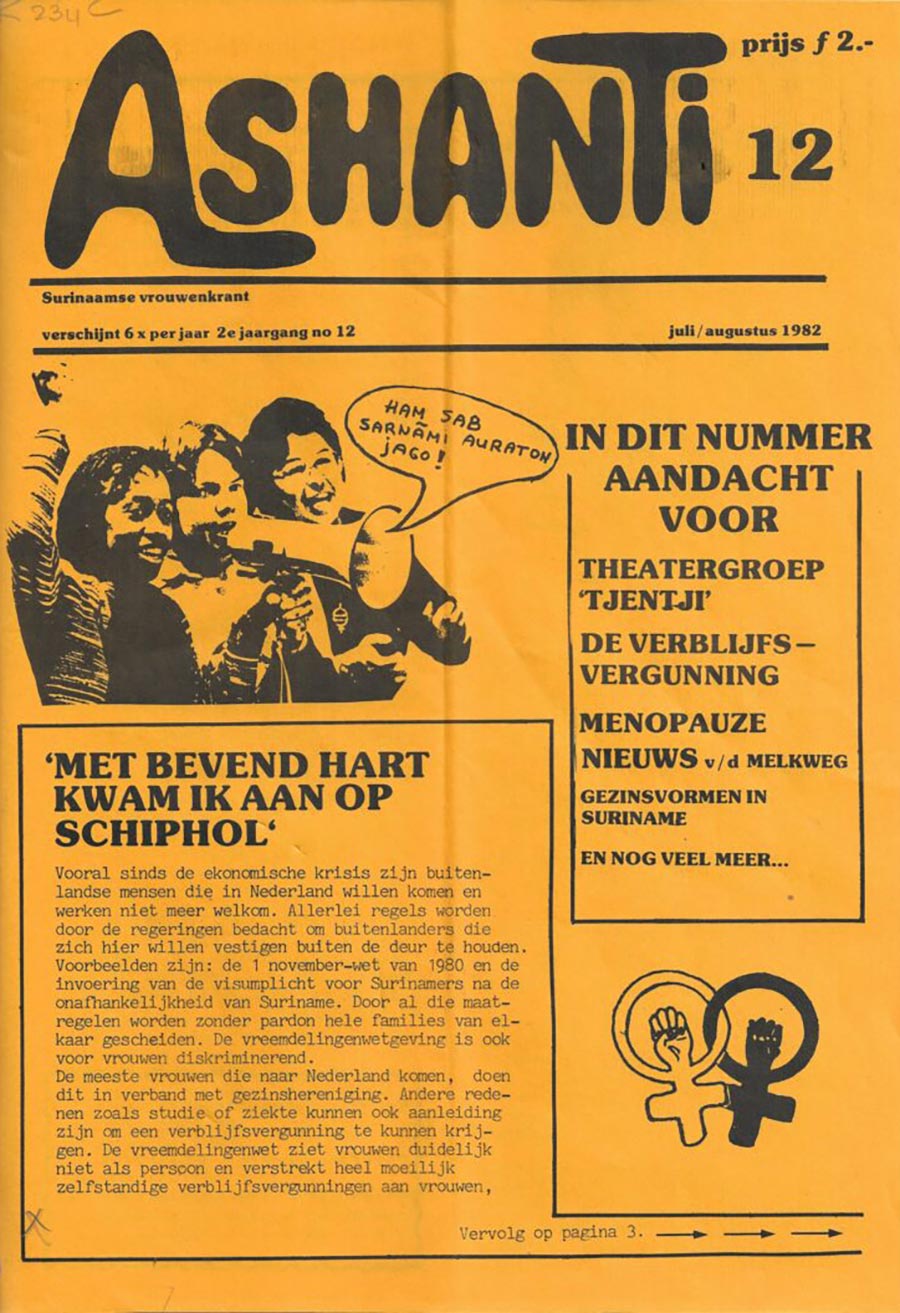
Ashanti, Surinaamse Vrouwenkrant, Jul/Aug 1982, from https://www.sarnamihuis.nl/posts-ihm2021/
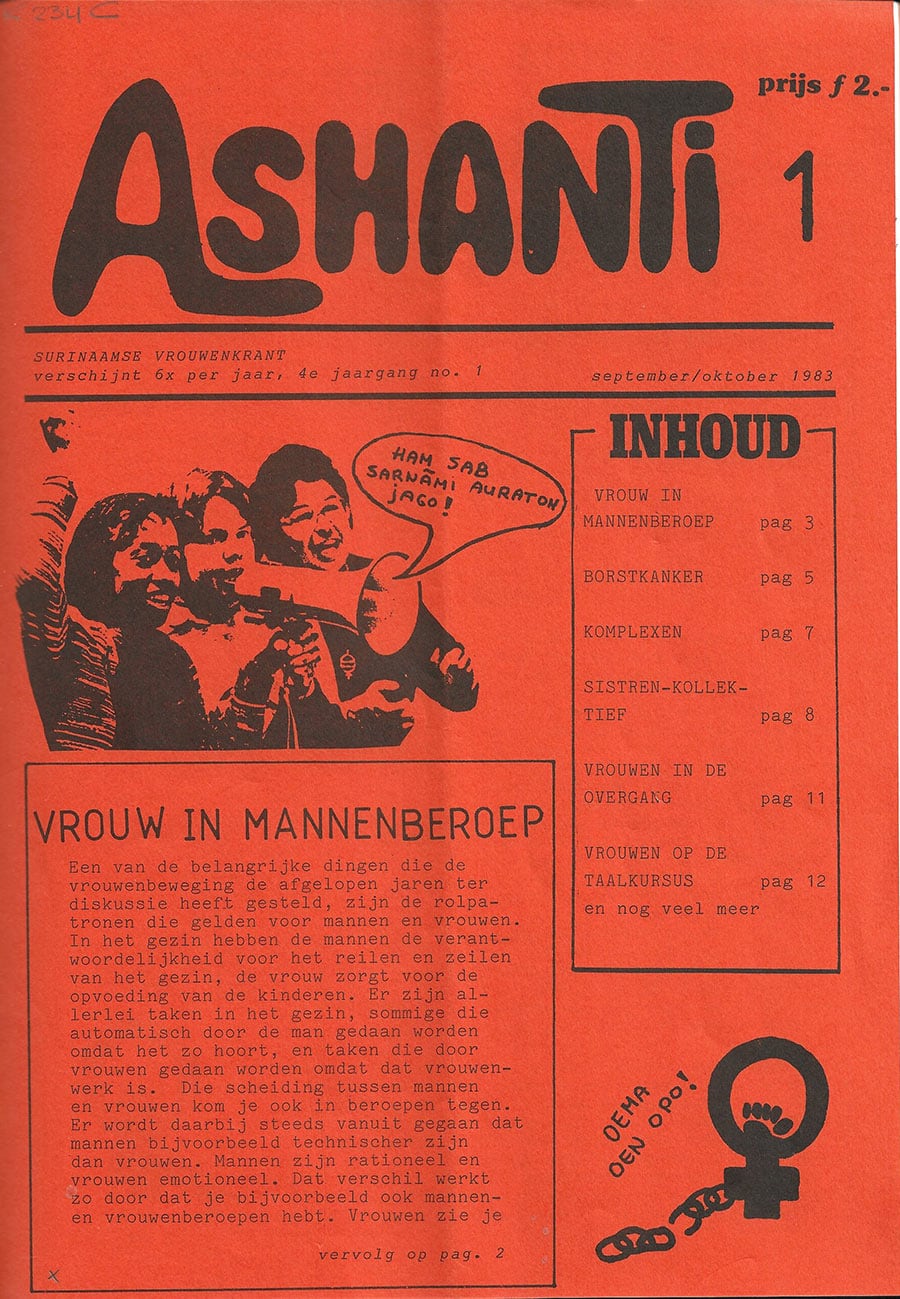
Ashanti, Surinaamse Vrouwenkrant, Sept/Oct 1983, from https://www.sarnamihuis.nl/posts-ihm2021/
Lust & Gratie

Gedwongen heteroseksualiteit en lesbisch bestaan [Compulsory Heterosexuality and Lesbian Existence], Adrienne Rich, [translation from English: Pamela Pattynama], Stichting Lust en Gratie, 1981 - 43 p., IHLIA LGBTI Heritage Collection
Atalanta
All of the images are from https://www.at-a-lanta.nl/
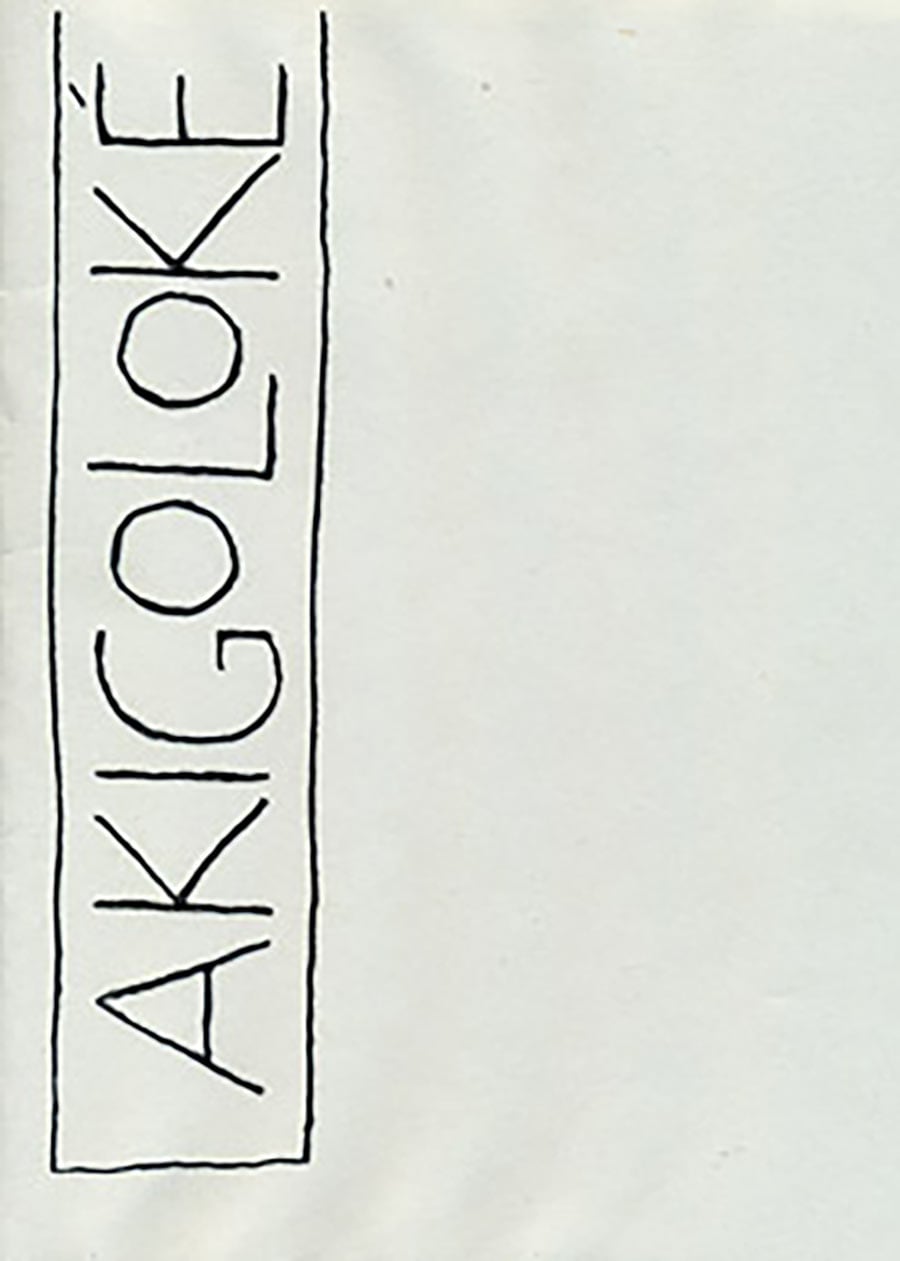
Akigoloké, with Michèl Post, 1991 — 38p.

Alle Dieren Vrijt, compiled by P'tje Lanser and Rymke Wiersma, 1992 — 200p.
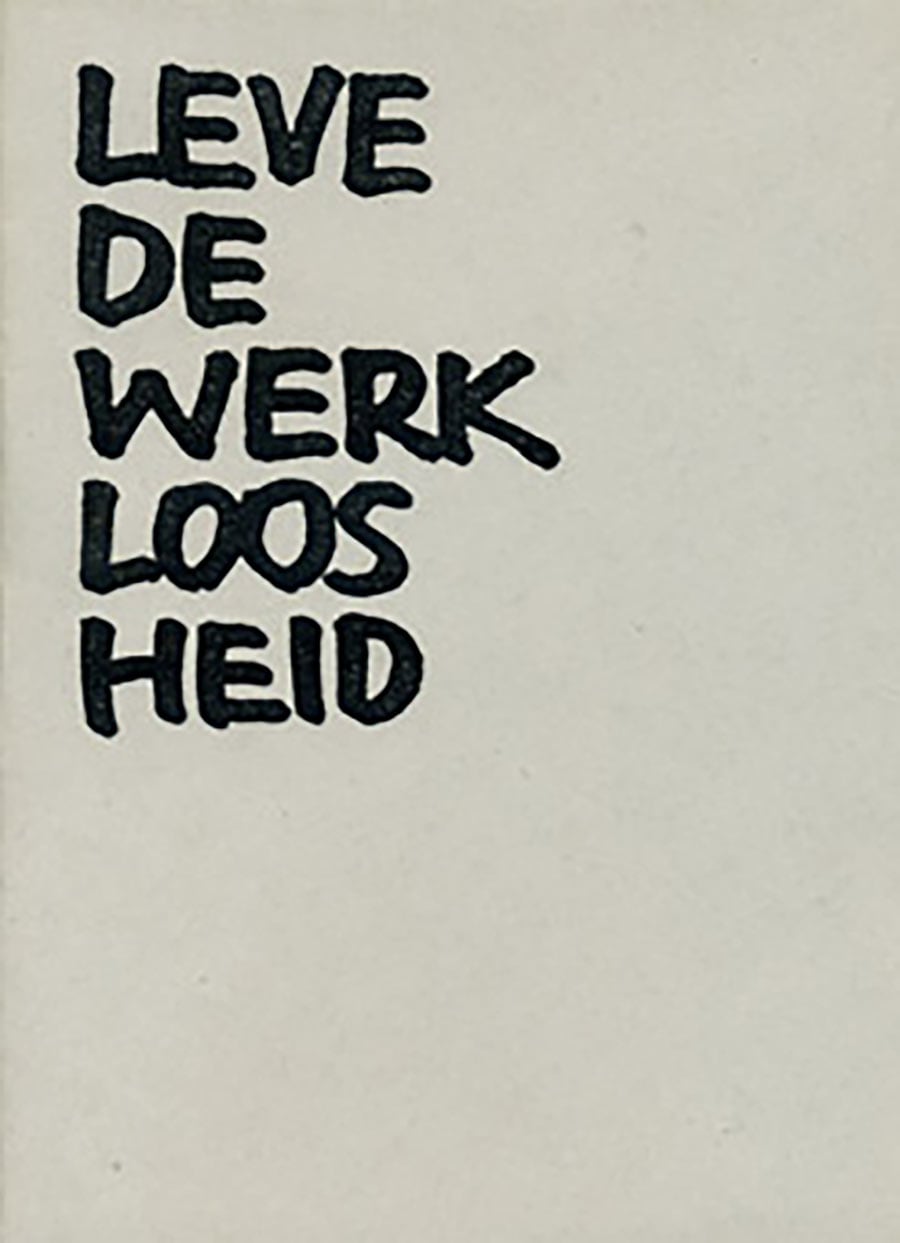
Leve de werkloosheid, 1996 — 28p.
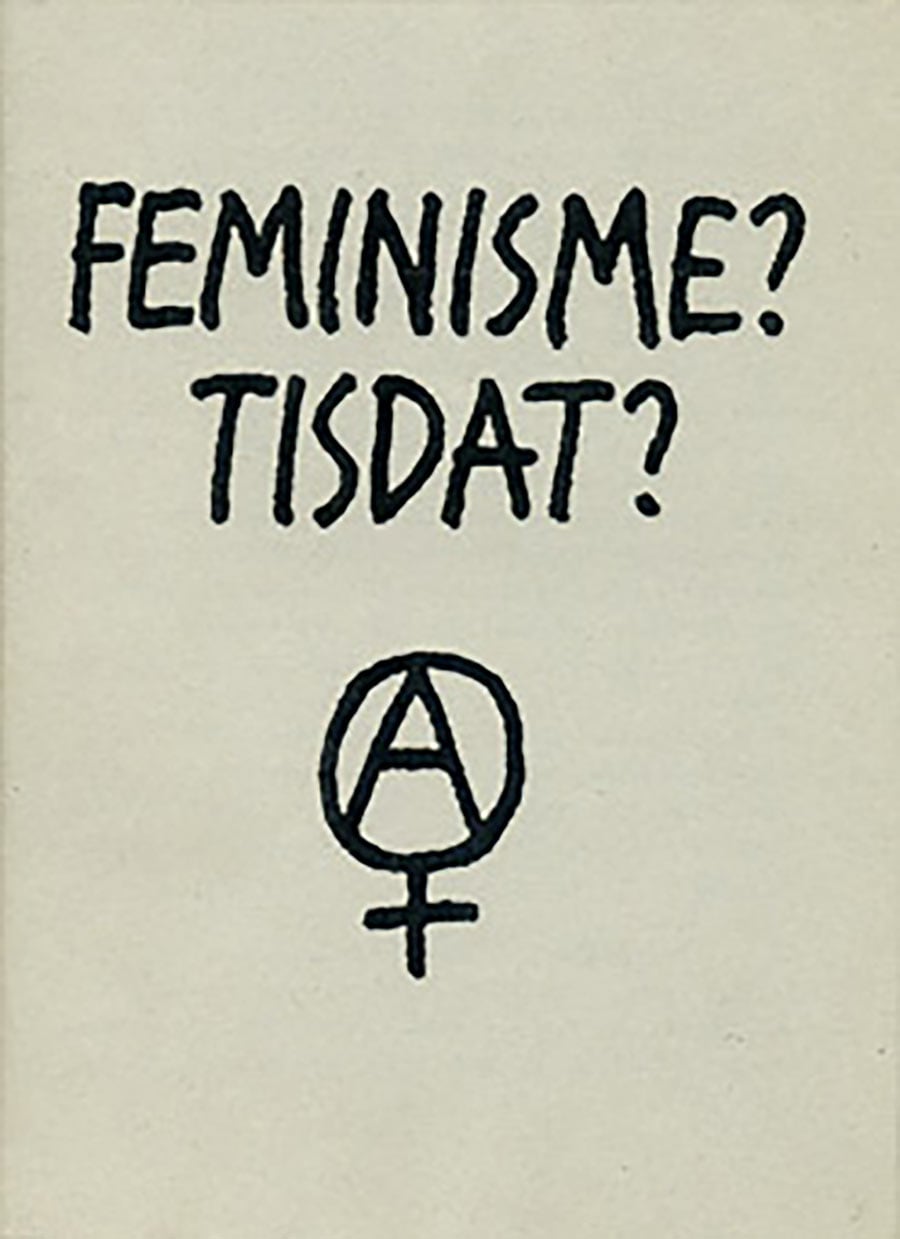
Feminisme? Tisdat?, 2003 — 16p.
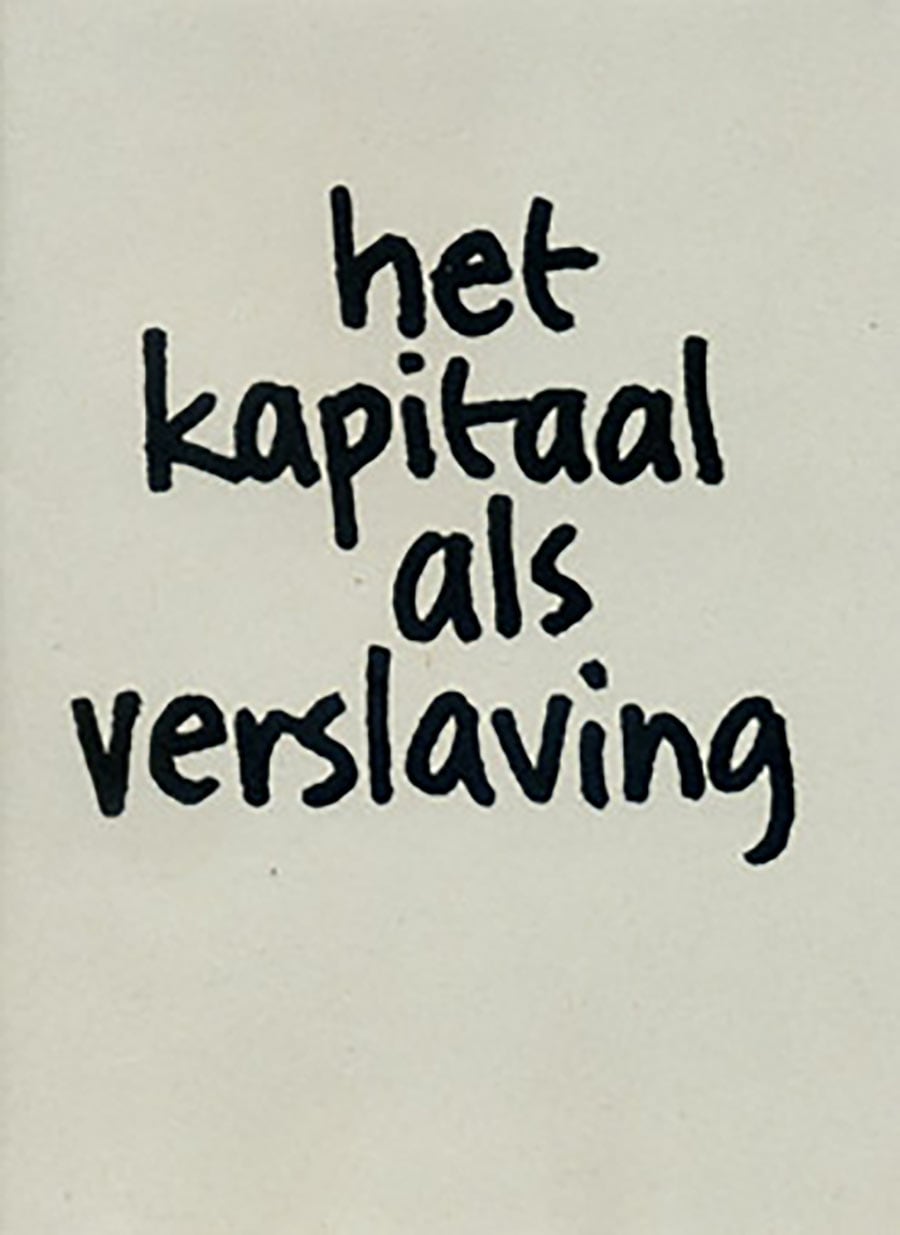
Het kapitaal als verslaving,2011 — 16p.
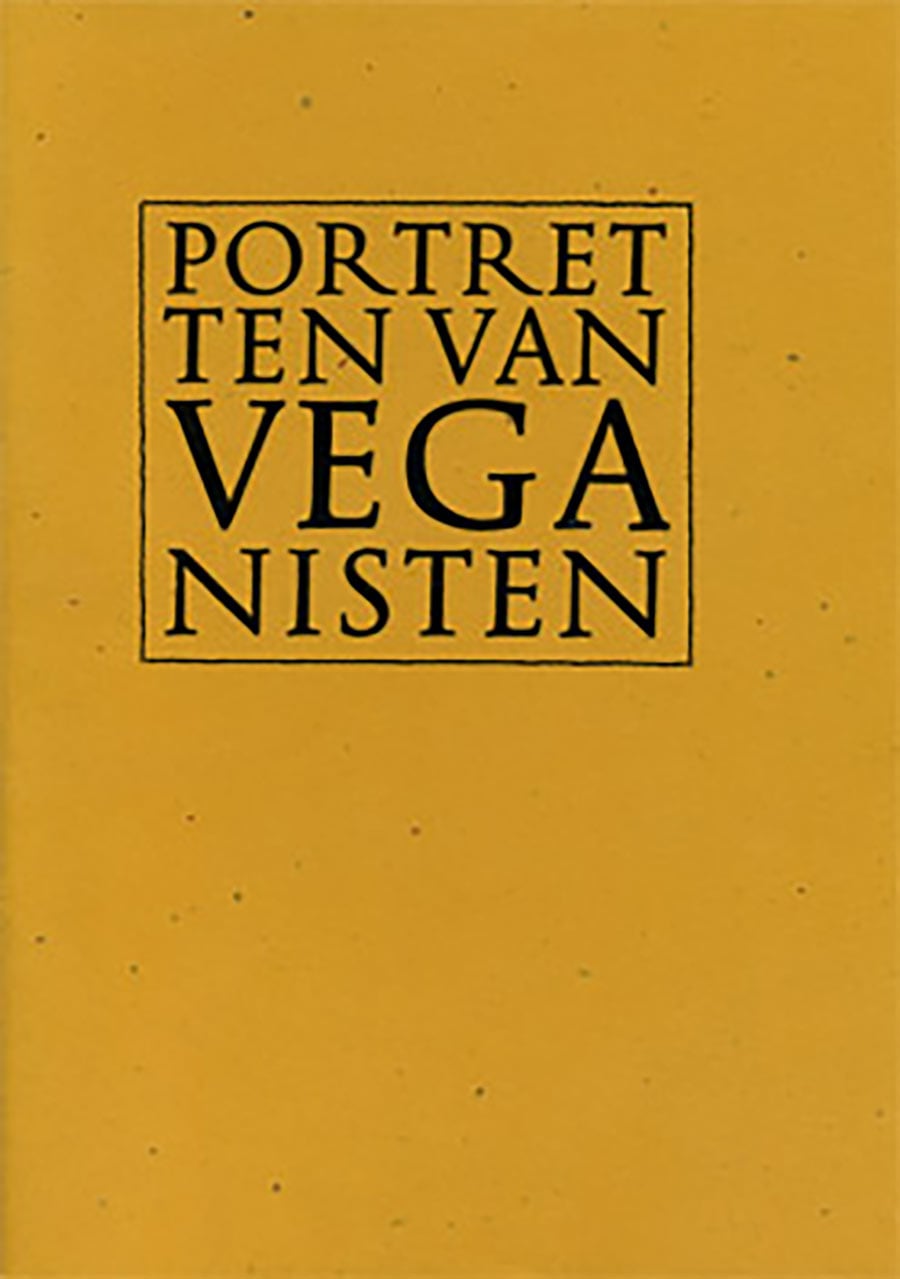
Portretten van veganistenPeter (P'tje) Lanser, 2006 — 52p.
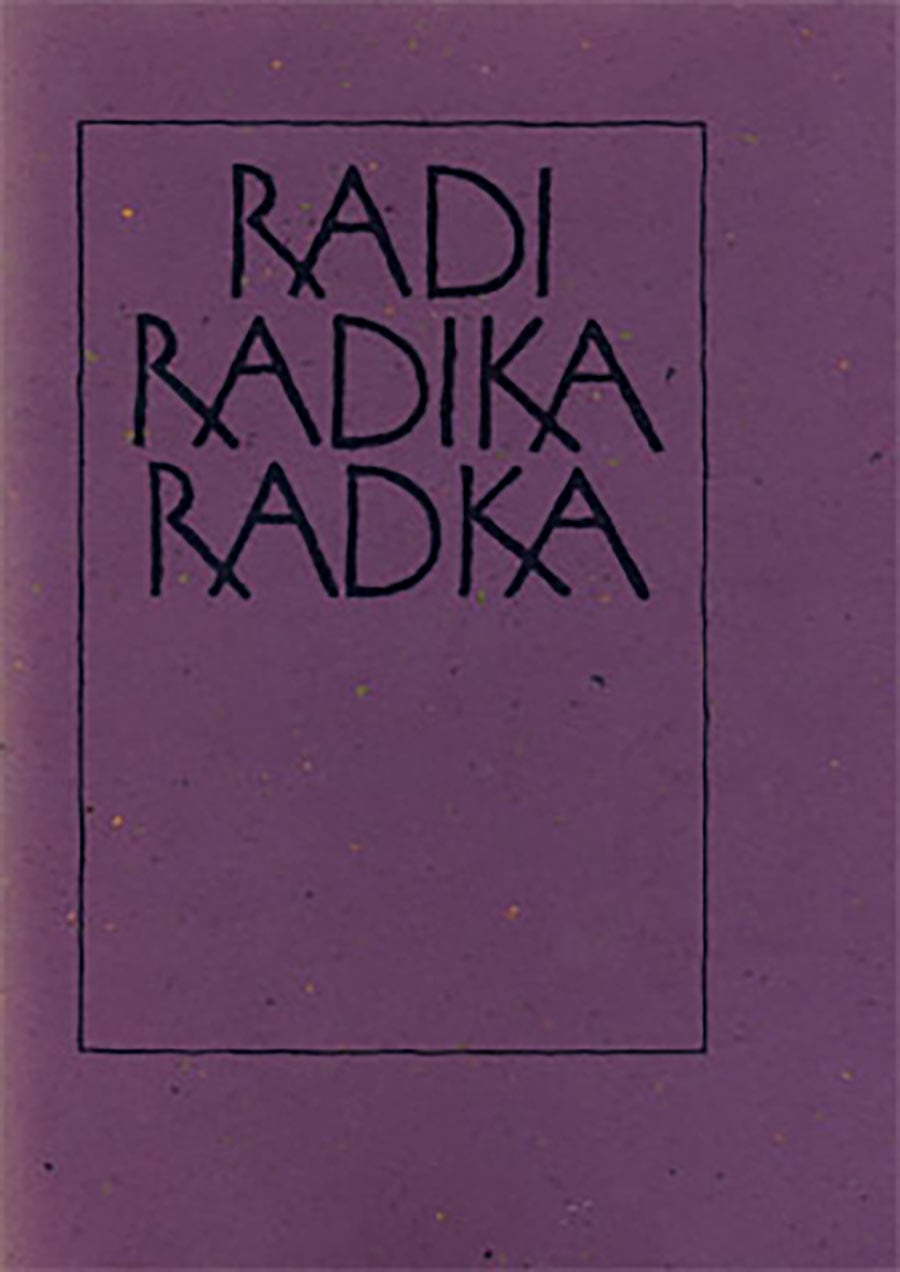
Radi, Radika, Radka,Rymke Wiersma, 1997 — 48p.
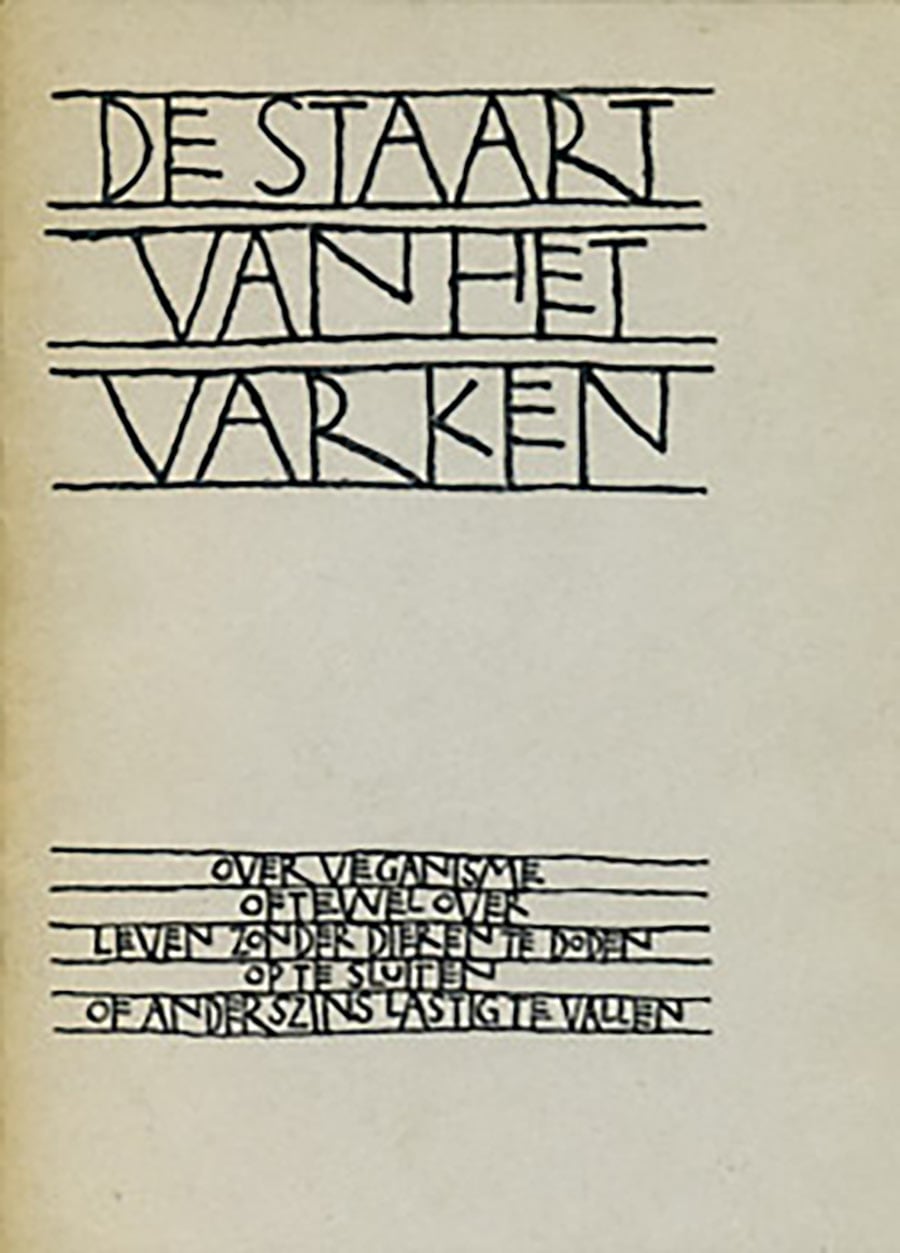
De staart van het varken, Atalanta, 1998 — 35p.
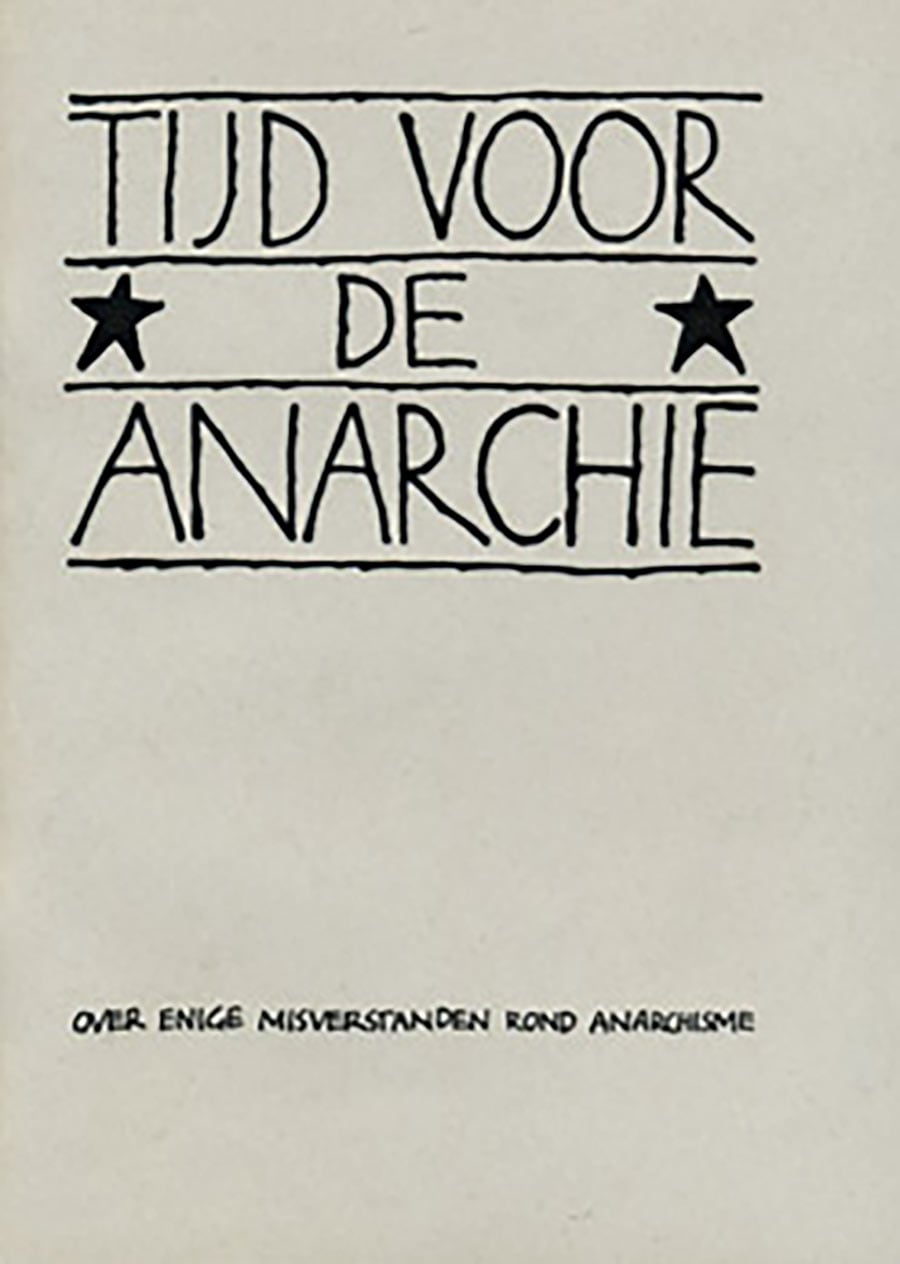
Tijd voor de Anarchie, Weia Reinboud, 1991 — 23p.
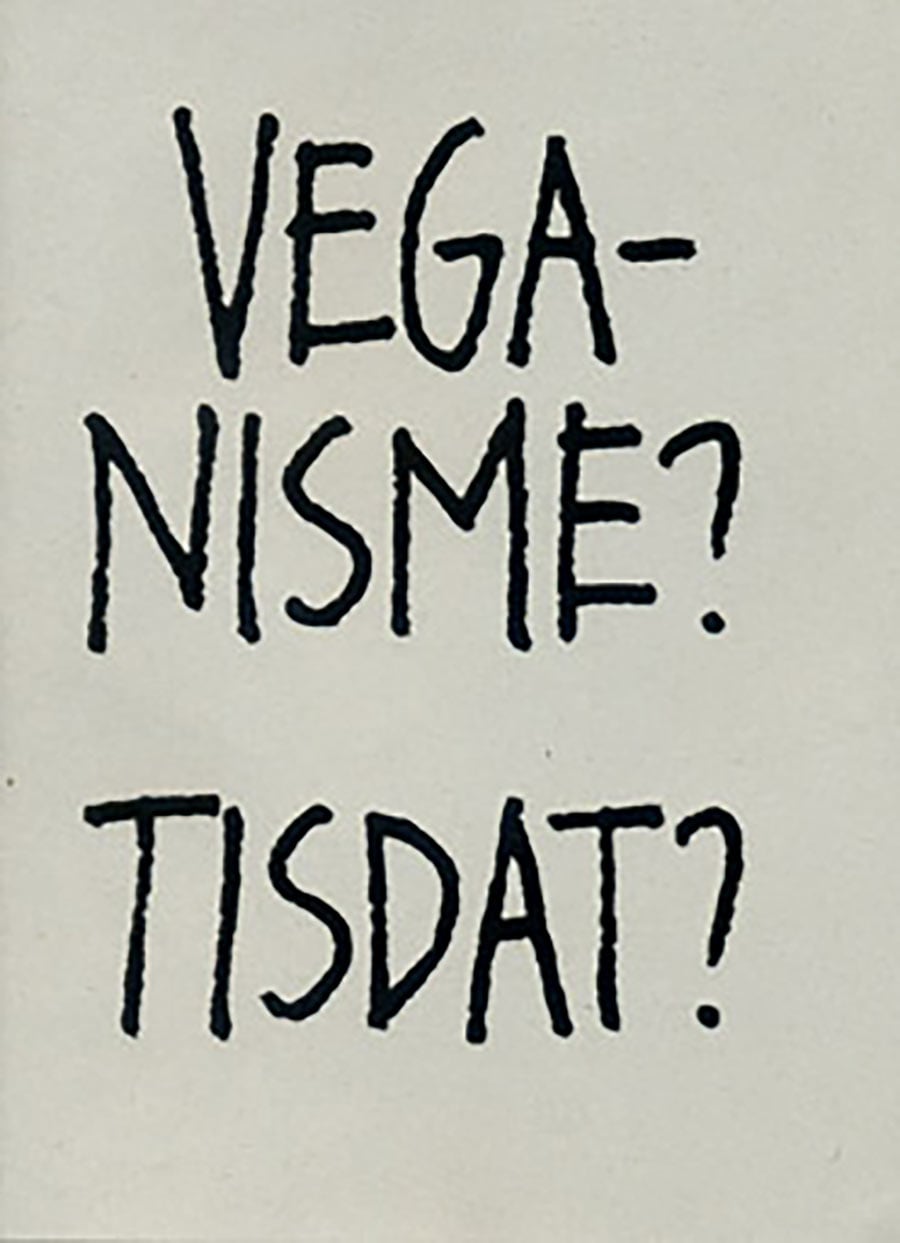
Veganisme? Tisdat?, 2002 — 16p.

Vleermuizen?, Atalanta, 2005 — 42p.
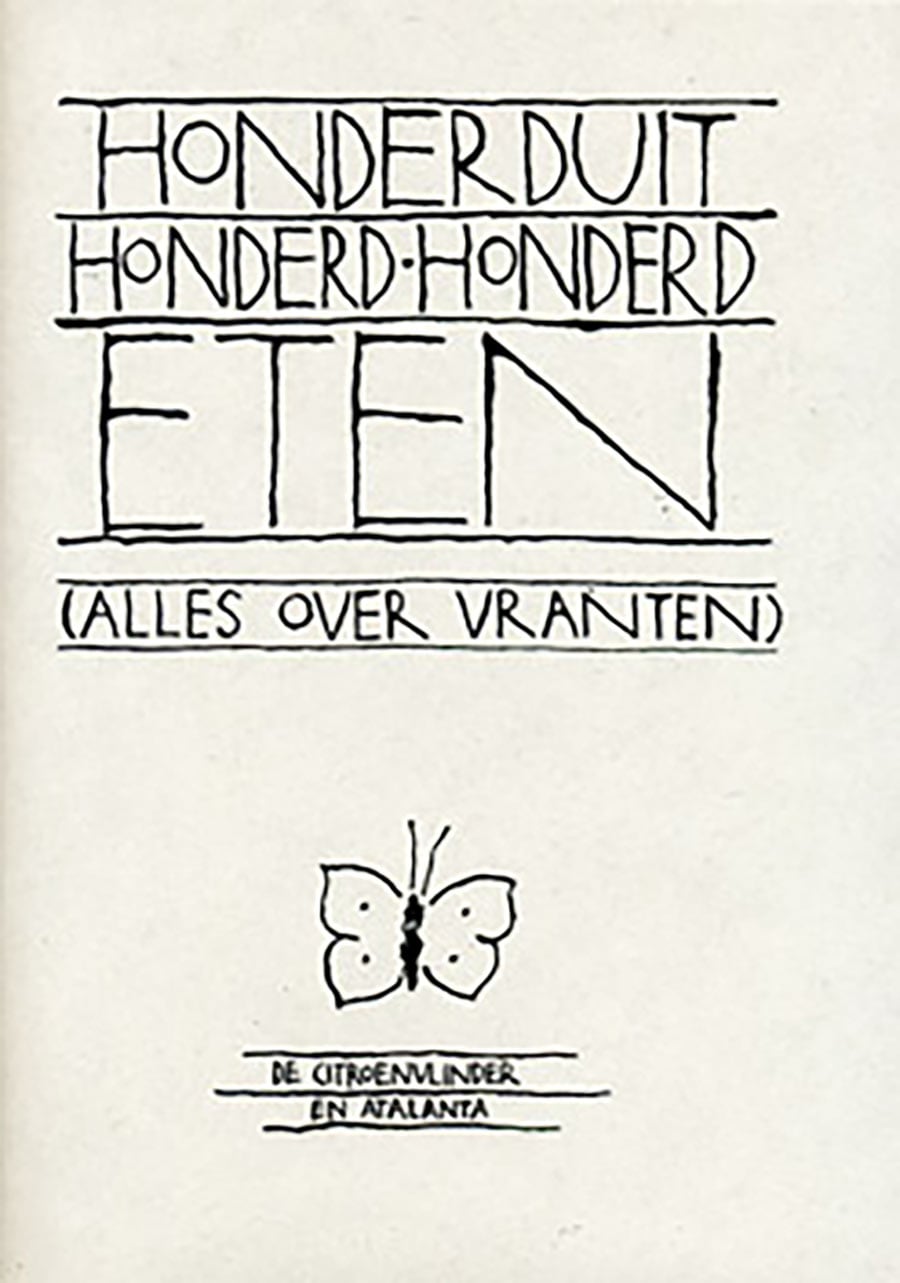
Honderduit honderd-honderd eten, De Citroenvlinder, 1990 — 51p.
Zwarte — Vrouwenkrant
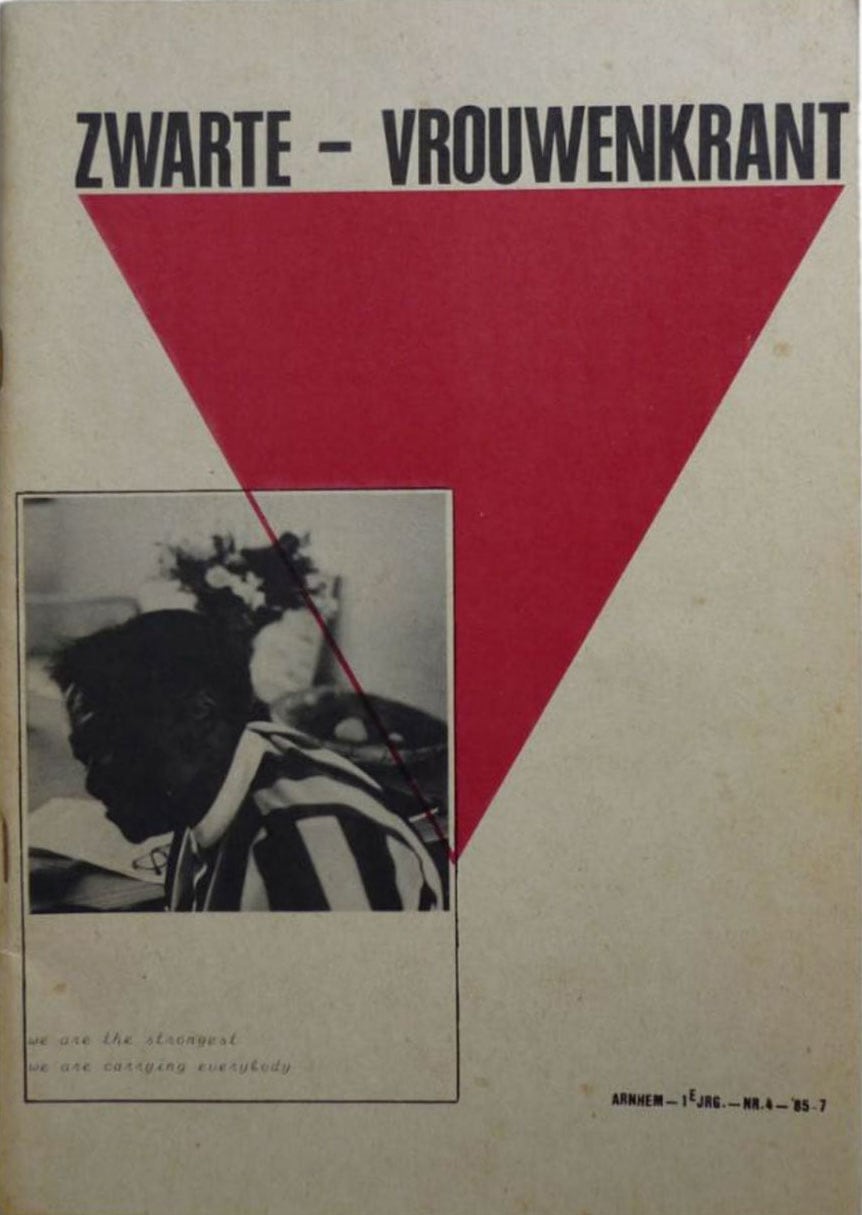
Zwarte — Vrouwenkrant, nr.4, printed by Atalanta, 1985, Atalanta’s personnal archive
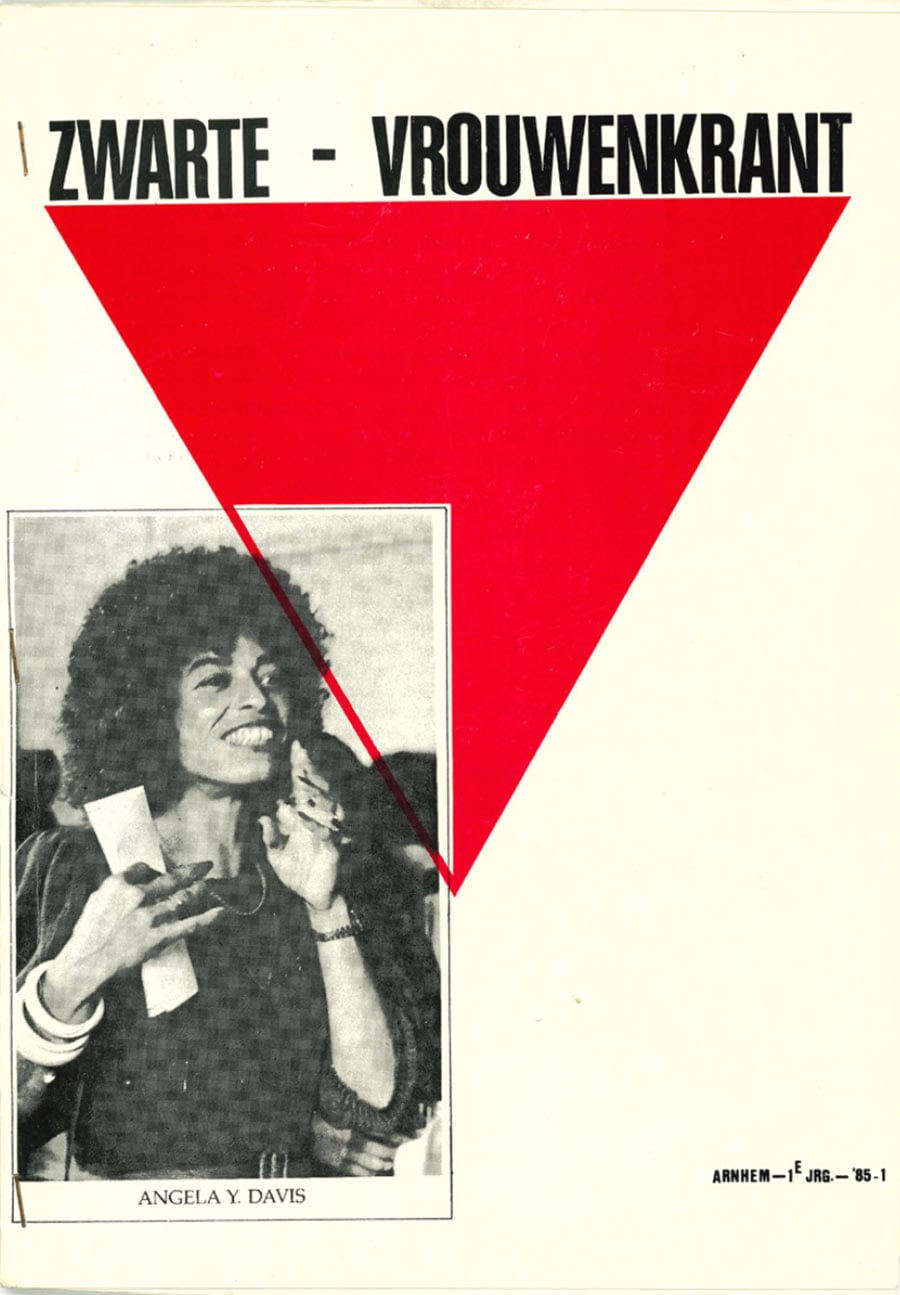
Zwarte — Vrouwenkrant, nr.1, 1985, Collection IAV-Atria
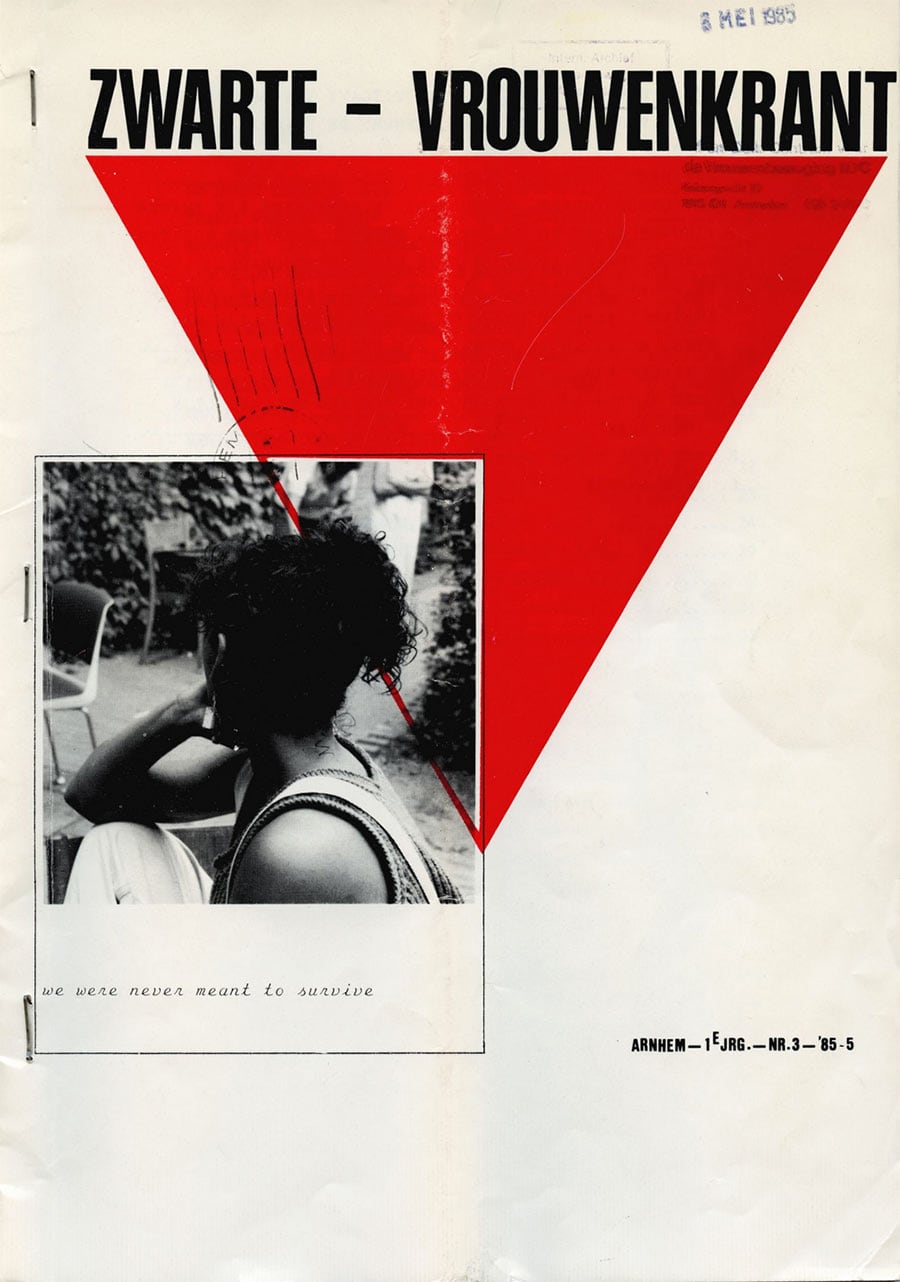
Zwarte — Vrouwenkrant, nr.5, 1985, Collection IAV-Atria
Feministische Uitgeverij Sara
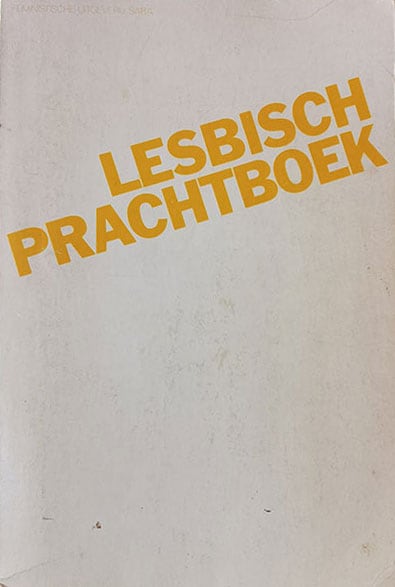
Lesbisch prachtboek,red.: Maaike Meijer ... [et al.], 1979 - 365 p.
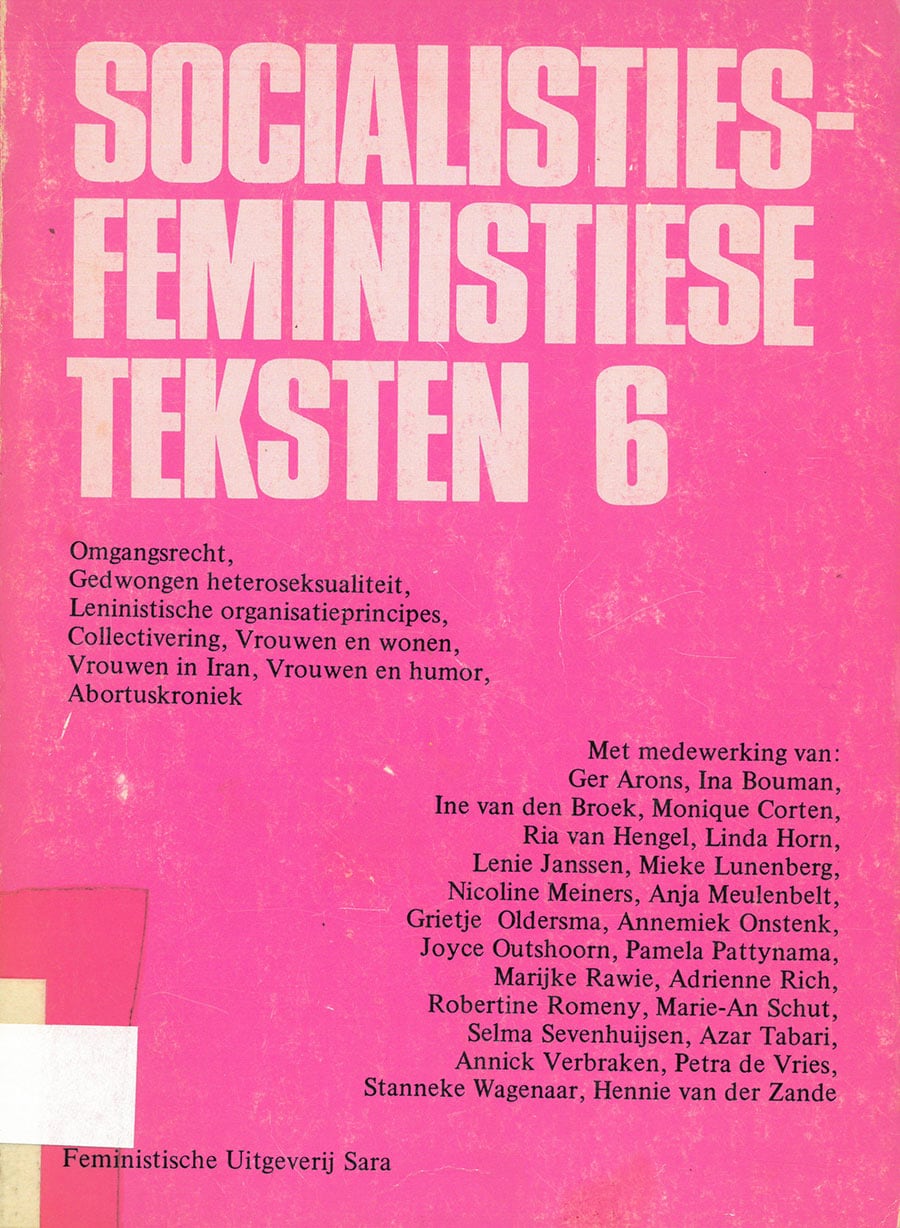
Socialisties-feministiese teksten n°6,1981
Katijf
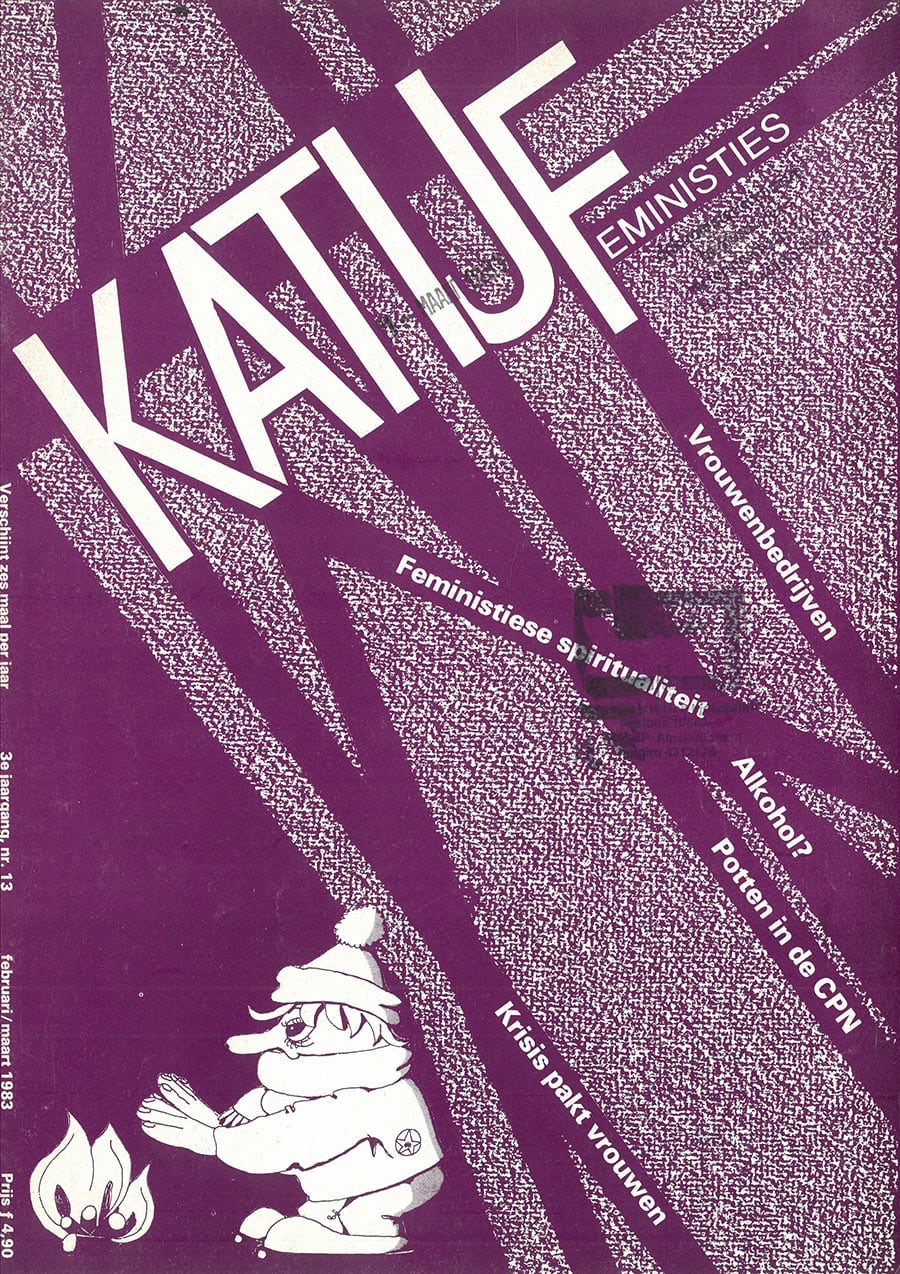
Katijf, n.13, Feb/March 1983, LGBTI Heritage Collection
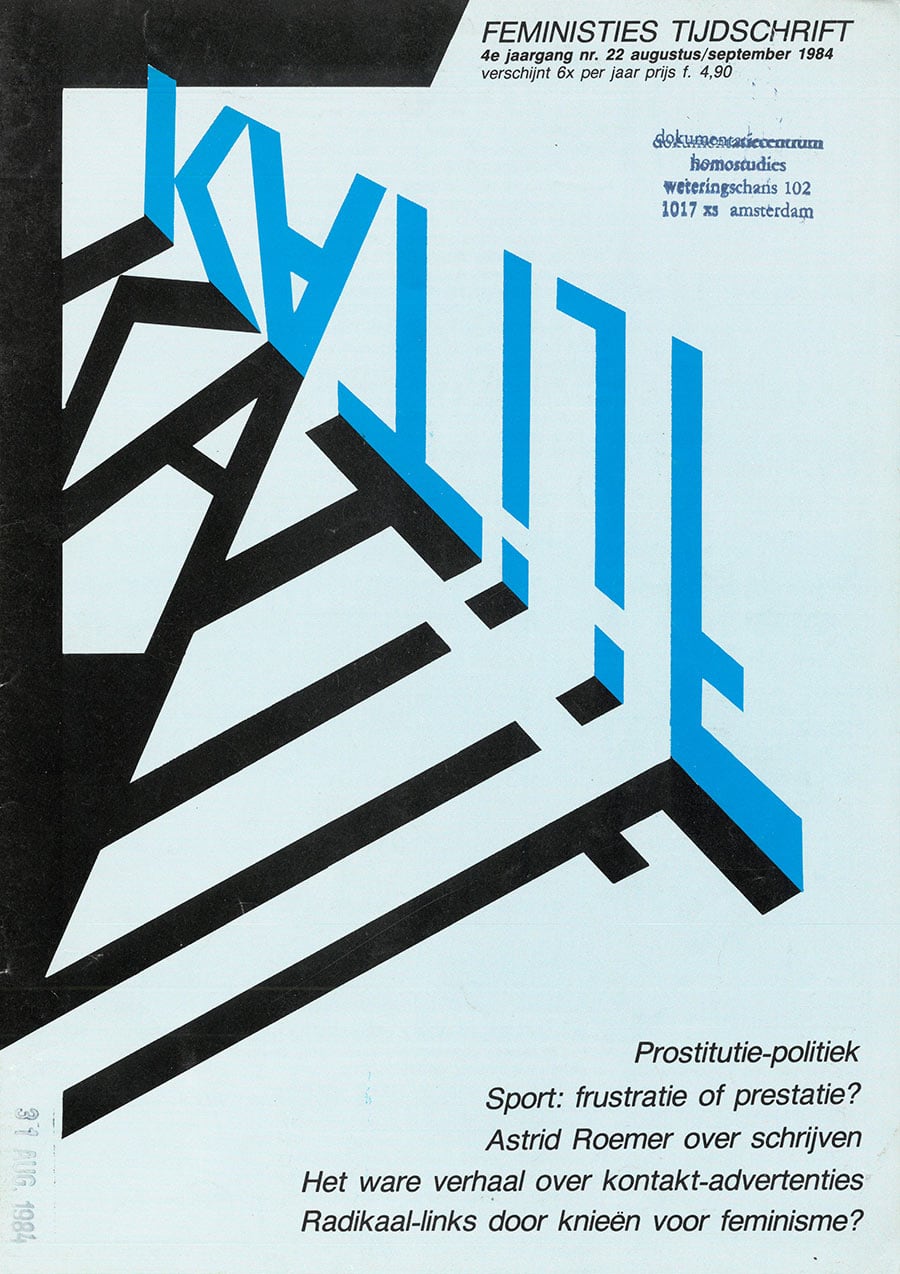
Katijf, n.22, Aug/Sept 1984, LGBTI Heritage Collection
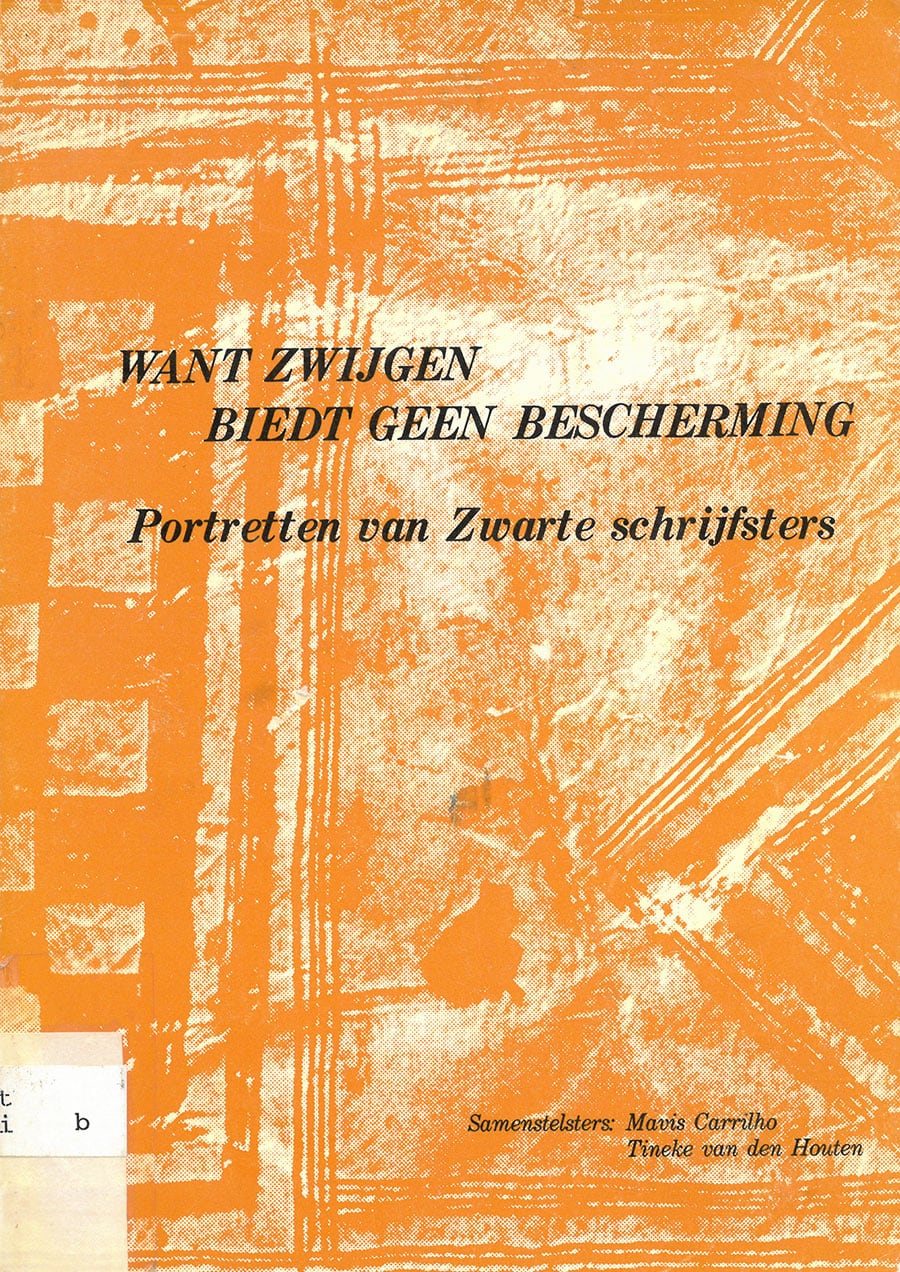
PWant Zwijgen biedt geen bescherming, Portretten van Zwarte schrijfsters, 1985 , LGBTI Heritage Collection
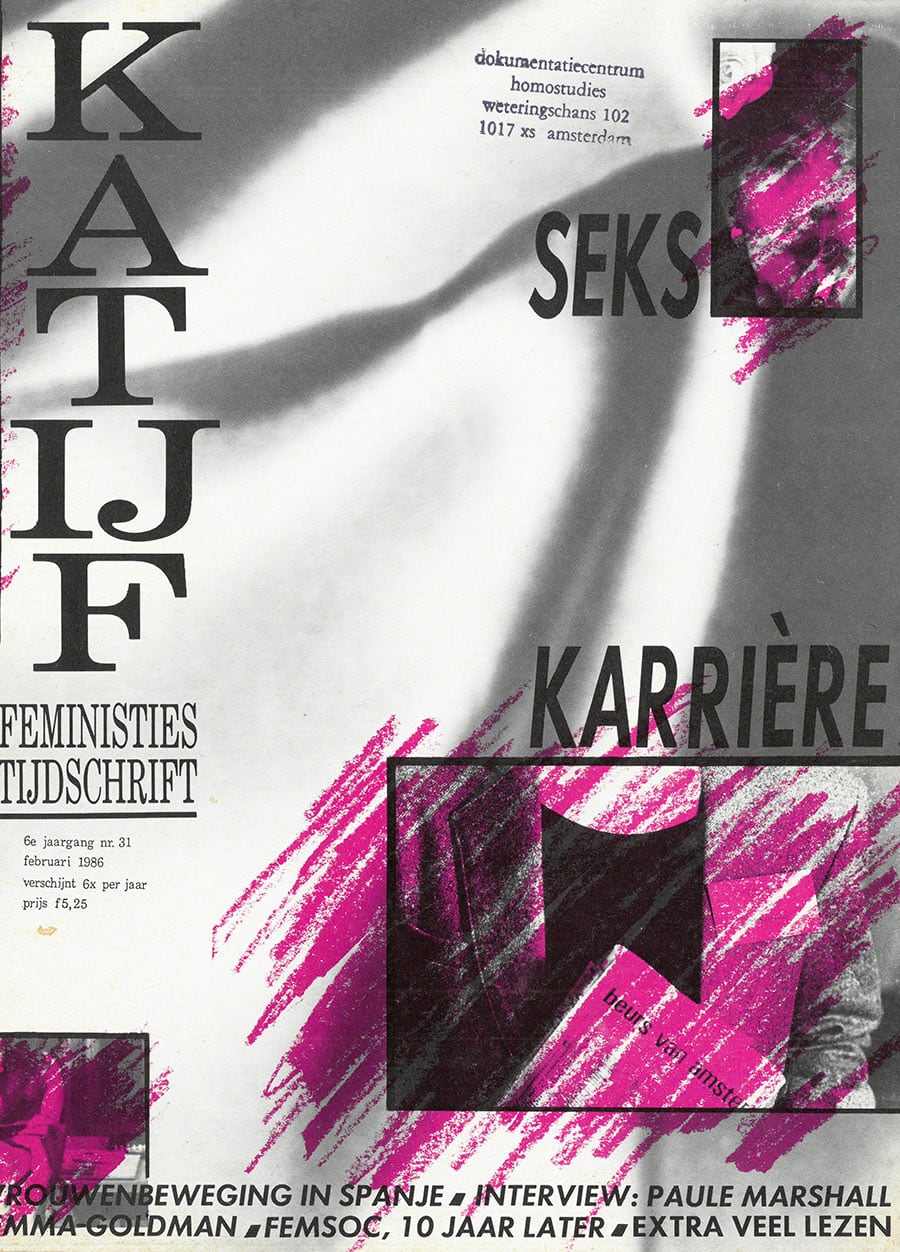
Katijf, nr.31, Feb 1986, LGBTI Heritage Collection
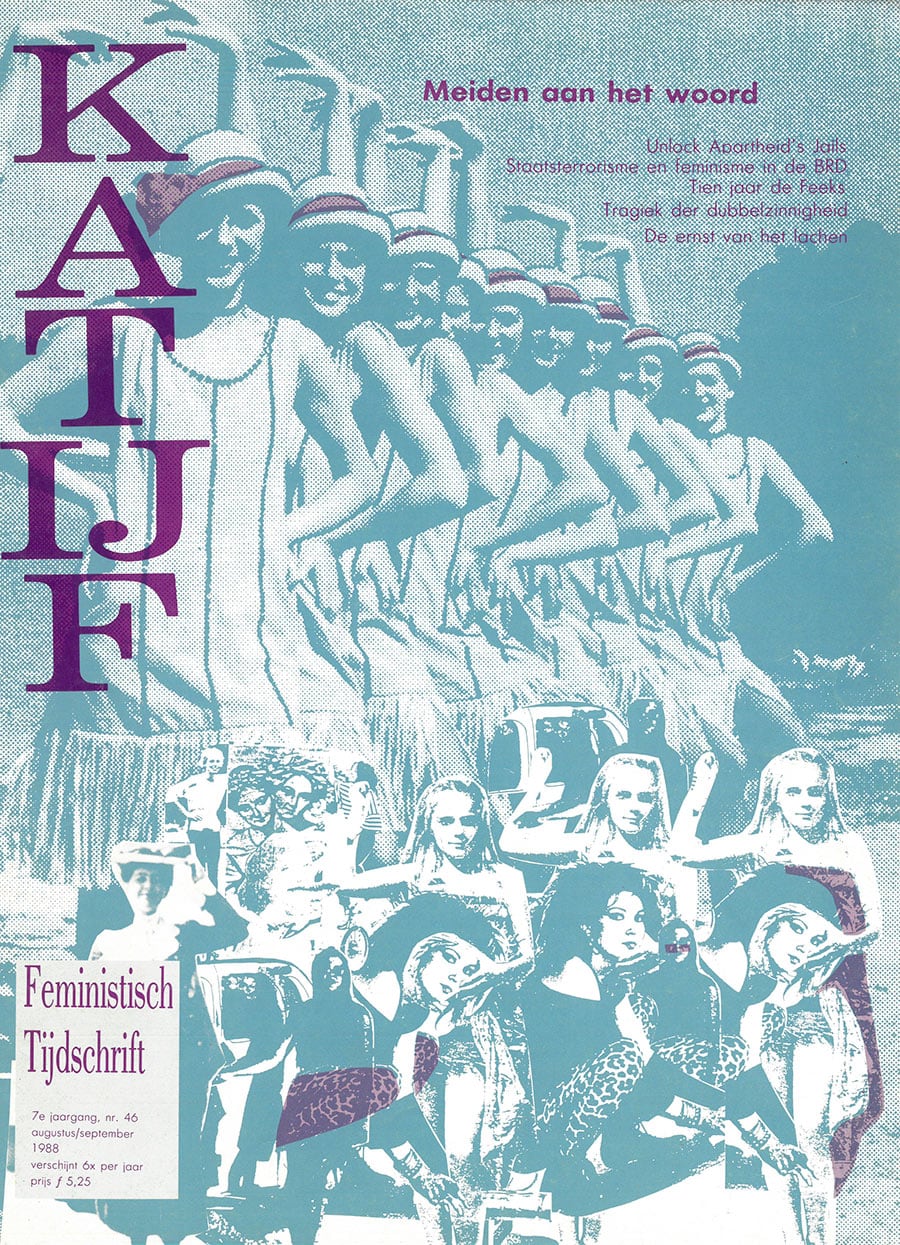
Katijf, nr.46, Aug/Sept 1986, LGBTI Heritage Collection
Sappho — Maanblad voor vriendinnen
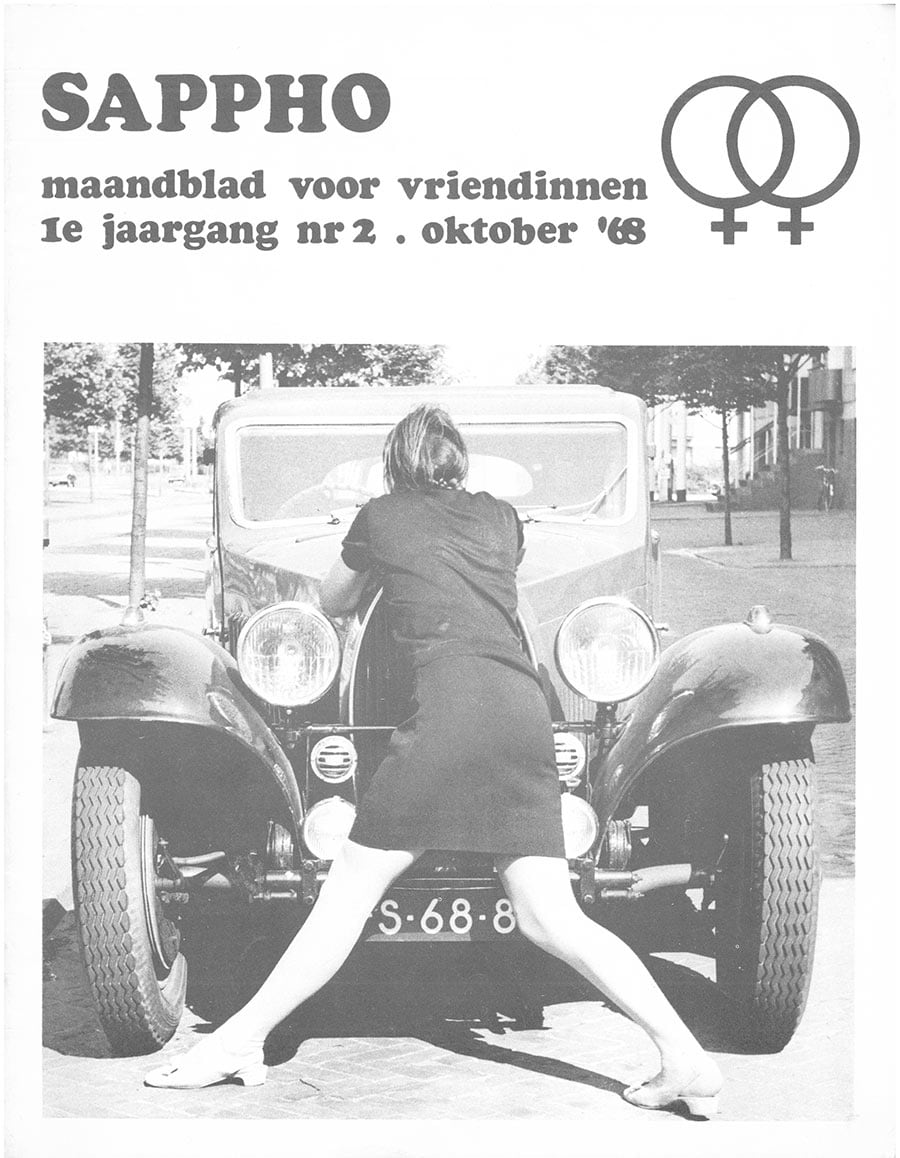
Sappho, Maanblad vor vriendinnen, nr.1, Oct 1968, IHLIA LGBTI Heritage Collection
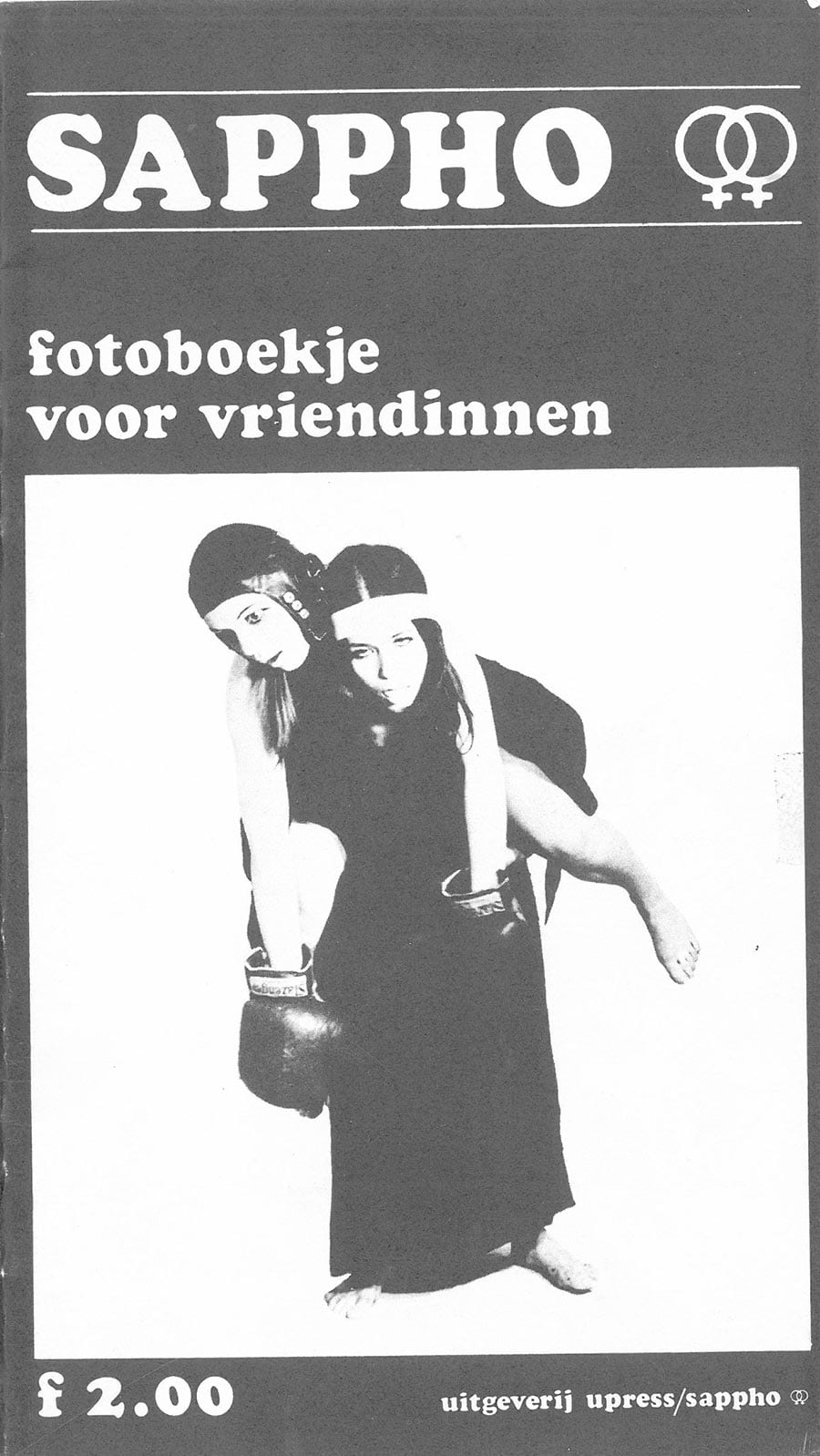
Sappho, fotoboekje voor vriendinnen, uitgeverij upress/sappho, 197?, IHLIA LGBTI Heritage Collection
Paarse September
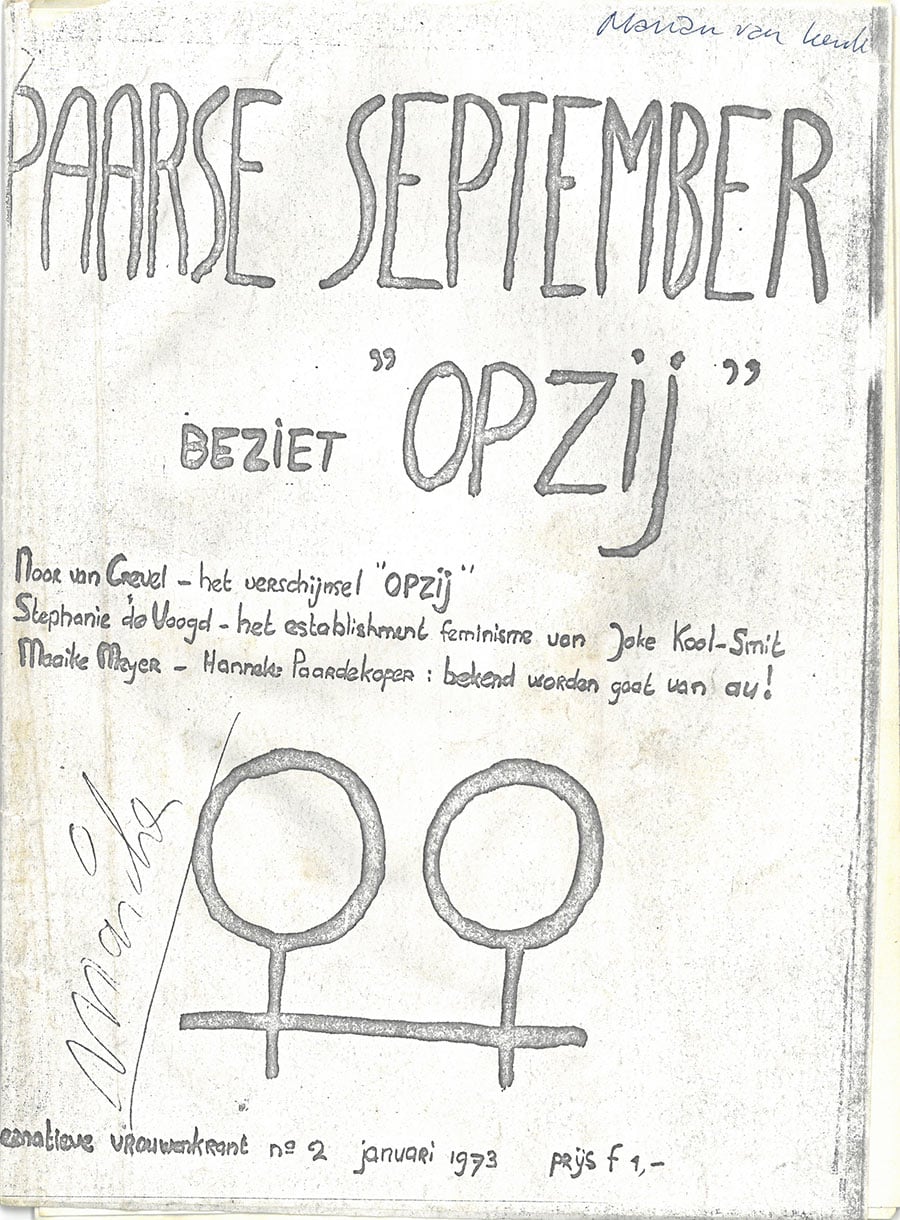
Paarse September, n.2, Jan 1973, IHLIA LGBTI Heritage Collection
Most of the information are from (Van Vught, 2020), completed by my own findings at Atria and IHLIA. As the rest of this website, this list shows a state of research and is therefore not final or exhaustive.
| An Dekker | Amsterdam | 1986–? |
| Atalanta | Utrecht | 1980– |
| De Bonte Was | Amsterdam | 1973–1986 |
| Furie | Nijmegen | 1984–1997 |
| Sara | Amsterdam | 1976–1987 |
| VIDA | Groningen | ? |
| Vijfsprong | Deventer | 1982–1996 |
| Vrouw Holle | Utrecht | 1980–? |
| De Brandweervrouw | Amsterdam | 1982–? |
| De Doordrukster | Den Bosch | 1982–? |
| De Dwarse Prinses | Amsterdam | 1981–? |
| De Kloof | Amsterdam | ? |
| De Ziedende Zeef | Nijmegen | 1982?–? |
| Hysterica | Alkmaar | 1984–? |
| Iris | Culembourg | 1983–? |
| Las Muchachas | Amsterdam | 1983–1992 |
| Oma Druck | Nijmegen | 1981–? |
| Per Zet | Haarlem | ? |
| Sapphistry | Leeuwarden | 1982–? |
| Sidonia | Groningen | 1981–? |
| VIDA | Groningen | ? |
| Virginia | Amsterdam | 1978–? |
| Adehkaka | Arnhem | ? |
| Aradia | Gouda | 1983–? |
| Boekennel | Eidhoven | ? |
| Brood en Rozen | Dordrecht | 1975–? |
| De Feeks | Nijmegen | 1977–? |
| Dikke Trui | Groningen | 1979–? |
| Emma | Rotterdam | 1979–? |
| Heksenkelder | Utrecht | 1975–1984 |
| Helleveeg | Arnhem | 1982–1996 |
| Ka | Hoorn | ? |
| Sappho | Leeuwarden | 1979–? |
| Savannah Bay | Utrecht | 1984–? |
| Shikasta | Wageningen | 1981–? |
| Singel 302 | Amsterdam | 1984–? |
| Trix | Den Haag | ? |
| Xantippe | Amsterdam | 1974–1997 1997– |
| 't Wicht | Enschede | 1985–? |
| Amarant (before: Baal) | Amsterdam | 1971–? |
| Amsterdamse Vrouwenkrant | Amsterdam | 1972–? |
| Ashanti: Surinaamse Vrouwenkrant | ? | 1980–? |
| Belletrien (published by VIDA) | Groningen | 1984 |
| De Furie | Bijlmer | ? |
| Diva | ? | ? |
| Dolleminablad | Amsterdam | ? |
| Kadinlarin Birligi: Turkse vrouwenkrant | Amsterdam | 1979–? |
| Katijf | Amsterdam | 1981–? |
| LOVER | Nijmegen | 1973–? |
| Lust & Gratie | Utrecht | 1983–2001 |
| L'exes (published by Xantippe and Saarein) | Amsterdam | 1981–? |
| Nemesis | Nijmegen | 1984–? |
| Opzij | ? | 1972–? |
| Paarse September | Amsterdam | 1972–? |
| Rooie Vrouw | ? | ? |
| Serperntine | Amsterdam | 1987–? |
| Surplus | Amsterdam | 1987–? |
| Vrouwenkrant Brabant | Tilburg | 1984–? |
| Vrouwenkrant Rosa | Den Bosch | 1977–? |
| Vrouwentongen: Nijmeegse vrouwenkrant | Nijmegen | 1977–? |
| Zwarte Oester (also: Zwarte tarantula, Zwarte wiev’s, Zwarte kat, Zwarte kring, Zwarte ijsberin, Zwarte ballon, Zwarte ketel) | ? | ? |
| Umoja (before: Zwarte – Vrouwenkrant) | Arnhem | 1985–? |
Biblia pauperum
Biblia pauperum, a Latin term for “pauper’s Bible”—Bible of the poor— refers to block books created in medieval Europe, typically in the 14th and 15th centuries, which visualized the correspondences between the Old and New Testaments. They consisted mainly of a series of illustrations, often accompanied by short explanatory texts written in vernacular languages. This popular format, that could be compared to contemporary comics, was used by the minor clergy as a visual help for prayers and reflections. (“Biblia Pauperum.,” n.d.)
Book History
Book history is an interdisciplinary field of study at the crossroad
of textual scholarship, codicology, bibliography, philology,
palaeography, art history, social history and cultural history, that
began to be recognized as an academic discipline in the 1980s.
A pioneering scholar of this field is Robert Darnton, an American
historian who wrote extensively on the history of books and reading in
France and Europe during the modern era, and defined his discipline as
“the social and cultural history of communication by print”. In his
essay What is the History of Books? (1982), he develops a model
that will become foundational within the field, a “communication
circuit” comprising six links forming a dynamic loop; author - publisher
– printer – shipper – seller – reader. By considering the full scope of
this circuit, he encourages scholars to examine the book as an object
and a cultural artifact, by analyzing both its material aspects and its
social, economical and cultural significance in a transnational context.
(Davidjgary, 2013)
Edit-a-thon
An edit-a-thon (or “editathon”) is an event, or a series of events, during which people work together—online or in person—to edit, improve, expand, or create wiki entries. They can be organized in very structured or very informal ways, around a wide range of themes and topics—women’s history, environmental issues, vernacular cultures and histories—and generally about subjects that are underrepresented on the platform. (Edit-a-thon, 2022)
Herstory
Herstory [from her + story] is a term coined by U.-S. feminist activists during the 1970s, to designate a version of history written from a feminist perspective, often with a focus on the experiences, contributions and achievement of women, which are usually overlooked in traditional historical accounts. Herstory is thus contrasted with history, which although derived from the Greek and Latin historia, and not the contraction of his + story, is inherently male-centered. (Colman, 2008)
Intersectionnality
“The term ‘intersectionality’ has its roots in Black feminist
activism, and was originally coined by American critical legal race
scholar Kimberlé Williams Crenshaw in 1989. Crenshaw used the term
intersectionality to refer to the double discrimination of racism and
sexism faced by Black women, critiquing the ‘single-axis framework that
is dominant in antidiscrimination law.. feminist theory and anti-racist
politics’ for its focus on the experiences of the most privileged
members of subordinate groups. (…)
Crenshaw provided the following definition of intersectionality:
‘Intersectionality is a metaphor for understanding the ways that
multiple forms of inequality or disadvantage sometimes compound
themselves and create obstacles that often are not understood among
conventional ways of thinking.’” (“Using Intersectionality to
Understand Structural Inequality in Scotland: Evidence Synthesis”,
2022)
Matrix of domination
The matrix of domination, resonating with Kimberlé Crenshaw’s concept of intersectionality, is coined by Patricia Collins in Black Feminist Thought: Knowledge, Consciousness, and the Politics of Empowerment (1990), to show how societal power relations are organized by four interconnected domains (structural, hegemonic, disciplinary and interpersonal domains). She thus explains how capitalism, white supremacy and heteropatriarchy are interlocking systems of oppression, which are experienced simultaneously by the individuals who exist at their intersections, connecting (among other), race, gender, class, sexuality or religion. (Collins, 1990 ; Costanza-Chock, 2008)
Mimeograph
“A mimeograph, also called stencil duplicator, was a printing machine used in the mid-20th century to produce copies of documents or images. It worked by using a stencil, which was placed on a rotating drum, to transfer ink onto paper. The machine was manually operated, with the operator cranking the drum to create the copies. Mimeographs were commonly used in schools and businesses before modern photocopiers became widely available.” (“Mimeograph | printing technology”, n.d.)
Risograph
The Risograph (or riso-duplicator), is a low-cost, high-volume and high-speed printer. Released in Japan in 1980 by the Riso Kagaku Corporation, it was initially intended for offices, schools, churches and political parties, and will later know a resurgence in activist and artistic circles, due to its affordability, as well as its bold and textured colours. The underlying technology is close to the mimeograph, and uses a digitally produced stencil, through which ink is pushed. (What Is a Risograph?, n.d.)
Samizdat
“Samizdat, (from Russian sam, “self,” and izdatelstvo, “publishing”), literature secretly written, copied, and circulated in the former Soviet Union and usually critical of practices of the Soviet government. (…) Samizdat publications expanded their focus beyond freedom of expression to a critique of many aspects of official Soviet policies and activities, including ideologies, culture, law, economic policy, historiography, and treatment of religions and ethnic minorities. Because of the government’s strict monopoly on presses, photocopiers, and other such devices, samizdat publications typically took the form of carbon copies of typewritten sheets and were passed by hand from reader to reader.” (“Samizdat | Soviet Literature,” n.d.)
Second wave feminism
“A shorthand reference for the politically active form of feminism that emerged in the US and elsewhere in the 1960s. It was neither a unified nor a homogeneous movement, but it did of course have a common goal, however disparately this was conceived, namely the equality of the sexes. It was born of the recognition that in spite of the considerable advances of the retrospectively christened First Wave of feminism, women had still not achieved genuine equality with men in every facet of life. Its starting point, in the US, was Betty Friedan's The Feminine Mystique (1963), which argues that women are trapped in a system that denies them self-identity as women and demands they find fulfilment through their husbands and children. Later writers, particularly those identifying as radical feminists, would use the term patriarchy as a shorthand for this systemic subordination of women at the level of culture itself, rather than individual men.” (“Second Wave Feminism,” n.d.)